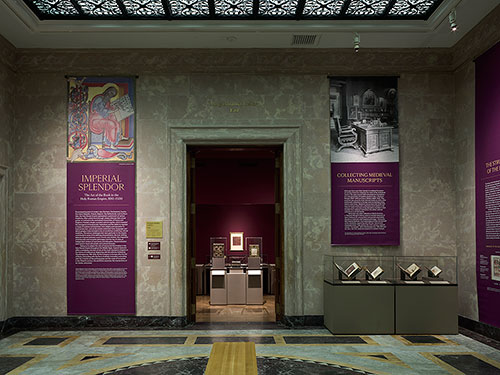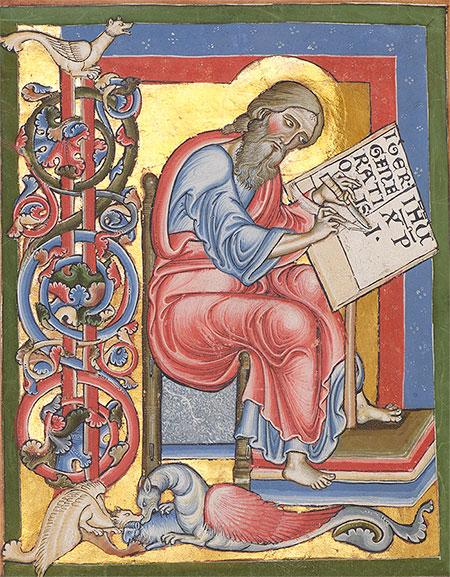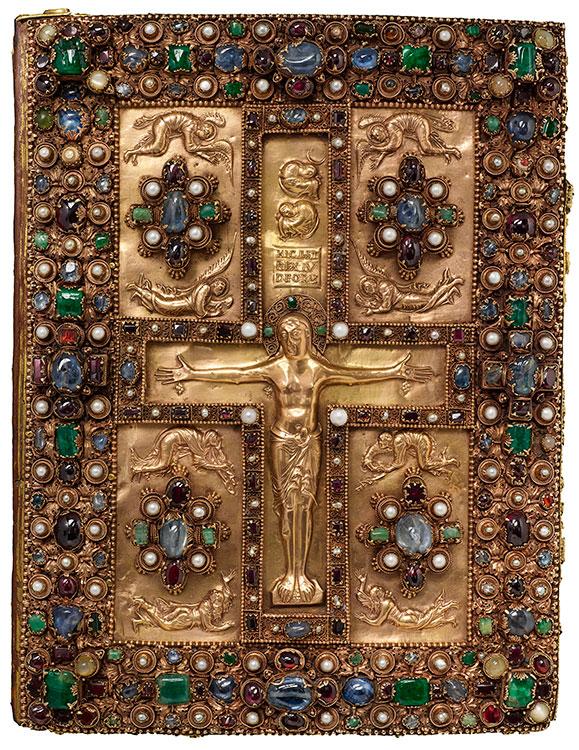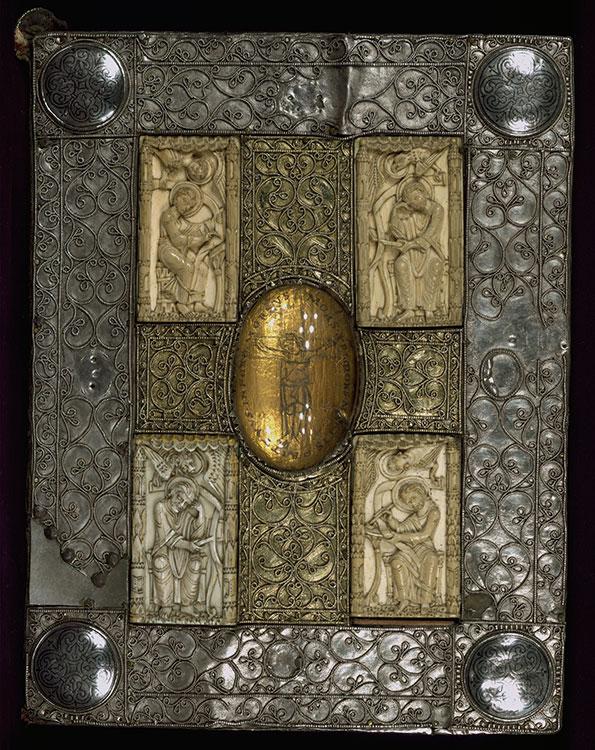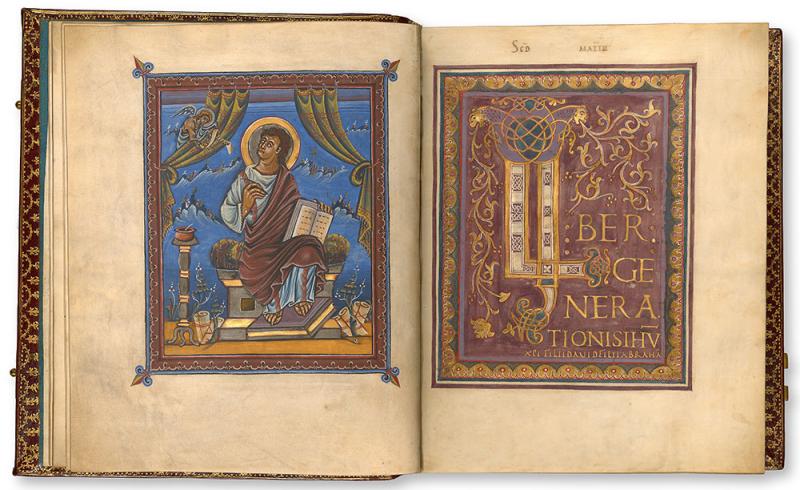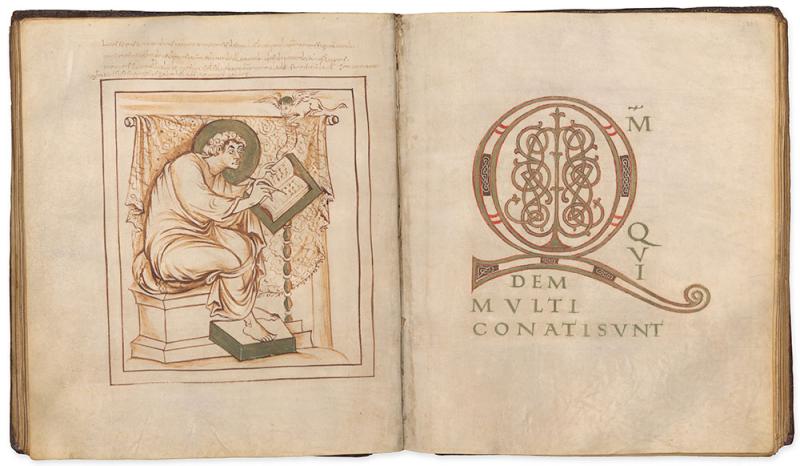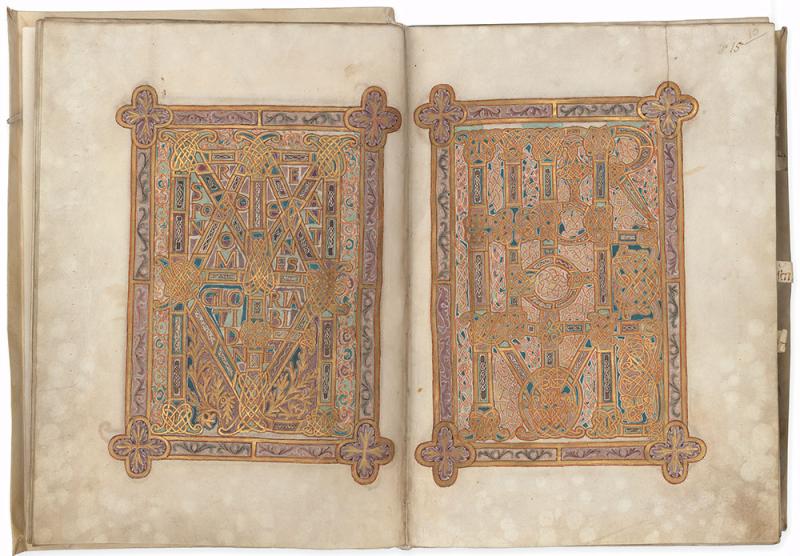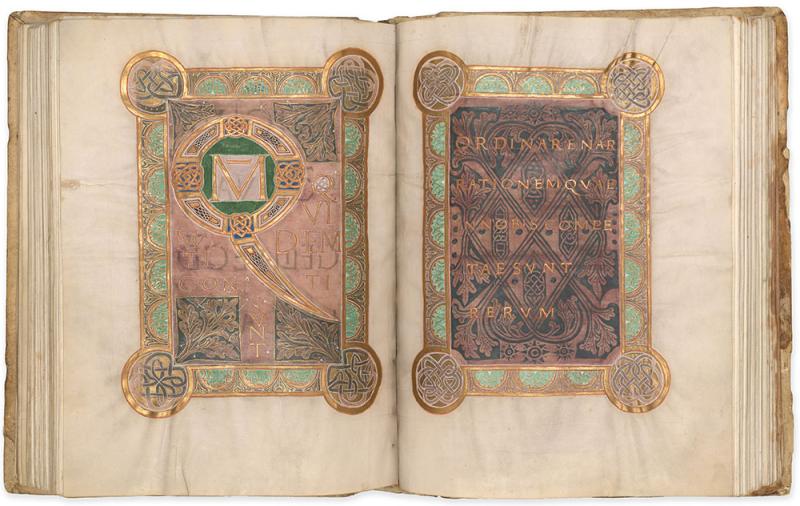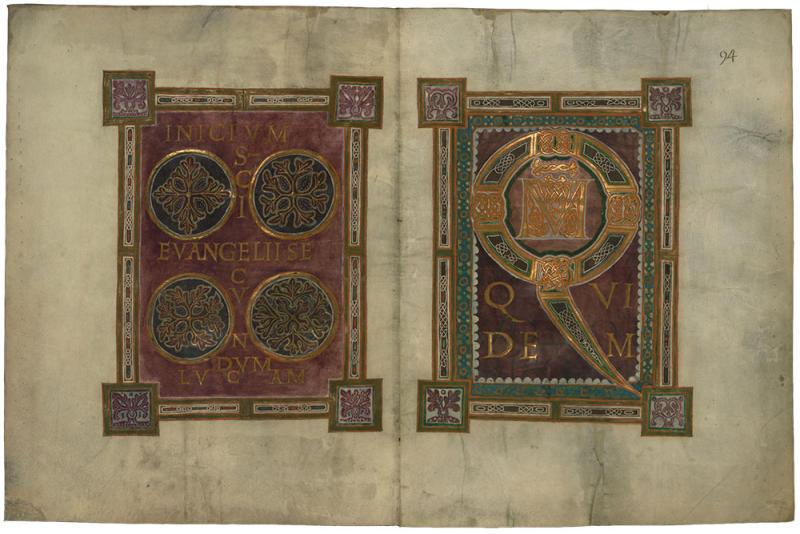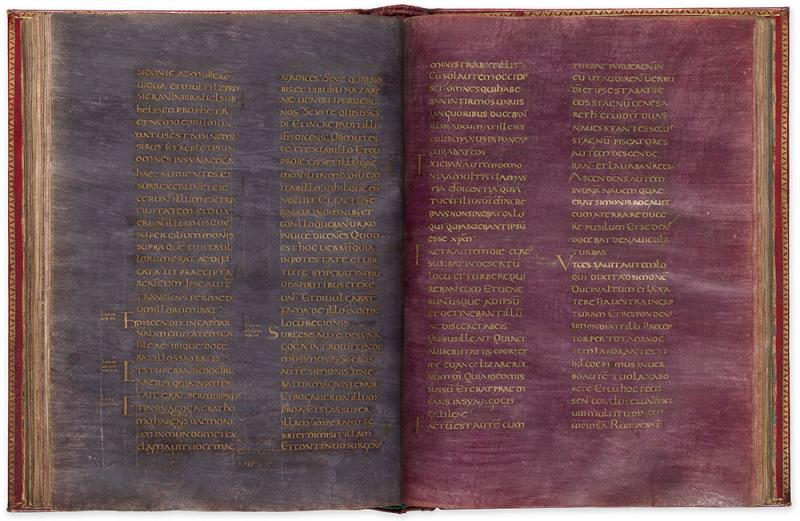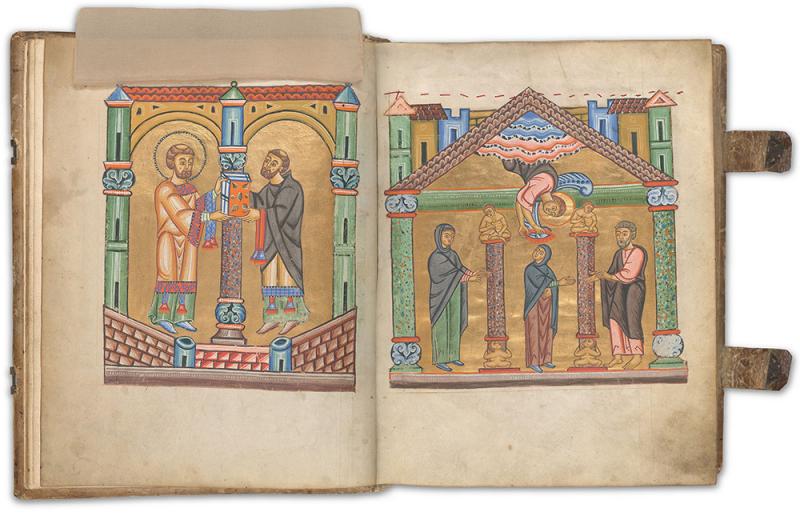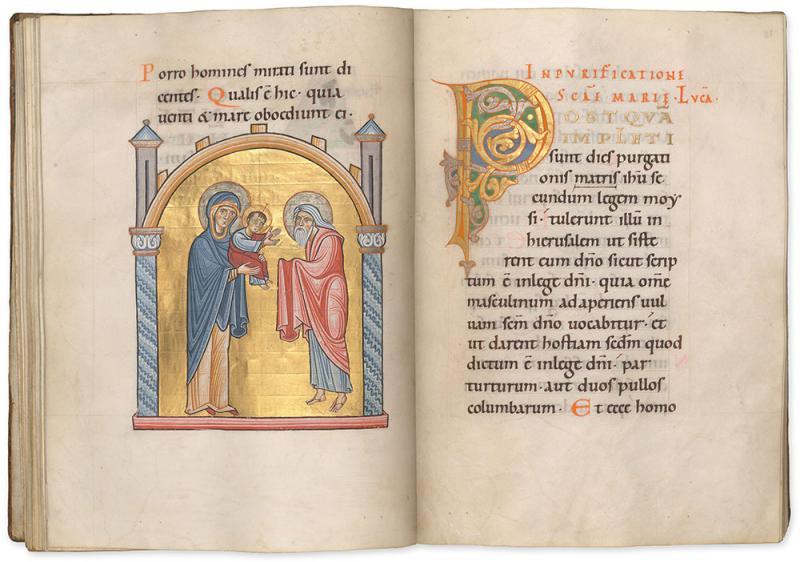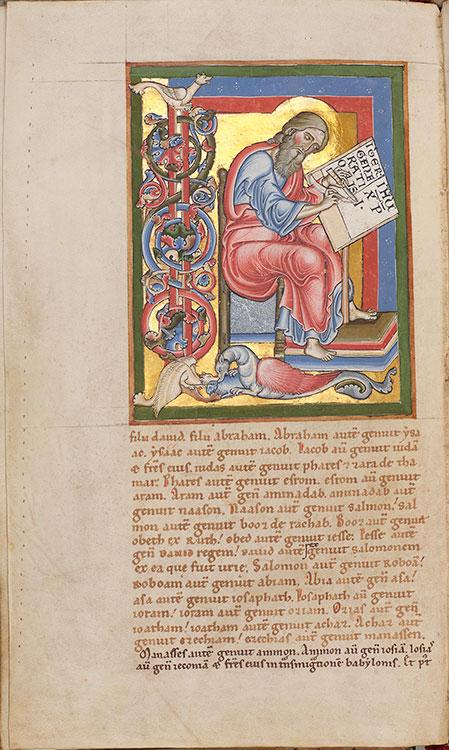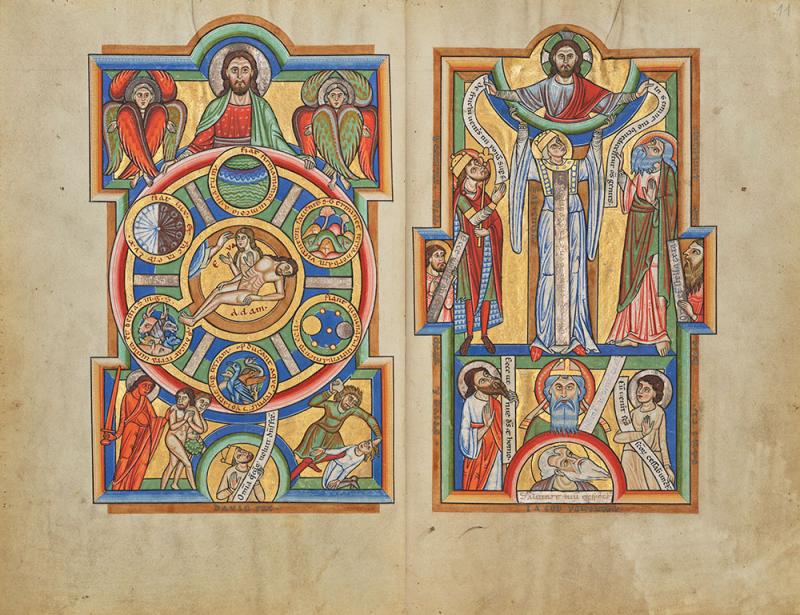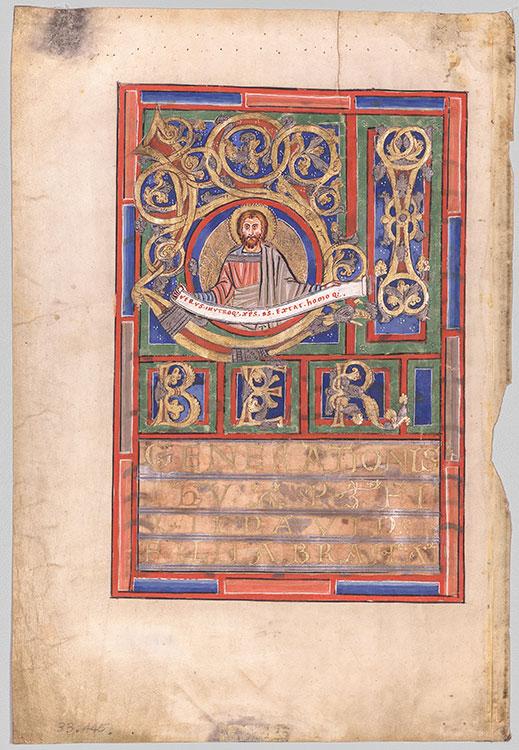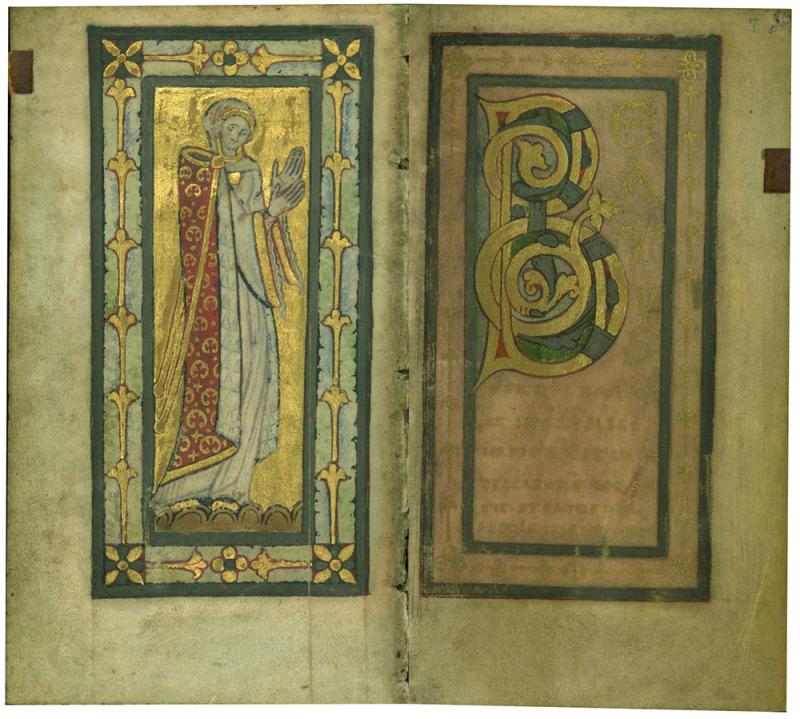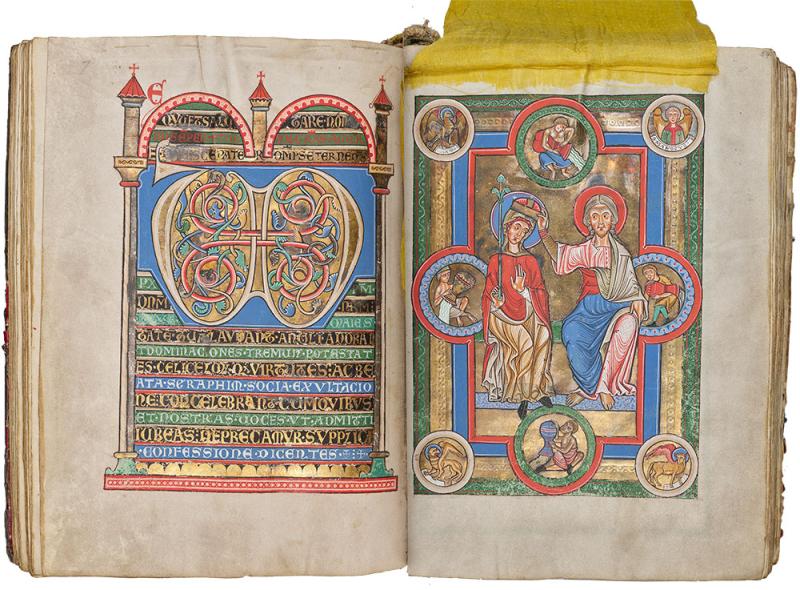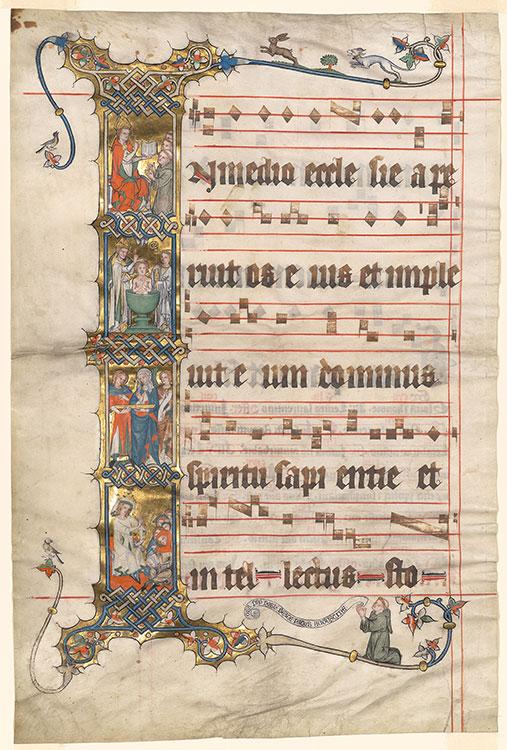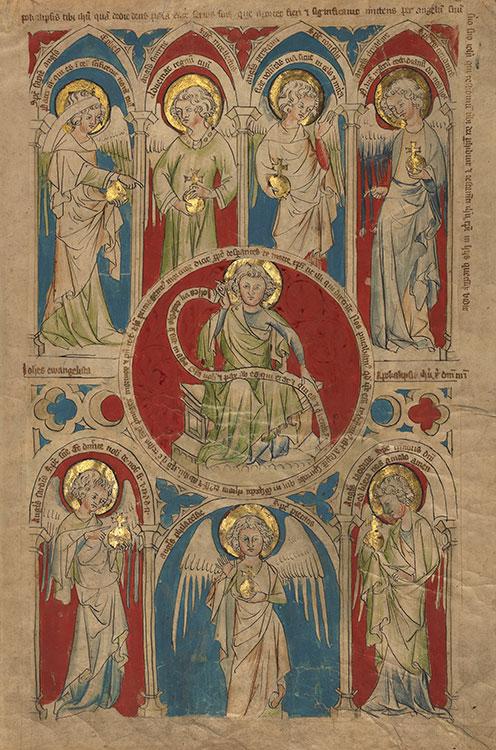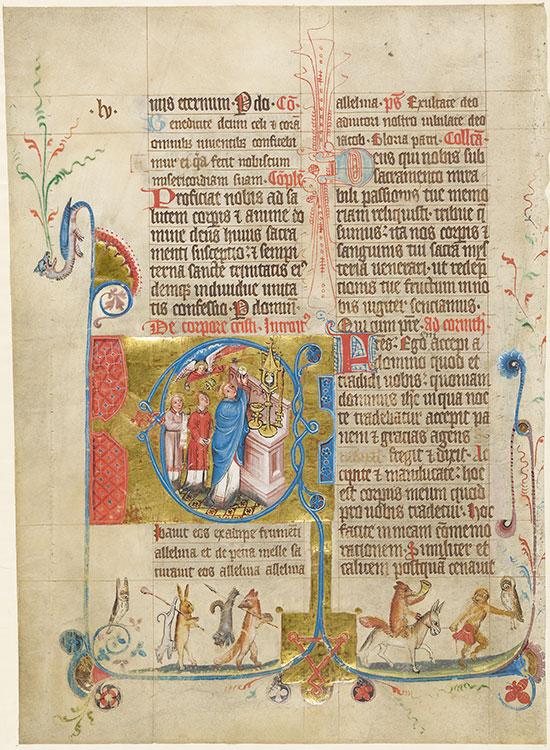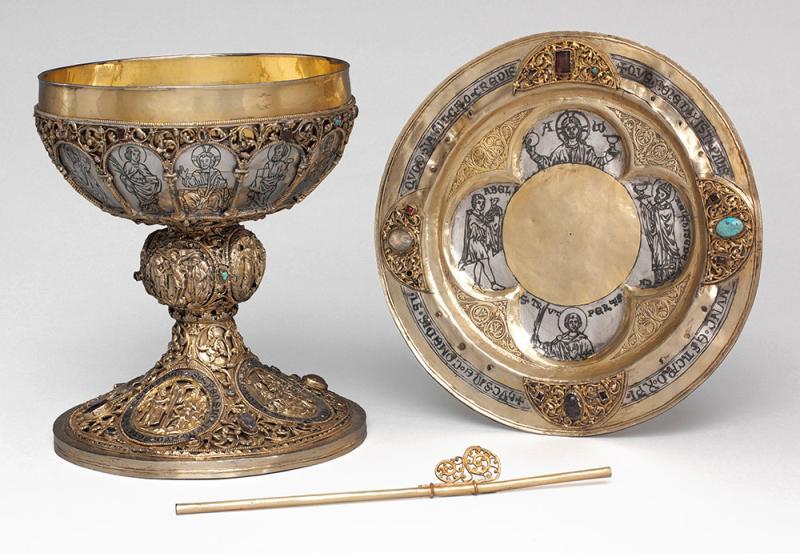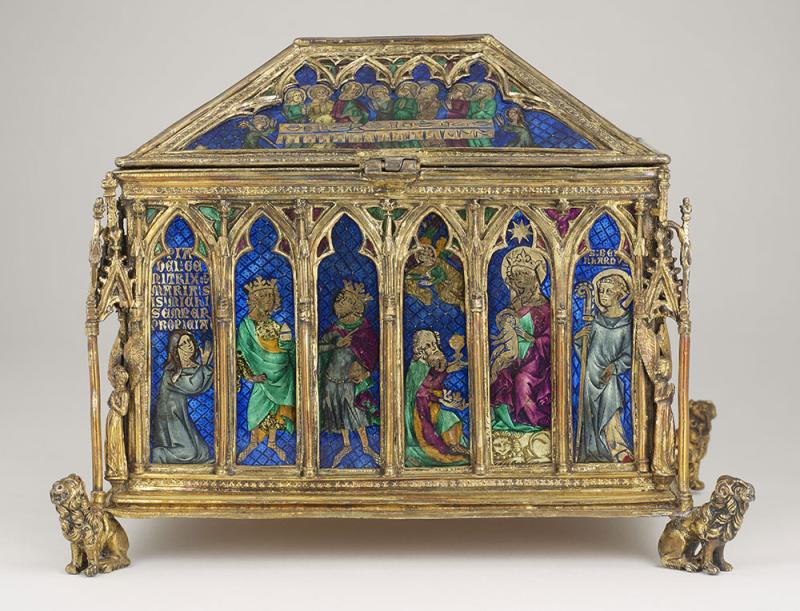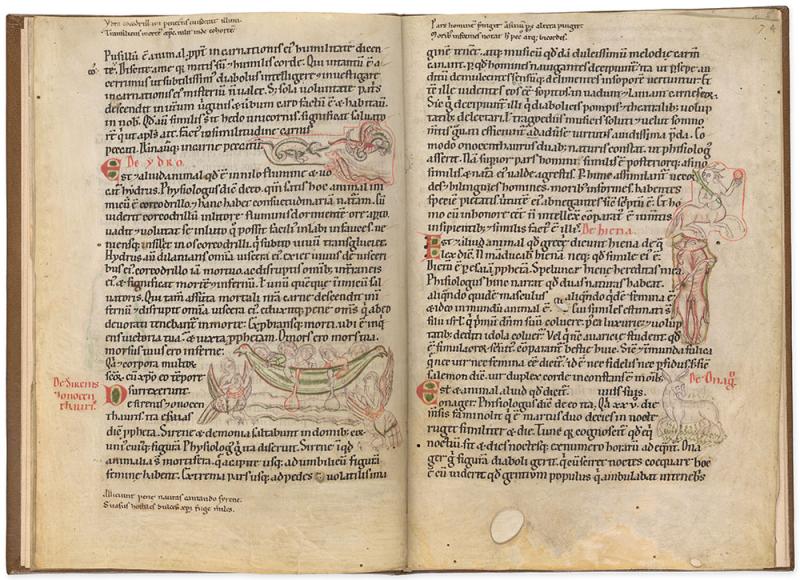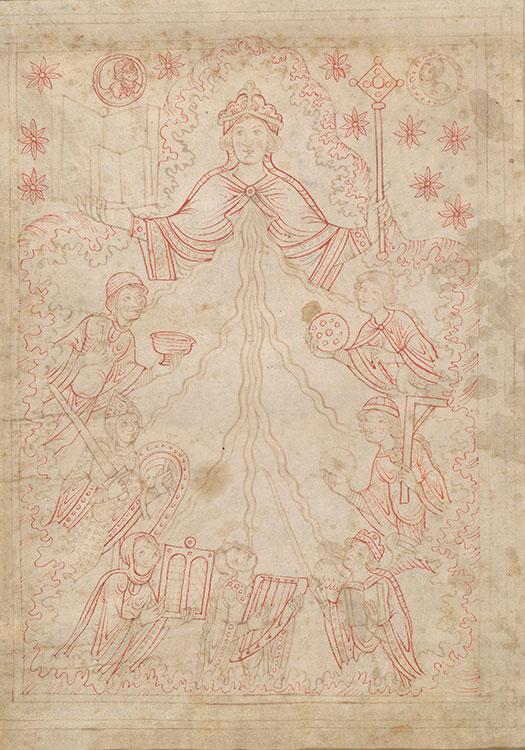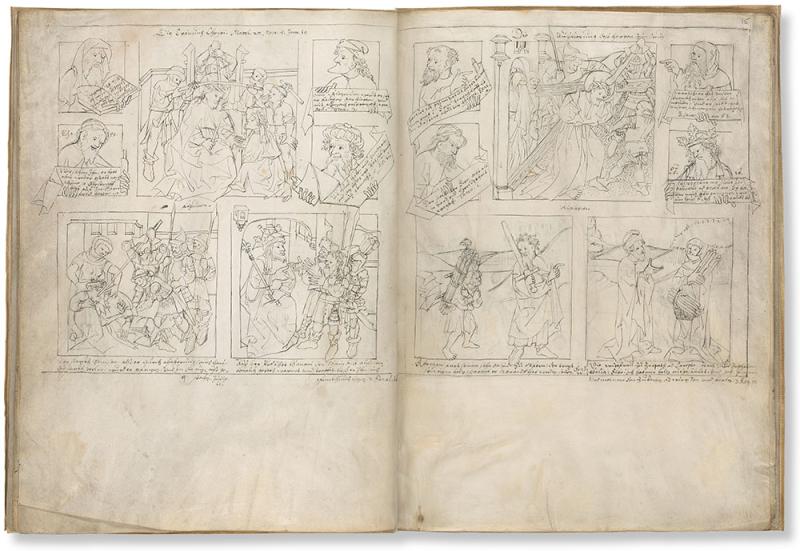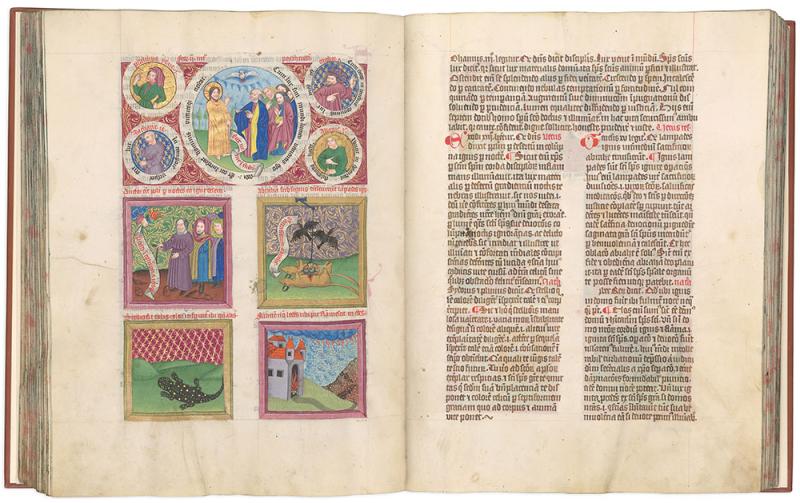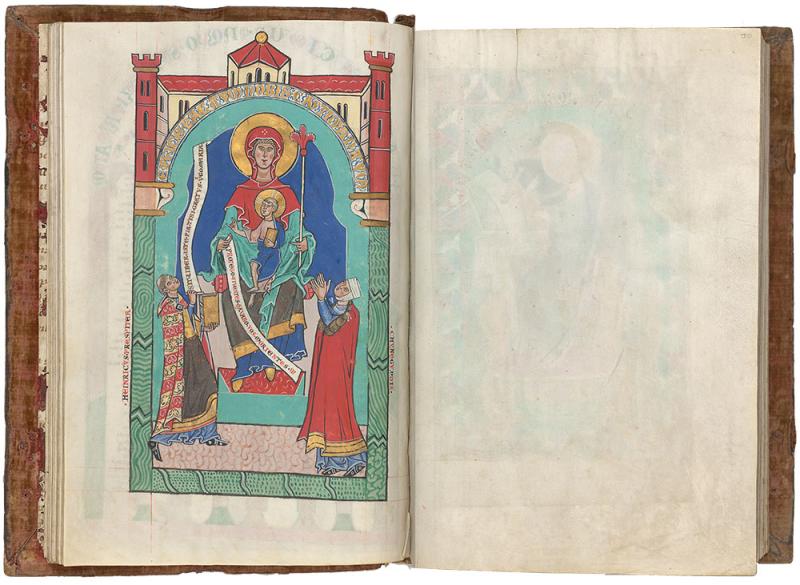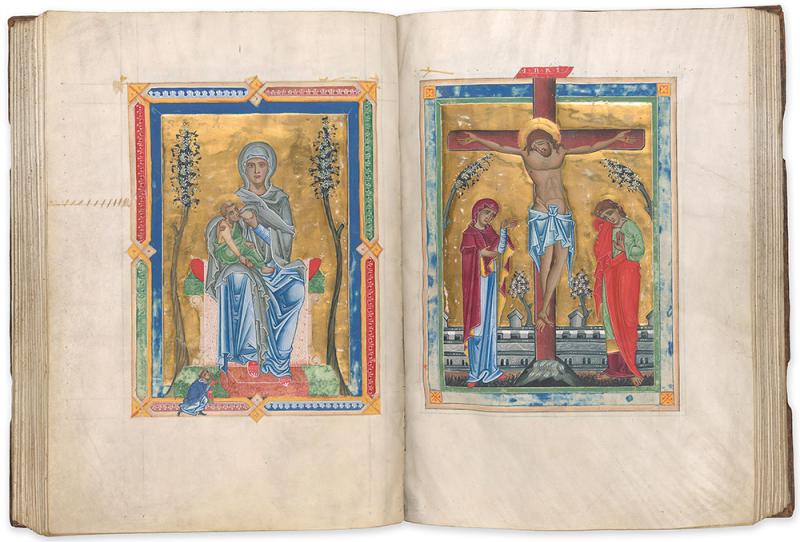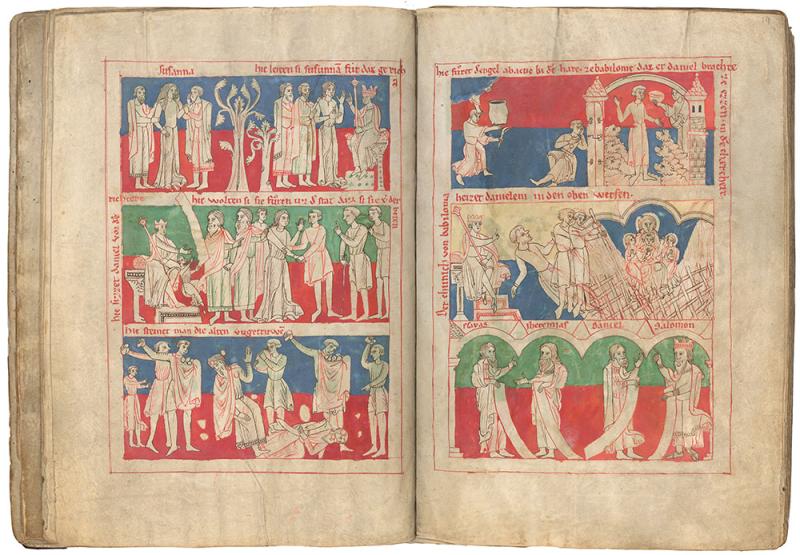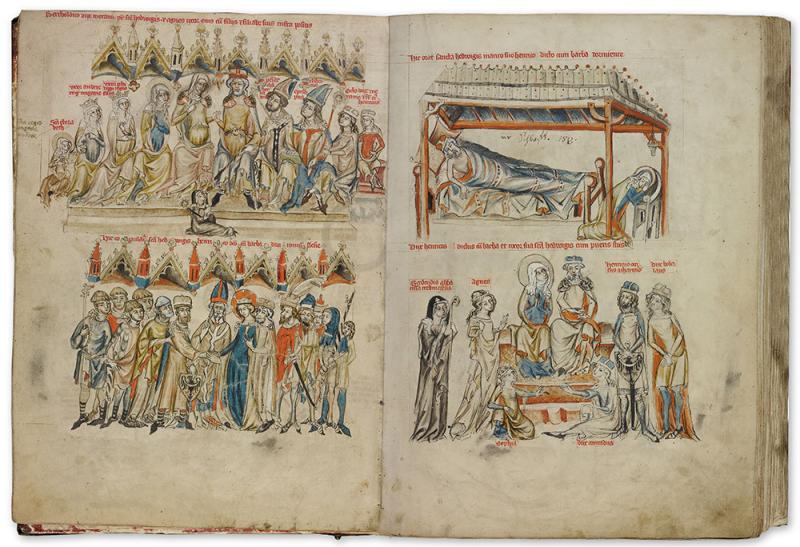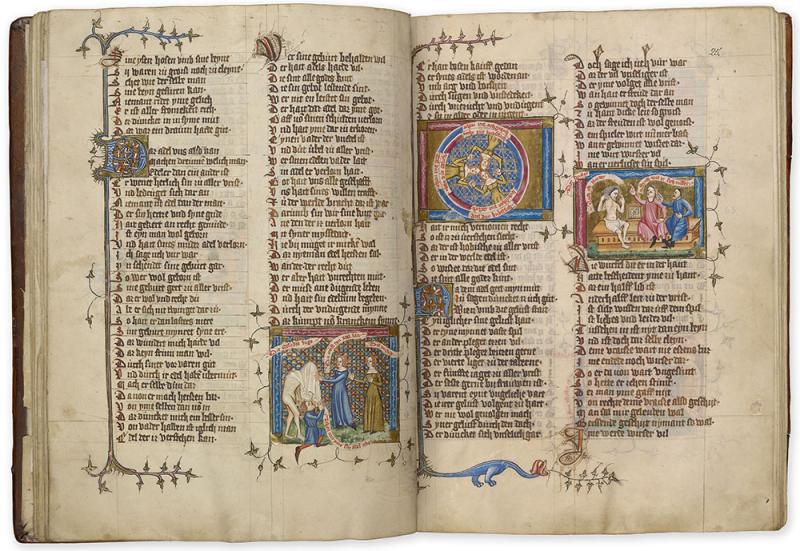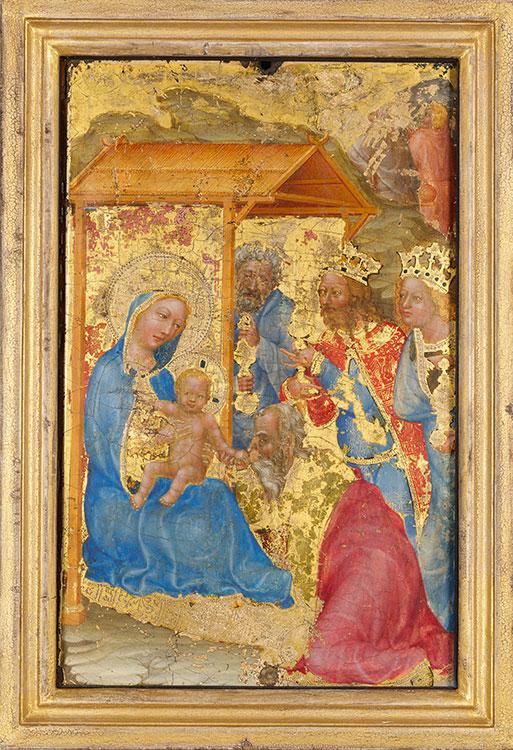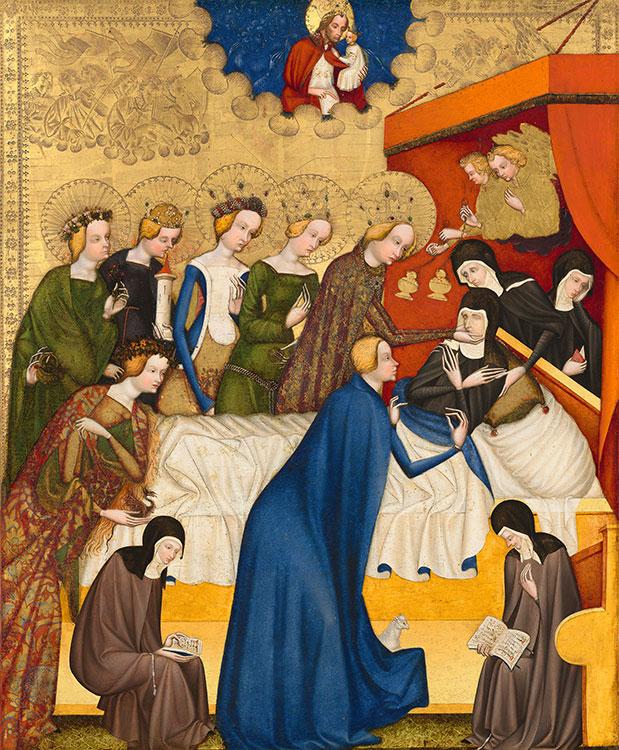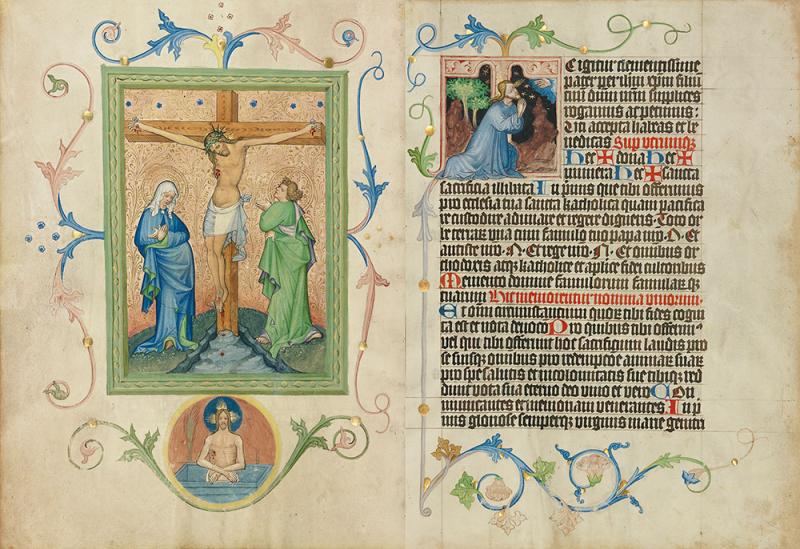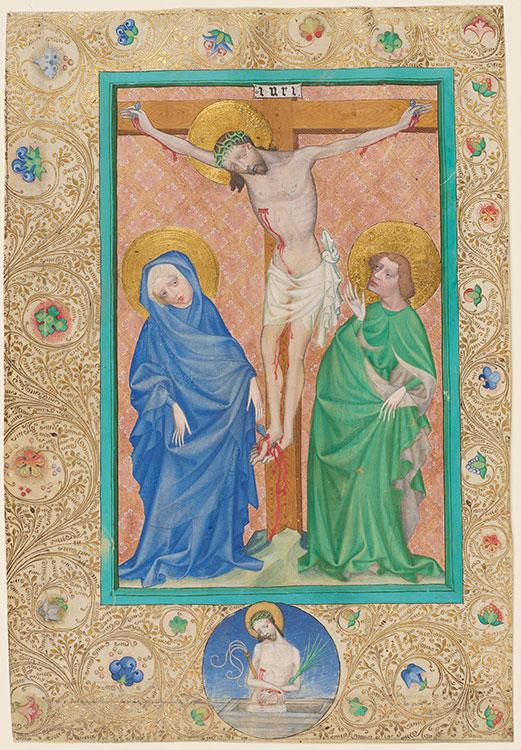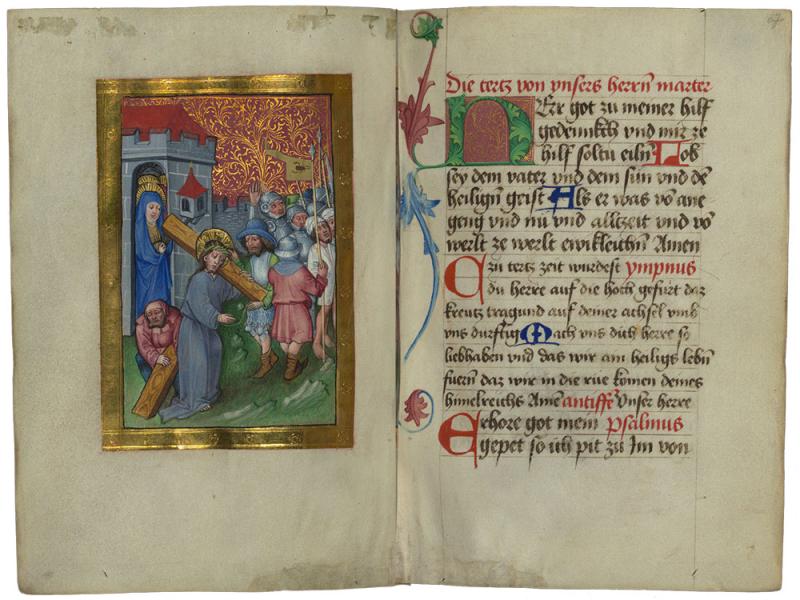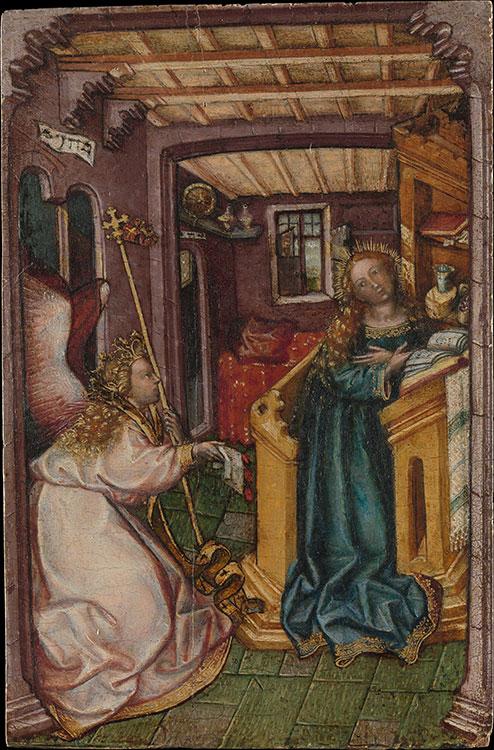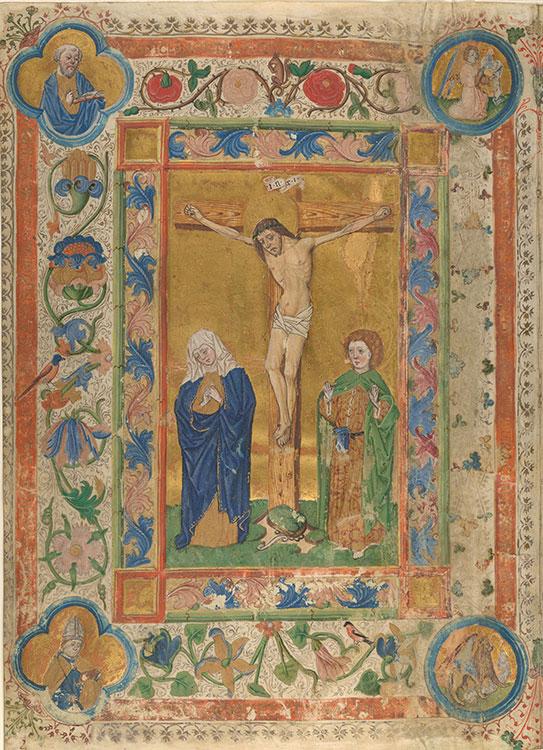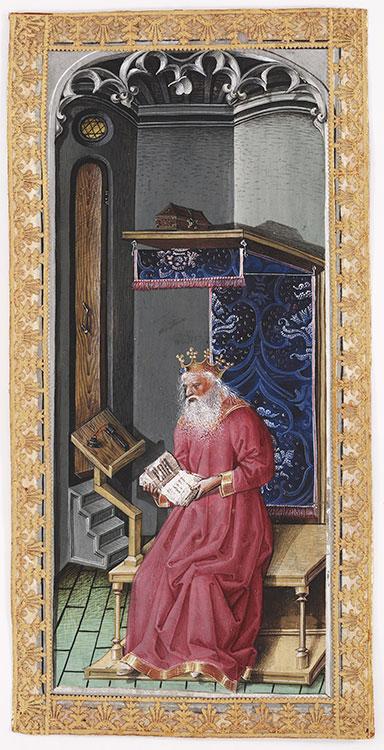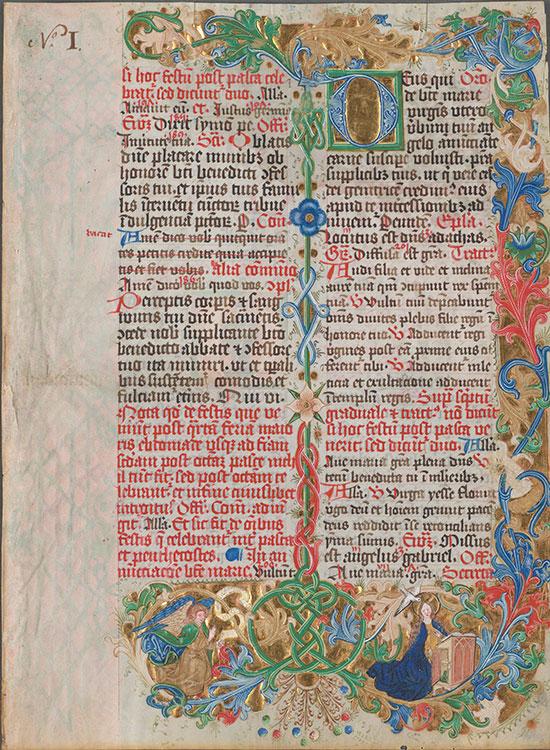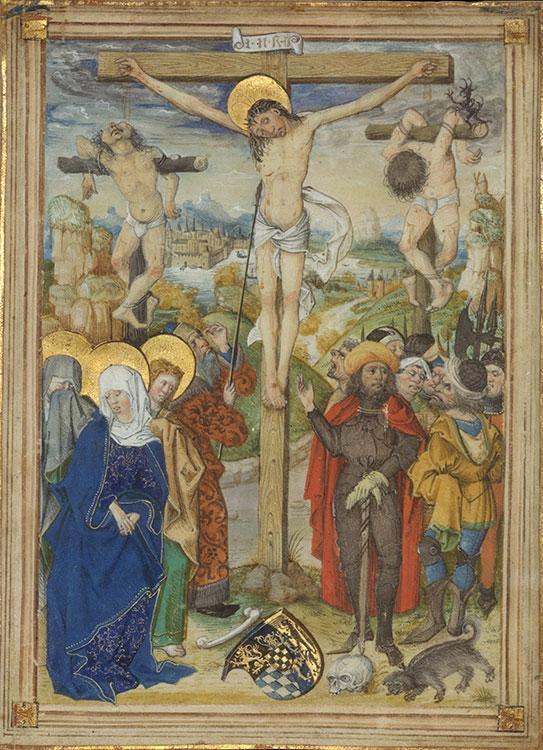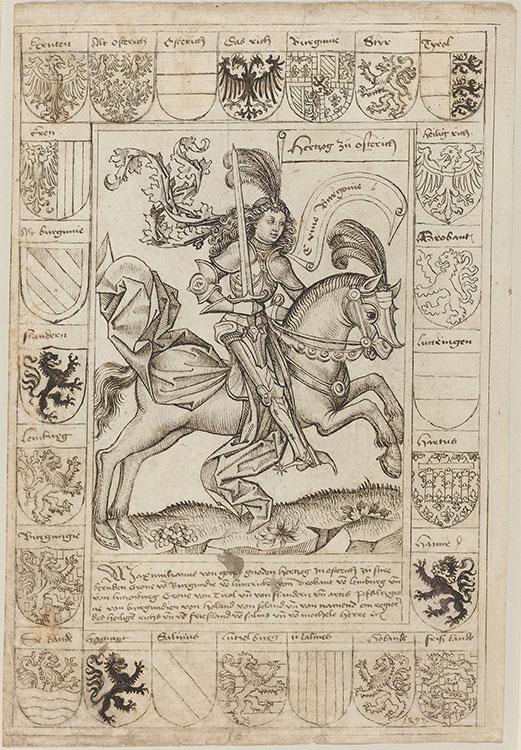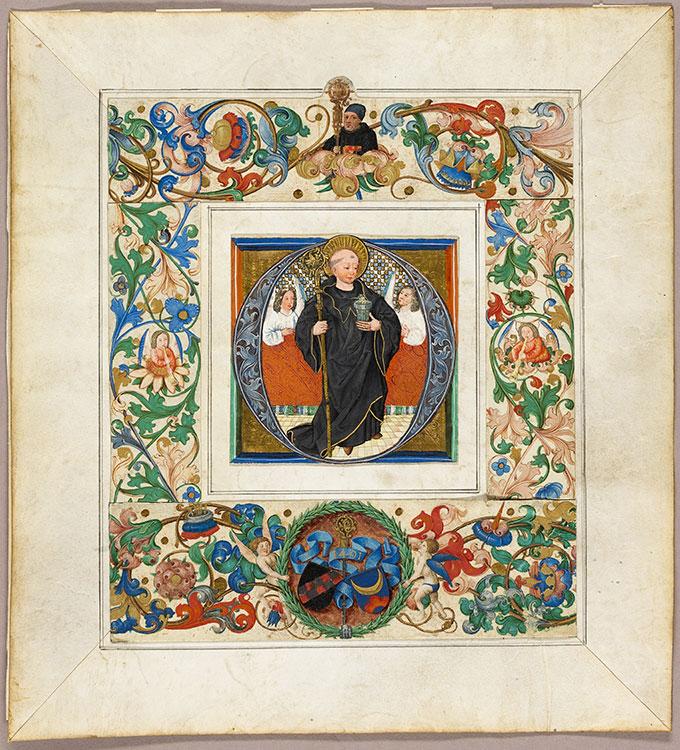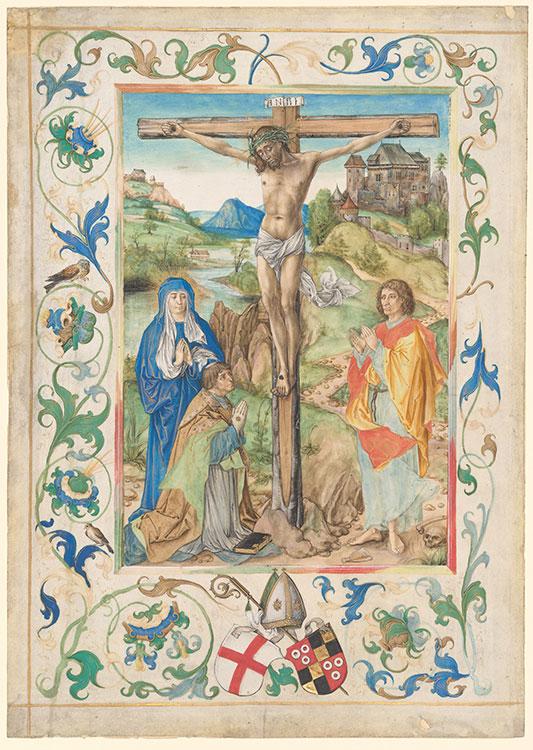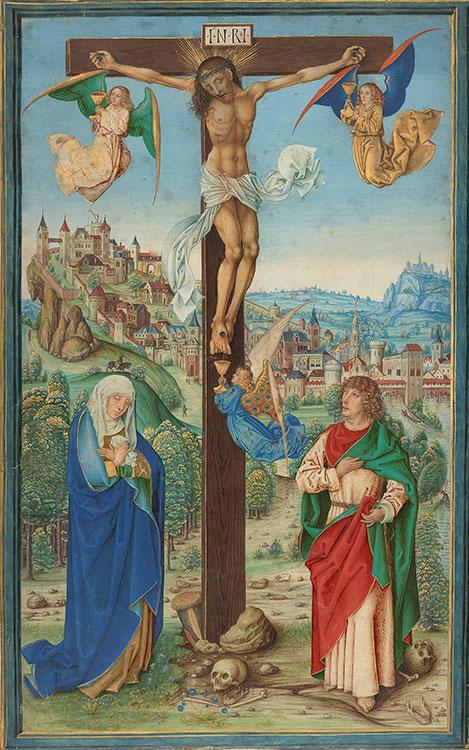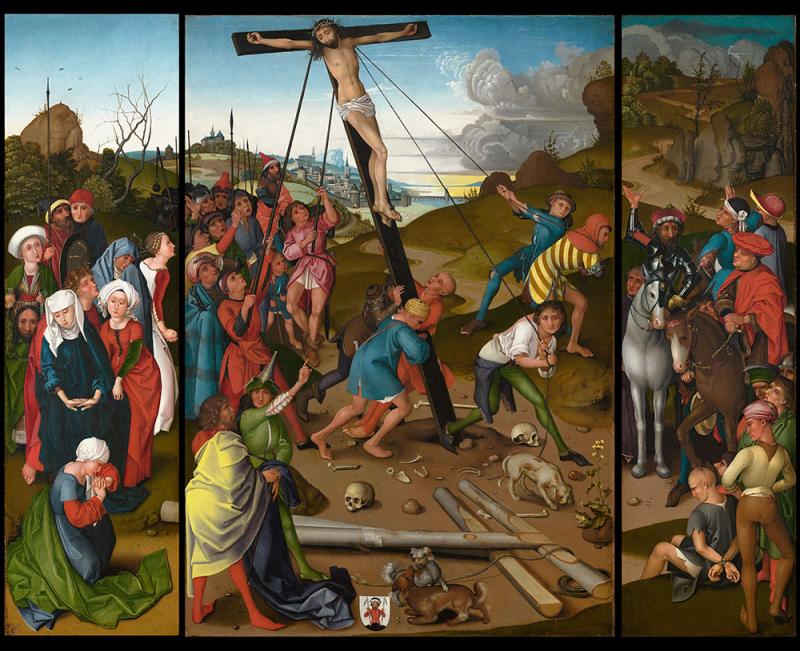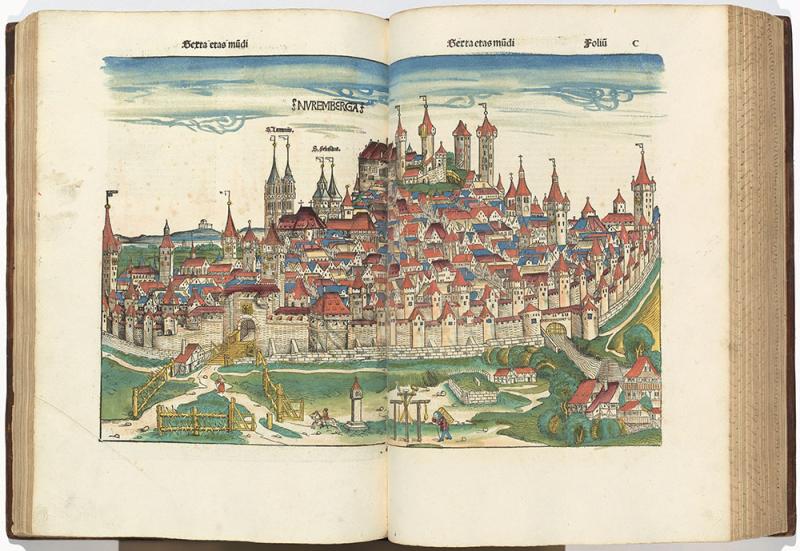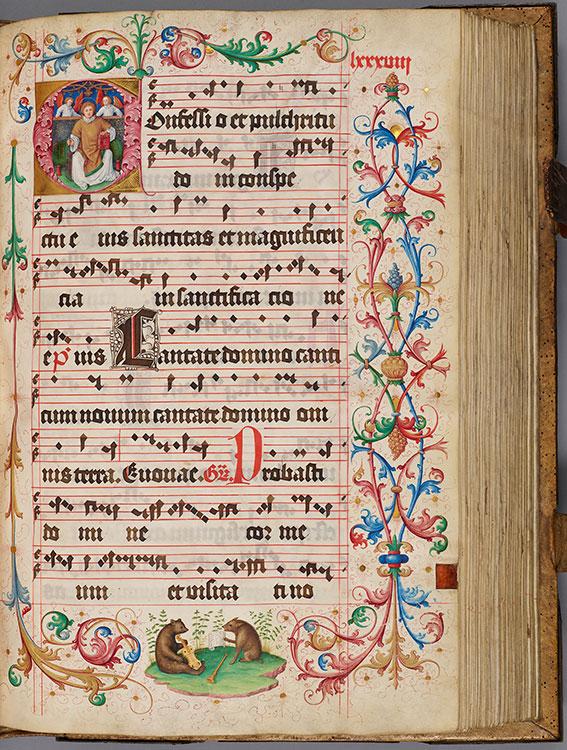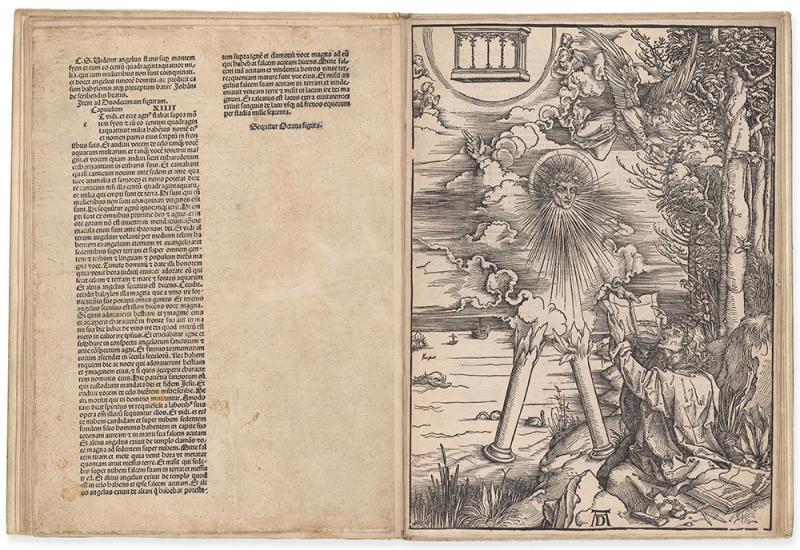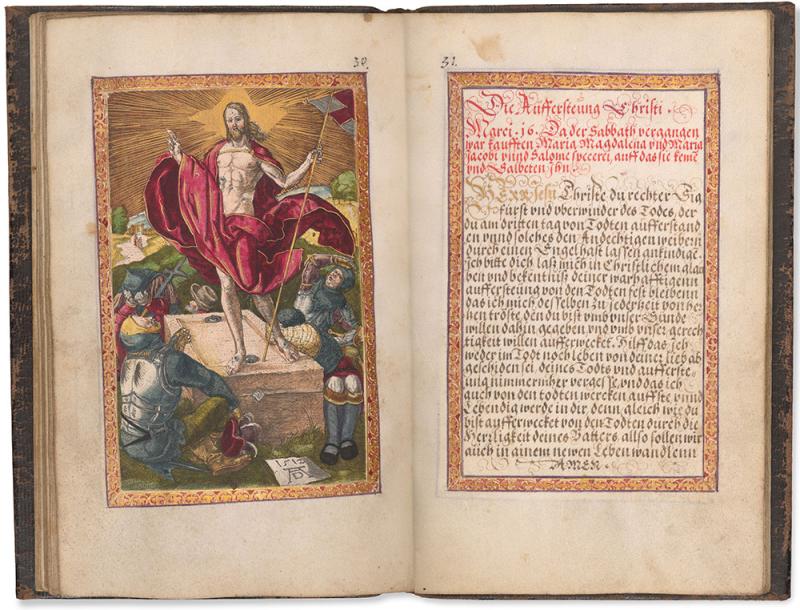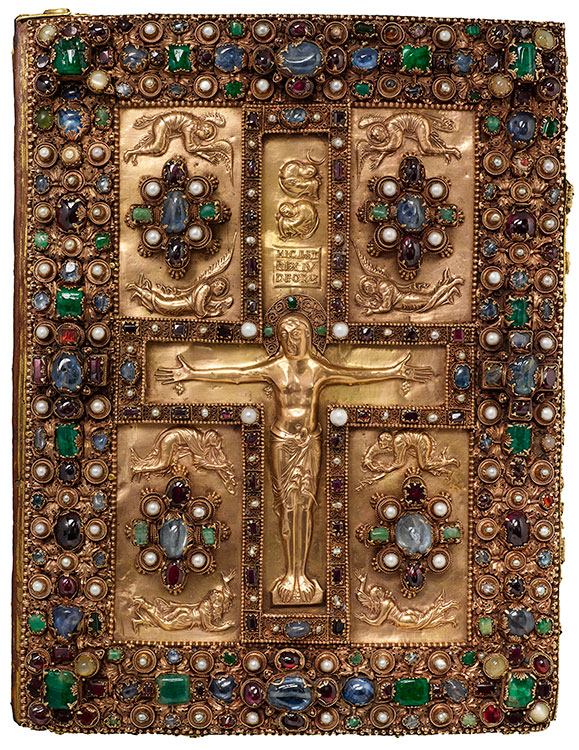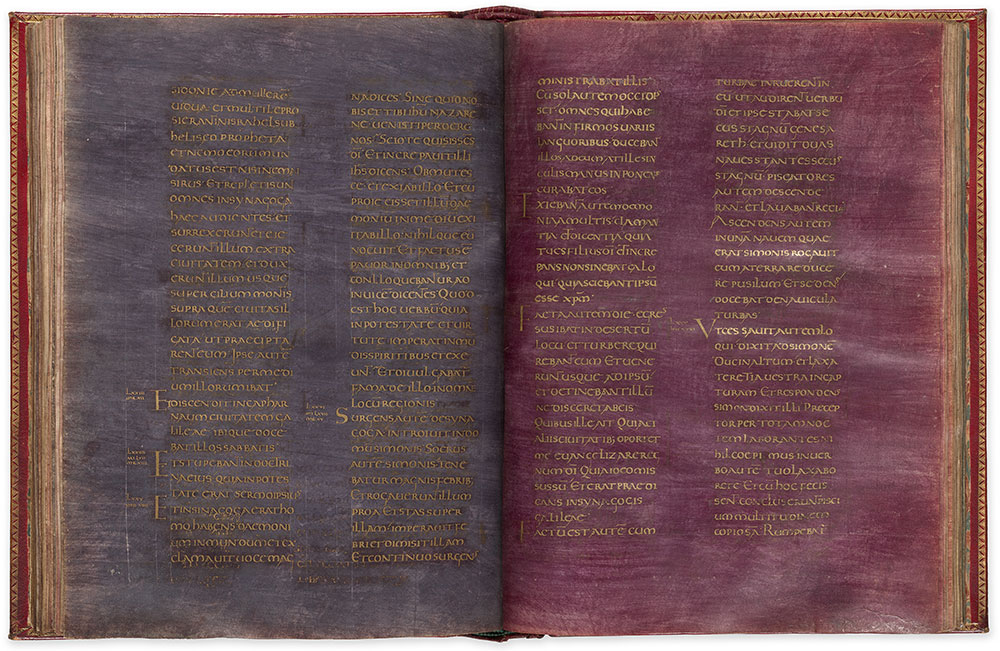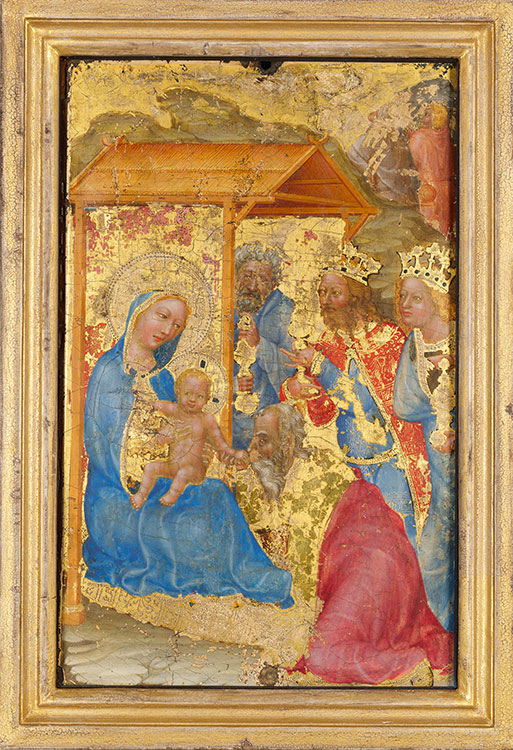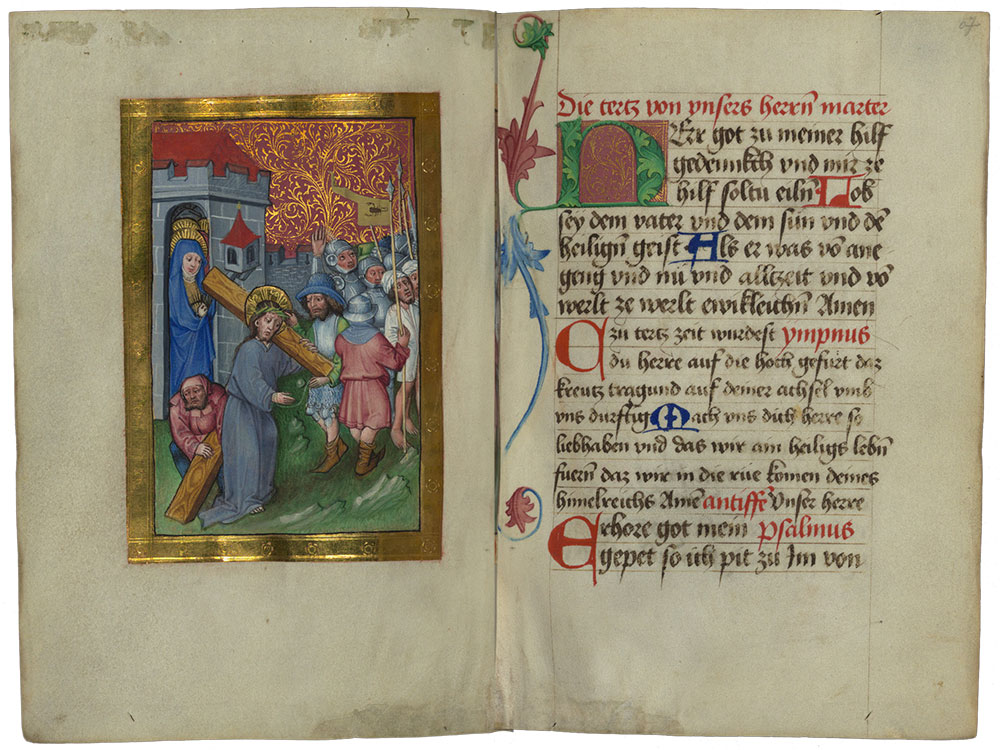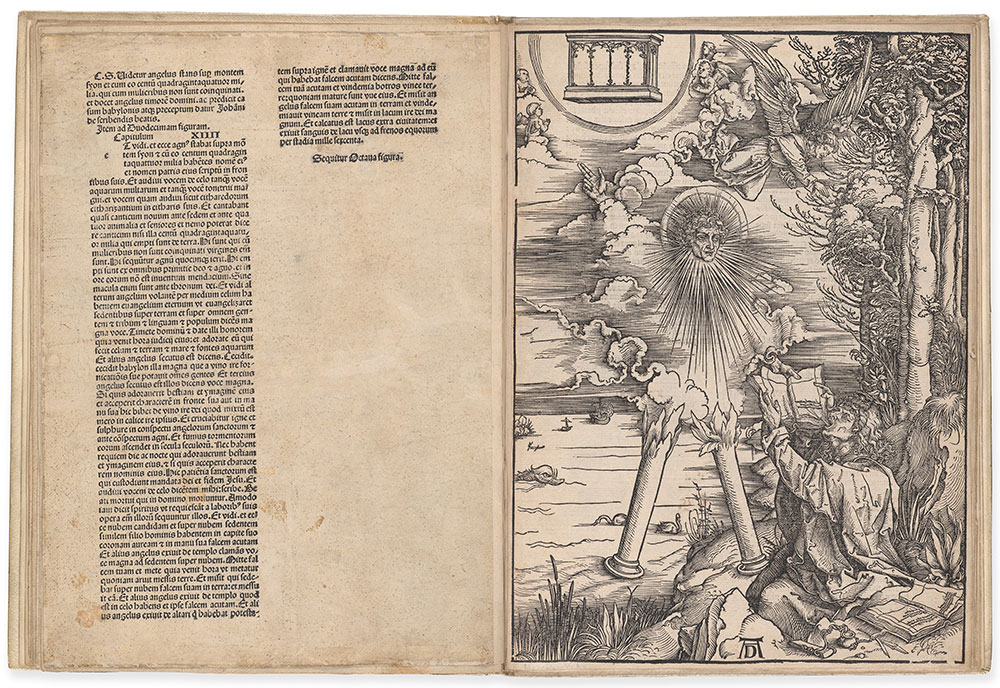Imperial Splendor: The Art of the Book in the Holy Roman Empire, ca. 800–1500
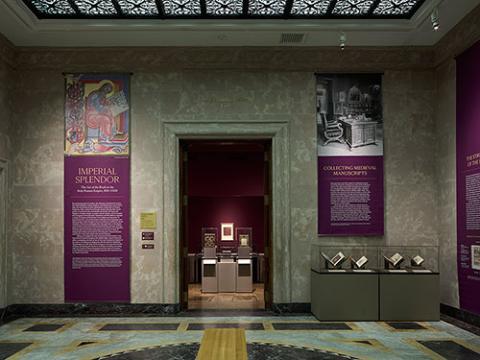
Encompassing parts of modern-day Germany, Switzerland, Austria, the Czech Republic, Poland, Belgium, the Netherlands, and northern Italy, the Holy Roman Empire represented a patchwork of various kingdoms, often united more through uneasy alliances than actual power. In contrast to the centralized monarchies of France and England, it lacked a single, constant national capital, which impeded the emergence of bureaucratic institutions and the ability to regulate a range of customs and practices, from religion and education to book production. Just as the empire embraced many languages and ethnic groups, it also included a mix of sometimes conflicting cultural traditions. The various challenges that were particular to the empire contributed to some of its defining characteristics: the ever-shifting balance of power between court, church, and cloister; the integration of aristocratic and monastic patronage; and the rise of cities as independent centers of commerce and education. Decentralization went hand in hand with artistic and cultural diversity.
Taking as its subject the role of manuscript illumination in the Holy Roman Empire throughout the Middle Ages, Imperial Splendor offers a sweeping overview of one of the most impressive chapters in the history of medieval art. Beginning with the reforms initiated by Charlemagne (ca. 748–814), the first emperor in Europe after the fall of Rome, and ending with the flurry of artistic innovation coinciding with the invention of the printing press and the onset of humanism in the fifteenth century, this exhibition examines the intersections of art, books, and power.
Imperial Splendor: The Art of the Book in the Holy Roman Empire, 800–1500 is made possible by the Janine Luke and Melvin R. Seiden Fund for Exhibitions and Publications, the Ricciardi Family Exhibition Fund, the Christian Humann Foundation, and Katharine J. Rayner. Additional support is provided by the David L. Klein Jr. Foundation; the Andrew W. Mellon Fund for Research and Publications; Caroline Sharfman Bacon; Elizabeth A. R. and Ralph S. Brown, Jr.; Mr. and Mrs. Alain Goldrach; Marguerite Steed Hoffman and Tom Lentz; Professor James H. Marrow and Dr. Emily Rose; Mrs. Andrew C. Schirrmeister; the Samuel H. Kress Foundation; Gifford Combs; Salle Vaughn; William M. Voelkle; Gregory T. Clark; Bob McCarthy; and an anonymous donor.
“Heiningen Gospels” (fragment), in Latin, Germany, Hamersleben, ca. 1180–1200. Morgan Library & Museum, MS M.565, fols. 13v–14r. Purchased by J. Pierpont Morgan, 1905.
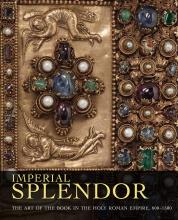
The Structure of the Empire
The history of the Holy Roman Empire challenges notions that nationhood and nationality are predetermined by shared ethnicity and language. The territories gathered within its borders constituted a diverse, multiethnic, and highly decentralized confederation of states and jurisdictions, loosely allied under an elective, rather than hereditary, monarchy. Although historically associated with Germany, the empire in the Middle Ages spread well beyond German-speaking lands. Its multilingual character was acknowledged in the Golden Bull of 1356, the equivalent of its constitution, which encouraged electors and their successors to learn German, Latin, Italian, and Czech as official languages. By the late Middle Ages, the imperial Diet, or deliberative assembly—later known as the Reichstag—provided the means through which the empire’s many territories and free cities came to convene and negotiate among themselves. The structure of the Reichstag is reflected in a grand two-page spread from the “Nuremberg Chronicle,” a popular universal chronicle covering the history of the world from Creation to the Last Judgment. The three colleges (collegia), or governing bodies of the empire, are represented in a schematic fashion. At top are the seven prince-electors, followed by various ranks of nobility as well as representatives from the free imperial cities. By the eve of the Reformation there were as many as fifty-three principalities within the empire, lending it its familiar patchwork character.
HIERARCHY OF THE HOLY ROMAN EMPIRE, CA. 1500

Collecting Medieval Manuscripts

The collecting of medieval art in America coincided with a particularly active moment in the history of the European art market. Although there was little interest in medieval art among American collectors for most of the nineteenth century, the years around 1900 witnessed the emergence of a new generation of wealthy amateurs like J. Pierpont Morgan (1837–1913) and Henry Walters (1848–1931). For the most part, these collectors were not devoted to any single period of art but rather collected widely across many different fields. Working closely primarily with European dealers, they acquired vast amounts of art and rare books at a time when aristocratic collections in Europe were increasingly being sold to raise funds. Medieval manuscripts had made their way into those aristocratic collections much earlier in the century, when a process of secularization resulted in their transfer from religious institutions into either national collections or private hands. More than any other collection in North America, J. Pierpont Morgan’s library came to include treasures of early medieval art, among them manuscripts associated directly or indirectly with imperial patronage—hence the title Imperial Splendor. Such patronage provides the leitmotif of the exhibition, beginning with the four manuscripts displayed below. They date to the ninth century, a period named “Carolingian” after Charlemagne (ca. 748–814) and his heirs, the first medieval emperors in western Europe.
The West Room of J. Pierpont Morgan’s Library, 1914 or later. The Morgan Library & Museum, ARC 1628. Photography by Tebbs and Knell.
Overview
Gallery Images
Imperial Networks
9th–11th Century
The Carolingian and Ottonian dynasties, named after Charlemagne (ca. 748–814) and Otto I (912–973), respectively, laid the groundwork for the Holy Roman Empire. Their rulers deliberately sought out the imperial title to legitimize their control over diverse kingdoms and principalities that, at the empire’s height, encompassed much of present-day western and central Europe. The manuscripts produced during their rule engaged with the legacy of ancient Rome and embodied the ambitions of the patrons for whom they were made. Scribes and artists in this period developed prestigious visual and graphic elements for their books, including the use of gold ink, purple parchment, a hierarchy of scripts, elaborate decorative initials, and spectacular treasure bindings. Paying attention as much to visual qualities as to content, the Carolingians and Ottonians fundamentally shaped the role of illuminated manuscripts in the Middle Ages. The most deluxe works were often commissioned as gifts and thus played a crucial role across carefully cultivated networks of power. These manuscripts featured prominently in solemn rituals at the heart of both religious life and governance. As preservers of institutional memory, the illuminated manuscripts of this period vividly articulate notions of empire, authority, and tradition.
Lindau Gospels
BOOK AS TREASURE
This treasure binding is a composite made of two distinct covers brought together on a Gospel book written and illuminated toward the end of the tenure of Hartmut, abbot of St. Gall, likely for ceremonial use in the abbey church. The jeweled front cover must have been a royal gift of immense importance. It is one of only three surviving examples of metalwork that can be attributed to the court workshop of Emperor Charles the Bald (823–877), who, like his grandfather Charlemagne, was a great patron of illuminated manuscripts. The back cover may have once belonged to a Gospel book commissioned by Charlemagne’s rival Tassilo III (ca. 741–796), Duke of Bavaria. Also, the rare Byzantine and Syrian silks lining the inside covers were likely gifts. Because Carolingians lacked the technology to produce silk, such textiles were highly coveted luxury items, often distributed through royal networks.
"Lindau Gospels," in Latin
Switzerland, St. Gall, ca. 880 (manuscript)
Eastern France, ca. 870 (front cover)
Austria, Salzburg region, ca. 780–800 (back cover)
The Morgan Library & Museum, MS M.1
Purchased by J. Pierpont Morgan, 1901
Joshua O'Driscoll, Assistant Curator of Medieval and Renaissance Manuscripts
This magnificent gospel book was written and illuminated in the late ninth century, at the monastery of St. Gall, which is strategically located along one of the alpine passes leading to Italy. The spectacular front and back covers of the manuscript were made elsewhere and predate the book itself.
The golden front cover is a masterpiece of Carolingian metalwork. The figure of Christ on the cross dominates the center of the composition, around which ten figures are arranged in dramatic poses of grief. Directly above Christ, personifications of the sun and moon mourn his death, as do the Virgin Mary and John the Evangelist beneath the cross.
The back cover is no less remarkable. Created for a now-lost luxury gospel book, the cover was made in or around Salzburg about a hundred years earlier than the manuscript it now adorns. Its design consists of a large cross with flared arms, set inside a rectangular enamel frame. Certain details lend the cover a cosmological dimension. The Greek letters alpha and omega are inscribed on the vertical arm of the cross and refer to the beginning and end of time. Likewise, the mass of snakes and other creatures filling the four carved plaques between the arms of the cross establish a link between the Gospels and the primordial act of creation.
Both covers likely reached St. Gall as royal gifts of immense importance. A similar route can be surmised for the rare silk textiles lining the inside of both covers. Because the Carolingians lacked the technology to produce silk for themselves, such textiles were highly coveted luxury items, and were often distributed through royal networks.
Gospel Lectionary
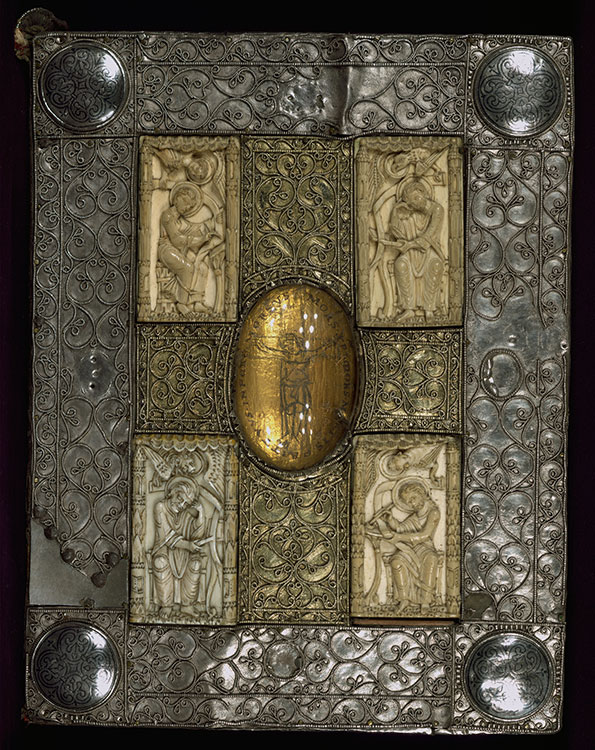
BOOK AS TREASURE
This treasure binding, original to its manuscript, consists of a silver-filigree frame, a silver-gilt cross (noticeably more golden in color), and four ivory plaques of the evangelists (Mark, lower left, is a modern replacement). At its center, the cross features a polished rock crystal protecting an image of the Crucifixion drawn on gold foil. A splinter of the True Cross rests upon Christ’s chest. The surrounding inscription, “The death of Christ was the death of death, and your bite, O Hell,” emphasizes the paradox of Christ’s death as a triumph of eternal life. Through this deliberate staging, the relic appears as the source of the cross’s life-giving power, which emanates from the center in the form of the cover’s abundant vegetal motifs. The book was created at Regensburg, likely for the Benedictine abbey of Mondsee (near Salzburg), where it was preserved for much of the Middle Ages.
Gospel Lectionary, in Latin
Germany, Regensburg, ca. 1030–50, with later additions
Walters Art Museum, Baltimore, MS W.8
Purchased by Henry Walters, before 1931
Book-Shaped Reliquary
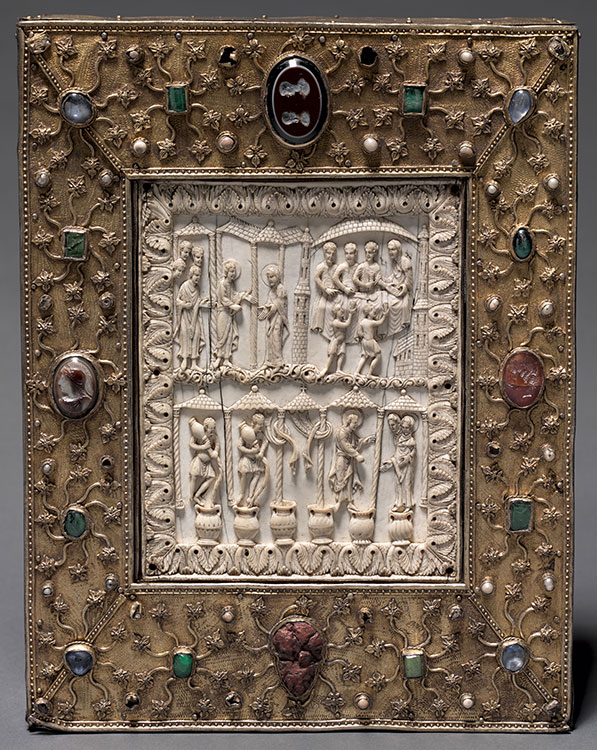
BOOK AS TREASURE
Modeled after a treasure binding, this reliquary was commissioned by Duke Otto the Mild (1292–1344) as part of his magnificent memorial donation to the collegiate church (now cathedral) of St. Blaise in Brunswick. The engraved effigies of that church’s three patron saints on the reverse tie the object to the dynastic foundation. The front cover reuses much older objects, including an eleventh-century ivory of Christ’s miracle at the Wedding at Cana, as well as ancient cameos—small carved glass or gemstone plaques—interspersed with precious gems. The use of such spolia (spoils) forms part of a broader representational program that proclaimed the status and authority of the patron’s family while adding to the prestige of their local church. Among the relics within were pages from the four Gospels, lending the object a quasi-liturgical function.
Book-Shaped Reliquary
Germany, Lower Saxony, ca. 1340 (reliquary)
Belgium, Liège (?), late eleventh century (ivory)
Cleveland Museum of Art
Gift of the John Huntington Art and Polytechnic Trust, 1930.741
Saint-Remi Gospels

CAROLINGIAN PRECEDENTS
Among the largest cities in Roman Gaul, Reims was also a center of artistic renewal in the Carolingian empire. This efflorescence was fostered by enterprising archbishops like Hincmar of Reims (806–882), who renovated several important monasteries in his domain, including Saint-Remi just outside the city walls. Preserving the relics of St. Remigius, who baptized King Clovis and converted the Franks to Christianity, the monastery laid claim to a fundamental moment in Frankish history. Commissioned by Hincmar for Saint-Remi’s rededication, this manuscript was written exclusively in gold ink. The portrait of the evangelist Matthew is deeply classicizing, a reference to the city’s ancient past. Featuring the opening words of the Gospel, the purple ground of the facing page likewise refers to imperial traditions.
"Saint-Remi Gospels," in Latin
France, Reims, ca. 852
The Morgan Library & Museum, MS M.728, fols. 14v–15r
Purchased, 1927
Gospel Book (MS M.640)
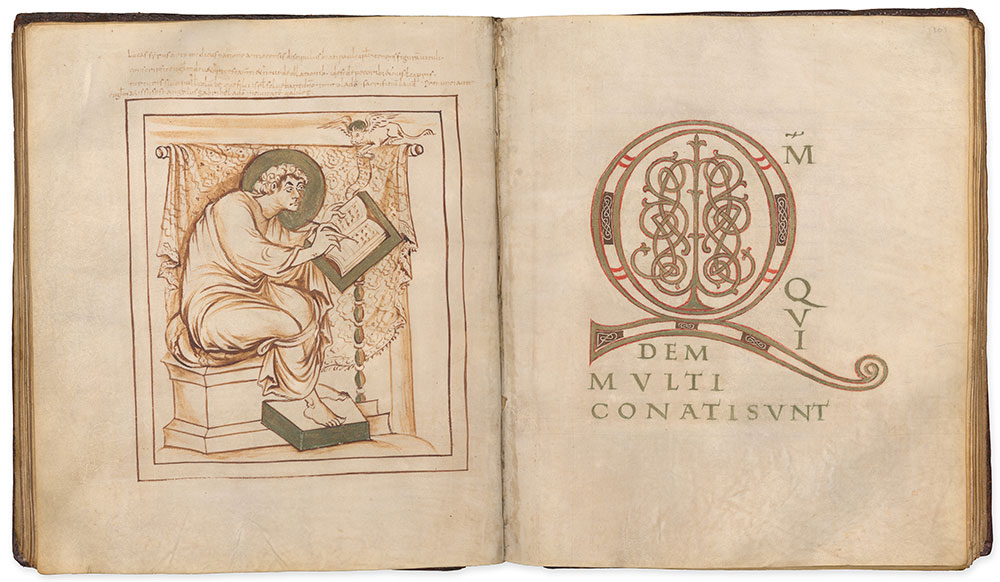
CAROLINGIAN PRECEDENTS
Books played a crucial role in establishing networks of power. Over twenty Carolingian manuscripts name Hincmar of Reims as donor, and many more are associated with his patronage. Most were created for use in and around Reims, but their influence was widespread. This Gospel book features two evangelist portraits and the beginnings of a third, all drawn in a distinctly Reimsian style. While to a certain extent unfinished, the heavy use of shading—as evident in this image of the evangelist Luke—suggests that the portraits were never intended to be painted. The artist may have been trained at Reims, but the manuscript itself was produced at an unknown regional scriptorium. The use of brass instead of gold further suggests that the manuscript was not produced at a major center.
Gospel Book, in Latin
Northeastern France or Belgium (Liège?), late ninth century
The Morgan Library & Museum, MS M.640, fols. 100v–101r
Purchased by J. P. Morgan, Jr., 1919
Gospel Book (MS M.860)

CAROLINGIAN PRECEDENTS
Inviting to his court the best scholars throughout Europe, Emperor Charlemagne (ca. 748–814) attempted to reform and standardize writing itself, which varied widely across the empire. Scribes working at important monastic centers like St. Martin at Tours developed new styles of script modeled on those of the ancient Romans. In this manuscript from Tours, the title page (at left) announces the beginning of Matthew’s Gospel. Written on bands of imperial purple, the golden capitals recall stone-carved inscriptions of ancient Rome. At right, Matthew’s Gospel begins with Liber generationis (Book of the generation of Jesus Christ). Here, the scribe combines Roman letterforms with nonclassical interlace ornaments, transforming sacred words into a work of art.
Gospel Book, in Latin
France, Tours, ca. 857–62
The Morgan Library & Museum, MS M.860, fols. 14v–15r
Purchased with the Assistance of the Fellows, 1952
Epistle Lectionary

CAROLINGIAN PRECEDENTS
Strategically located along one of the alpine passes leading to Italy, the abbey of St. Gall was favored by Carolingian rulers, who demonstrated their support through a series of privileges, allowing the monks to govern themselves independently from the local bishop. Abbot Hartmut (r. 872–83) actively fostered its cultural life, commissioning a great number of books to be written “for the communal use of the monastery.” Among them was this lectionary, illuminated in a characteristic nonfigural style. The alternating gold and silver of the manuscript’s opening initials echoes the alternating gold and silver lines of text. While these opening pages are the most prominently decorated, the manuscript contains nearly 150 decorative initials, each of which introduces a reading for Sundays and special feast days.
Epistle Lectionary, in Latin
Switzerland, St. Gall, ca. 880
The Morgan Library & Museum, MS M.91, fols. 1v–2r
Purchased by J. Pierpont Morgan, 1905
Astor Lectionary

OTTONIAN BEGINNINGS
Looking back to Carolingian models (on view at the entrance to the exhibition), illuminators at Corvey developed a new style of painting that was largely abstract, using ornamental forms inspired by silks, gems, enamels, sumptuous metalwork, and imperial monograms. These manuscripts demonstrated not only the wealth and munificence of the imperial family but also the international status of their power. This Gospel lectionary features ornamental pages that preface the readings for important Masses. For Christmas, thirteen words stretch across nine pages of designs culminating in the word Mattheum (Matthew), at left, depicted in a monogrammatic composition. At right, the same approach is used to form the words In illo tempore (In that time). As the personal signs of rulers, monograms were potent symbols of authority in the Middle Ages and possessed a nearly magical quality.
"Astor Lectionary," in Latin
Germany, Corvey, ca. 950
New York Public Library, MA 1, pp. 14–15
Astor, Lenox, and Tilden Foundations
Quedlinburg Gospels

OTTONIAN BEGINNINGS
This Gospel book was likely made for the imperial convent of Quedlinburg, among the most important foundations in Saxony. Established in 936 by Otto I and his mother, Mathilda, the abbey served as a memorial site for the Ottonian family. Its abbesses were Ottonian princesses, many of whom were actively engaged in politics. Befitting such prestige, this manuscript is one of the largest and most splendidly illuminated products of the Corvey scriptorium. Luke’s Gospel begins with an elaborate interlace initial Q framed by monochrome textile designs in the corners. The text continues in gold on the facing page, set against a striking textile background in shades of purple. The evocation of luxury objects like silk cloth relates to Otto’s extensive diplomatic activities, which resulted in the exchange of precious goods from centers spanning from Córdoba to Constantinople.
"Quedlinburg Gospels," in Latin
Germany, Corvey, ca. 950–70
The Morgan Library & Museum, MS M.755, fols. 99v–100r
Purchased, 1929
Joshua O'Driscoll, Assistant Curator of Medieval and Renaissance Manuscripts
Beginning around the middle of the tenth century, Otto the Great, or members of his family, began commissioning a number of deluxe manuscripts from the scriptorium at Corvey—an important monastery in Saxony. Little is known about the exact circumstances of their production, but both the script and illumination of these manuscripts suggest close ties with the imperial family. Based on their early histories of ownership, these manuscripts were likely produced for export as imperial gifts.
This gospel book is among the largest and most splendidly illuminated products of Corvey in the tenth century. It was likely made for the convent of Quedlinburg, which served as a mausoleum for the imperial family. Each of the four gospels in this book begins with a sumptuous four-part sequence of ornamental text pages. Shown here is the opening for the Gospel of Luke, the first word of which (quoniam) is formed by an elaborate initial Q framed by monochromatic textile designs in the four corners. The sacred text continues in gold on the facing page, which likewise features a striking textile design for the background. These pages exemplify the new style of painting developed by illuminators at Corvey—a style that was largely abstract and inspired by precious luxury objects like silk textiles, gems, enamels, and metalwork.
Ornate in the extreme, these manuscripts were meant to do more than just dazzle their viewers. The particular approach to painting developed at Corvey demonstrated not only the wealth and munificence of the imperial family, but also the international status of their power.
Gospel Book (Fragment)

OTTONIAN BEGINNINGS
These fragmentary leaves once formed part of a Gospel book given to Reims Cathedral. Otto I’s younger brother Bruno (925–965) was not only duke of Lotharingia and archbishop of Cologne, but also regent of France during this period. He had a particularly strong interest in Reims and perhaps played a role in the donation of this manuscript. The title page for Luke’s Gospel, at left, demonstrates how painters could simulate precious materials. Four fictive enamel medallions occupy most of the page. Filling the spaces between the medallions, the golden text takes on the form of a cross. The facing page features a large initial Q framed by a fictive enamel border, seemingly lined with pearls. The unusually painted vegetal motifs in the corners of each page evoke carved gems (intaglios).
Gospel Book (Fragment), in Latin
Germany, Corvey, ca. 950–70
Walters Art Museum, Baltimore, MS W.751, fols. 1v–2r
Purchased, 1952
Gospel Book (MS M.651)

OTTONIAN PATRONAGE
Marking a break from local painting traditions in Cologne, this Gospel book demonstrates the influence of artistic developments at the island monastery of Reichenau, an important center of Ottonian patronage. The portrait of Matthew features an expansive gold background, faintly articulated with golden vegetal motifs at bottom and nearly imperceptible golden stars above. Matthew’s symbol, a winged man, emerges from the architecture to offer him a scroll. The facing page combines Reichenau traits—the curved L, for example, and the anchoring of the initial to the frame—with elements more local to Cologne, such as the portrait medallions, inspired by ancient coinage. Although the patron of this manuscript is unknown, its illumination points to the high standing of Cologne, whose bishops were often active as chancellors at court.
Gospel Book, in Latin
Germany, Cologne, ca. 1030
The Morgan Library & Museum, MS M.651, fols. 8v–9r
Purchased by J. P. Morgan, Jr., 1920
Golden Gospels
OTTONIAN PATRONAGE
This Gospel book was written entirely in gold ink on purple-painted parchment. It evokes the venerable tradition of ancient manuscripts represented by the fragmentary leaf from a sixth-century Gospel book displayed above.
The “Golden Gospels” contains only the sacred text, written in double columns using an uncial (uppercase) script long out of fashion by the tenth century. With as many as sixteen scribes copying the text, the finished leaves were stacked together before the gold ink was completely dry, leaving visible offsets. The plant-based purple pigment varies in hue to such an extent that several batches must have been made, without regard for consistency. The manuscript was likely created in haste, perhaps as an imperial gift to mark a particular occasion for which there was little time to prepare. The intended recipient is unknown, but in the sixteenth century it was owned by King Henry VIII of England.
"Golden Gospels," in Latin
Germany, Trier, ca. 980
The Morgan Library & Museum, MS M.23, fols. 72v–73r
Purchased by J. Pierpont Morgan, 1900
Leaf from a Gospel Book (“Codex Petropolitanus”), in Greek
Syria, Antioch (?), sixth century
The Morgan Library & Museum, MS M.874
Purchased, 1955
Joshua O'Driscoll, Assistant Curator of Medieval and Renaissance Manuscripts
This grandiose gospel book is the last in a long line of deluxe manuscripts written entirely in gold or silver ink on parchment that has been stained purple, a color traditionally reserved for emperors and their family. This ancient tradition dates back to the time of the earliest Christian emperors like Constantine the Great, who ruled in the early fourth century. However, by the time this manuscript was made, in the late tenth century, the tradition of the purple codex had largely come to an end. The patron of this manuscript, who may have been Archbishop Egbert of Trier, a former chancellor of Emperor Otto II, likely intended to recreate the appearance of an ancient purple manuscript.
This gospel book was almost certainly made as a gift, and its production involved an enormous team of skilled artisans, including as many as sixteen scribes. They worked in great haste, often stacking together the freshly written pages before the gold ink was completely dry, which explains the offsets visible at the bottom of the left page. The fact that this book was later owned by King Henry VIII of England suggests that it may have been created as a gift from the Ottonian emperors to an English dignitary.
A brief painted inscription runs along the outer fore-edge of the manuscript, stating that “the inside of the book is more ornate than the outside.” This inscription refers in a typically medieval way to a now-lost treasure binding that once adorned the manuscript. The inscription juxtaposes the conspicuous material value of the now-lost jeweled covers with the much greater spiritual value of the book’s text.
Gospel Book (MS W.7)

OTTONIAN PATRONAGE
The island monastery of Reichenau was among the most celebrated centers of artistic production during the Ottonian period. Nearly sixty deluxe manuscripts from its scriptorium survive. The vast majority of these commissions were created for export, and the very consistency and longevity of this output attests to a well-organized workshop with a rich supply of models. Belonging to the end of this tradition, this Gospel book opens with a remarkable dedication miniature featuring an unidentified abbot handing the manuscript to St. Peter. As gatekeeper of heaven, Peter holds open a door leading to an altar on which the same book is blessed by the hand of God. By the mid-eleventh century, Reichenau had begun to lose its preferred status as other artistic centers vied for imperial favor.
Gospel Book, in Latin
Germany, Reichenau, ca. 1050
Walters Art Museum, Baltimore, MS W.7, fols. 9v–10r
Purchased by Henry Walters, ca. 1913–1931
St. Peter’s Gospels

SALZBURG AND THE ART OF REFORM
Around the year 1000, the abbey of St. Peter’s in Salzburg was reformed with the goal of instituting a more disciplined form of monastic life, which found expression in the reinvigorated production of manuscripts like this Gospel book. Sumptuously illuminated by two artists, it was likely used on special feast days. The miniatures respond to artistic developments at centers of monastic reform like Regensburg, Reichenau, and Fulda. The main inspiration, however, was a Gospel book commissioned by Emperor Henry II (973–1024), himself an active reformer, for his new foundation at Bamberg (where it remains today). Against a gold ground, John the Evangelist looks to an eagle, his symbol, which holds open a book. At right, the opening words of his Gospel appear in gold on purple ground (In principio erat verbum; “In the beginning was the word”). Many of the miniatures retain their original protective silk curtains.
"St. Peter’s Gospels,” in Latin
Austria, Salzburg, ca. 1020
The Morgan Library & Museum, MS M.781, fols. 188v–189r
Purchased on the Lewis Cass Ledyard Fund, 1933
Joshua O'Driscoll, Assistant Curator of Medieval and Renaissance Manuscripts
Monasteries with imperial patronage enjoyed a relative independence from local oversight. With few exceptions their abbots answered only to the emperor or the pope—a freedom that enabled them to amass considerable wealth and to pursue ambitious programs of artistic production. For most of the tenth century, however, this was not the case in Salzburg—the seat of the Archbishop of Bavaria. Traditionally, the archbishop was simultaneously the abbot of the most important monastery in the region, St. Peter’s. This situation changed dramatically in 987, in response to monastic reform movements that swept throughout the empire, with a goal of instituting a more disciplined adherence to monastic life, free from unnecessary interference.
A monk from Regensburg, named Tito, became the first independent abbot of St Peter’s. He initiated a series of structural changes resulting in the separation of the abbey from the cathedral and its archbishop.
Known as the St. Peter’s Gospels, this manuscript was one of the first major products of the newly reinvigorated scriptorium at St Peter’s and was produced in the final years of Tito’s abbacy. It was likely used on special feast days at the abbey church. Painted by a main artist and an assistant, its miniatures reflect the most recent artistic developments at important reform centers like Regensburg and Reichenau. The artist’s most important model, however, was a book commissioned by Emperor Henry II for his newly founded cathedral at Bamberg--a choice that speaks to the aspirations of the abbey at Salzburg. Shown here is the opening of the Gospel of John, whose portrait, on the left, is set against a solid gold ground. At right are the first words of the Gospel, set against an extravagantly ornamented purple ground.
Gospel Lectionary

SALZBURG AND THE ART OF REFORM
Generations of painters at Salzburg looked to the “St. Peter’s Gospels” as a source of inspiration. As these foundational miniatures were copied over the decades, a shift toward Byzantine and Italian styles of painting can be observed. The illuminator of this Gospel lectionary took many of his compositions directly from earlier Salzburg manuscripts, but opted for simpler drapery, less modeling, stronger outlines, and a different technique for creating skin tones. The manuscript opens at left with a dedication scene in which an unidentified abbot hands his book to an unidentifiable saint. The miniature at right depicts the Presentation and Betrothal of Mary in the Temple. Crowned by an angel, the young Virgin is presented by her mother, Anna, to her future husband, Joseph. The nude figures atop the two columns are based on the Spinario, an ancient bronze statue from Rome that was famous throughout the Middle Ages.
Gospel Lectionary, in Latin
Austria, Salzburg, ca. 1030–40
The Morgan Library & Museum, MS G.44, fols. 1v–2r
Gift of the Trustees of the William S. Glazier Collection, 1984
Berthold Lectionary

SALZBURG AND THE ART OF REFORM
Berthold, the custodian (custos) of St. Peter’s Abbey, identifies himself as the patron and perhaps even the maker of this manuscript in a decorative inscription at the end of the book (at right): “To the key-bearer of heaven [St. Peter] the custodian Berthold, who made this book, offers it with a joyful heart to pay for all his sins. May he who steals it suffer violent bodily pains.” The unusually graphic curse may have been added in response to the politically backed plundering of local monasteries that was occurring at the time. Berthold’s miniatures feature a dramatically flattened style, with monumental figures, starkly rendered outlines, and narrative elements reduced to only the essentials. Each of these developments can be seen in this miniature of the Presentation of Christ in the Temple.
"Berthold Lectionary," in Latin
Austria, Salzburg, ca. 1080
The Morgan Library & Museum, MS M.780, fols. 20v–21r
Purchased on the Lewis Cass Ledyard Fund, 1933
Leaf from a Gospel Lectionary
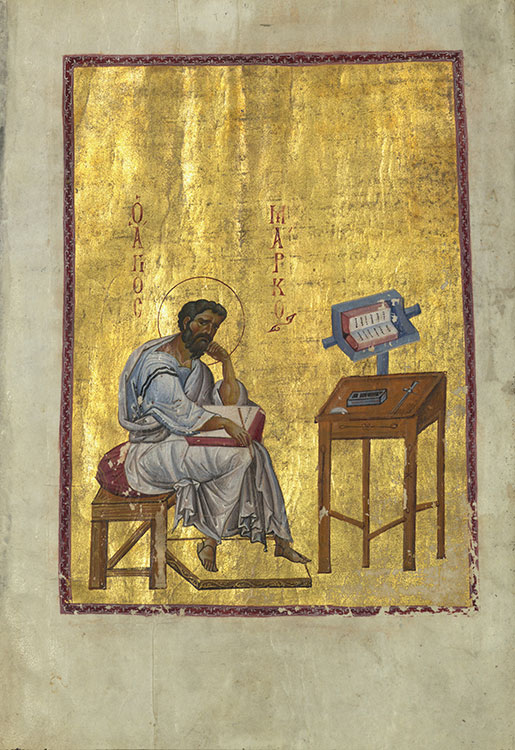
SALZBURG AND THE ART OF REFORM
This leaf once formed part of a Gospel lectionary from Constantinople, written and illuminated around the same time the “St. Peter’s Gospels” was being produced at Salzburg. Pausing after writing the first line of his text, the evangelist Mark is deep in thought. The artist avoids any hint of an architectural setting, allowing viewers to focus instead on the dramatic intensity of the evangelist’s facial expression. The noticeable shift in style at Salzburg may perhaps be attributed to increased trade connections with Venice and northern Italy in the eleventh century, which provided an important link to Byzantium.
Leaf from a Gospel Lectionary, in Greek
Constantinople, early eleventh century
Walters Art Museum, Baltimore, MS W.530a
Purchased by Henry Walters, before 1931
Imperial Monasteries
12th–14th Century
As monastic reform movements gained momentum throughout the empire, the tenuous relationship between emperor and pope, so carefully maintained by Carolingian and Ottonian rulers, devolved into outright hostility. The trigger was the matter of investiture, the practice of appointing new bishops or abbots. For centuries, emperors and kings reserved the right to install their own candidates in important clerical positions within their realm. However, with the increasing strength of the papacy, along with a growing sense that bishops should not be active in imperial politics, this traditional right became untenable. The ensuing Investiture Controversy (ca. 1076–1122) resulted in a significant weakening of imperial power and a related strengthening of the role of local nobility like the Guelph dynasty, which at its height controlled the duchies of Saxony and Bavaria. In terms of manuscript production, the great age of imperial commissions was largely over. Instead, monasteries began to produce deluxe manuscripts for in-house use or for distribution across their networks. The increased patronage of local nobility, as well as the growing prominence of cathedral schools and universities, meant that book culture itself was changing. New texts were being copied, and new ways of illuminating were being explored.
Gospel Book (MS Ludwig II 3)

THE MONASTIC SCRIPTORIUM
One of the earliest foundations to flourish in the wake of the tumultuous Investiture Controversy was the Benedictine monastery of Helmarshausen in Saxony. Its abbots acquired important relics from Trier, providing the impetus for new building campaigns as well as promoting manuscript production. This Gospel book is an early witness to the monastery’s cultural vitality. Its inventive evangelist portraits combine new styles of painting from the Rhine-Meuse region with local Saxon traditions. The portrait of Luke is rendered in strong outlines, with drapery characterized by nested V-folds and modeling achieved through heavy bands of shading. In contrast to these innovations, the simulated textile designs of the facing page refer directly to the abstract tradition of painting cultivated at nearby Corvey in the tenth century.
Gospel Book, in Latin
Germany, Helmarshausen, ca. 1120–40
J. Paul Getty Museum, Los Angeles, MS Ludwig II 3, fols. 83v–84r
Purchased by the J. Paul Getty Museum, 1983
Heiningen Gospels
Although monasteries produced the majority of manuscripts in the twelfth century, the task of illuminating these works did not always fall to monks. For prestigious commissions, monasteries could seek out professional painters, who traveled widely in search of work. This Gospel book was illuminated by two artists. The first was a monk of Hamersleben; the second, whose work is shown here, was a professional painter with a strikingly different style. The figure of the evangelist Matthew has been endowed with a thoughtful expression and dramatic drapery. He appears to occupy three-dimensional space, an effect heightened by contrasts between the varied surfaces. In these respects, the illuminator demonstrates firsthand knowledge of contemporary artistic developments across the continent. The pastiche book box (above), in which the manuscript was stored, combines thirteenth-century elements with nineteenth-century additions, such as the large plaque of Christ at center.
"Heiningen Gospels" (Fragment), in Latin
Germany, Hamersleben, ca. 1170 and ca. 1200 (manuscript)
Germany, Saxony, thirteenth century, and France, Paris, nineteenth century (book box)
The Morgan Library & Museum, MS M.565, fol. 13v
Purchased by J. Pierpont Morgan, 1905
Stammheim Missal
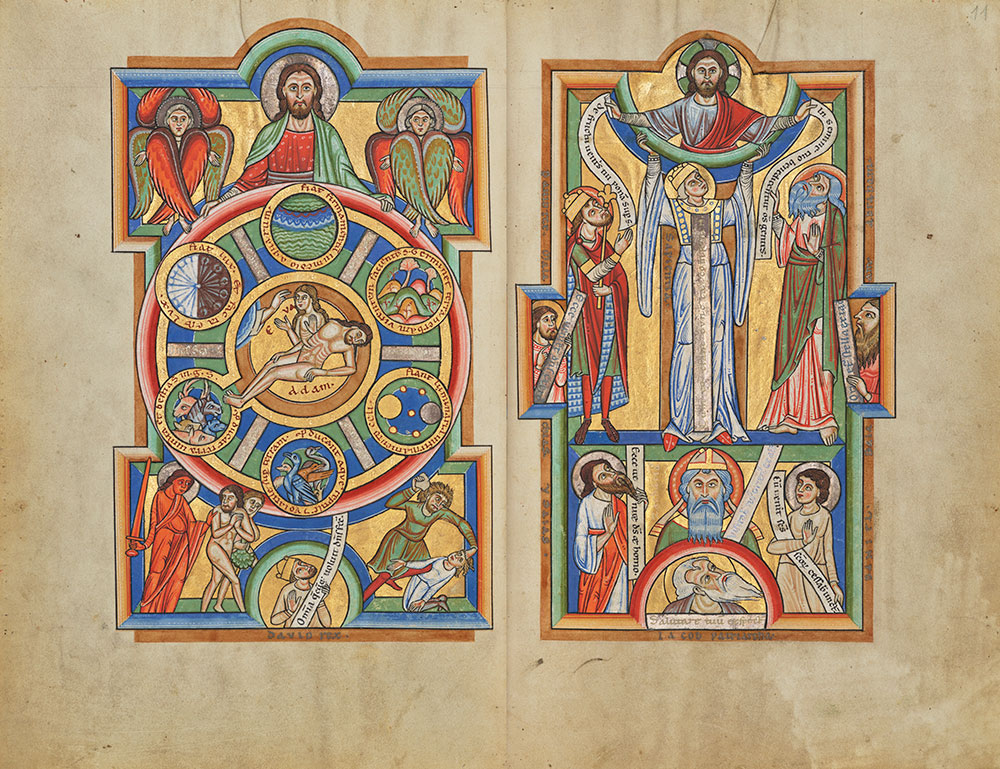
THE MONASTIC SCRIPTORIUM
In the twelfth century, monks at the Benedictine monastery of St. Michael advocated for the canonization of their founder, Bishop Bernward of Hildesheim (d. 1022). These efforts coincided with a flurry of artistic activity, including the production of spectacularly illuminated manuscripts—among them, this missal. By depicting the story of salvation, the prefatory cycle shapes viewers’ understanding of the manuscript’s contents. The radially organized Creation miniature, at left, focuses on the plight of Adam and Eve, who are encircled by representations of the six days of Creation. Their expulsion from paradise and the story of Cain and Abel, below, indicate the sinful state of humankind. The facing miniature, in contrast, represents the promise of salvation. At center, a personification of divine wisdom holds up Christ amid Old Testament figures who prophesize his incarnation.
"Stammheim Missal,” in Latin
Germany, Hildesheim, ca. 1170
J. Paul Getty Museum, Los Angeles, MS 64, fols. 10v–11r
Purchased by the J. Paul Getty Museum, 1997
Joshua O'Driscoll, Assistant Curator of Medieval and Renaissance Manuscripts
Around the middle of the twelfth century, monks at the Benedictine monastery of St. Michael at Hildesheim, in Lower Saxony, were advocating for the canonization of their famed eleventh-century founder—Bishop Bernward, who was a great patron of the arts as well as the tutor of Emperor Otto III. As part of this effort, the monks initiated a flurry of artistic activity that included building renovations and the production of spectacularly illuminated manuscripts such as this mass book, known as the Stammheim Missal. With fifteen full-page paintings and well over a dozen half-page decorative initials, this manuscript is among the most sophisticated and richly illuminated books of its time.
After a splendid calendar, the Stammheim Missal opens with a prefatory cycle of three miniatures depicting Creation, Divine Wisdom, and the Annunciation. The complex compositions of this opening cycle provide the viewer with a theological framework for understanding the contents of the manuscript. The first miniature, at left, focuses on the creation of Eve from Adam’s side. Around them are the six days of Creation. The scenes below depict their expulsion from Paradise and the subsequent story of Cain and Abel, both indicative of the sinful state of humankind.
If the first miniature emphasizes the Fall from Grace, the facing page represents the promise of salvation. At center, a personification of Divine Wisdom holds up a figure of Christ. They are surrounded by Old Testament kings, prophets, and patriarchs. Taken together, these figures present the coming of Christ as the fulfillment of Old Testament prefigurations. On the next page, Christ’s incarnation is depicted with the miniature of the Annunciation.
This approach of presenting events from the Christian New Testament as the fulfillment of prophecies from the Hebrew Bible is known as typology, and it was a central feature of monastic art in the twelfth century.
Leaf from a Gospel Book

THE MONASTIC SCRIPTORIUM
This leaf once formed part of a magnificent Gospel book, written and illuminated at Helmarshausen, but perhaps made for the monks at Corvey. Originally positioned at the beginning of Matthew’s Gospel, the leaf features a depiction of Christ embedded within the very first word, Liber (book). Through its inscription (verus in utroque deus extat homoque; “truly he exists as both man and god”), Christ’s scroll emphasizes the dual nature of his incarnation, while the very placement of the figure, inhabiting the sacred text, visualizes the link between Christ and the word of God.
Leaf from a Gospel Book, in Latin
Germany, Helmarshausen, ca. 1190
Cleveland Museum of Art
Purchased on the J. H. Wade Fund, 1933.445
Psalter (MS W.10)

THE MONASTIC SCRIPTORIUM
The scriptorium at Helmarshausen regularly exported both manuscripts and artists to nearby Paderborn and Corvey, and even to centers as far as Scandinavia. In the second half of the twelfth century, however, this pattern of patronage changed as local nobility began to commission works directly from the monastic scriptorium. An early example of this trend, this diminutive psalter was likely made for a local Guelph princess—perhaps Gertrud (ca. 1152–1197), the daughter of the duke of Saxony and a future queen of Denmark. Dressed in red brocade lined with ermine, she raises her hands in prayer. The object of her devotion, depicted on a now-lost facing page, was likely the Virgin Mary.
Psalter, in Latin
Germany, Helmarshausen, ca. 1160–70
Walters Art Museum, Baltimore, MS W.10, fols. 6v–7r
Purchased by Henry Walters, before 1931
Berthold Sacramentary

THE MONASTIC SCRIPTORIUM
In 1215, fire consumed the monastery at Weingarten. Major relics were lost, and the abbey church had to be rebuilt. In this context of renewal, Abbot Berthold engaged a professional painter—known as the Berthold Master—who illuminated a new set of liturgical books, chief among them this magnificent Mass book. The miniature for the feast day of St. Oswald, at left, depicts the saintly king of Northumbria seated next to Bishop Aidan of Lindisfarne. According to legend, Oswald gave so charitably to the poor that the bishop blessed the king’s generous hand. The hand never aged, becoming a wonder-working relic after his death. Emphasizing the miraculous qualities of Oswald’s relics, this full-page miniature promotes the cult of one of Weingarten’s patron saints. The manuscript preserves its original curtains and treasure binding.
"Berthold Sacramentary," in Latin
Illuminated by the Berthold Master
Germany, Weingarten, ca. 1215–17
The Morgan Library & Museum, MS M.710, fols. 101v–102r
Purchased by J. P. Morgan, Jr., 1926
Joshua O'Driscoll, Assistant Curator of Medieval and Renaissance Manuscripts
In the decades around 1200, pilgrims began to arrive at the Abbey of Weingarten, in Swabia, to venerate an extraordinary relic of Christ’s blood, which was donated by Judith of Flanders, the duchess of Bavaria and a great patron of the arts. Coinciding with this rise in pilgrimage, Berthold, the abbot of Weingarten, undertook an ambitious program of cultural production to reinforce the abbey’s new status as a religious center of international renown. Berthold’s leadership was tested when a catastrophic fire destroyed the monastery in 1215. Despite significant losses, the abbot was able to rededicate his church in just a few years. It is in this context of renewal and revitalization that Berthold engaged a professional painter to illuminate a new set of liturgical books for the monastery.
This magnificent mass Book represents Berthold’s most important commission. Shown here is the miniature for the feast of St Oswald, an obscure English saint who was initially not highly esteemed at Weingarten. Nevertheless, his relics formed part of Judith’s donation and Berthold made a conscious effort to raise the saint’s profile after the relics of other saints were destroyed in the fire. The use of colorful embroidered repairs, one of which you see on the margin of the right page, was part of a broader effort to make the manuscript appear older than it actually was. In a similar manner, the manuscript’s magnificent jeweled cover harks back to the age of Carolingian treasure bindings like the Lindau Gospels.
With its spectacular paintings and its range of precious materials from gold and gems to textiles and relics, the Berthold Sacramentary marks a high point of monastic book production. Moreover, as a prestigious memorial object, intimately tied to the abbey’s history and its self-image, the manuscript both celebrated and legitimized the forms of devotion so carefully promoted by Abbot Berthold.
Hainricus Missal
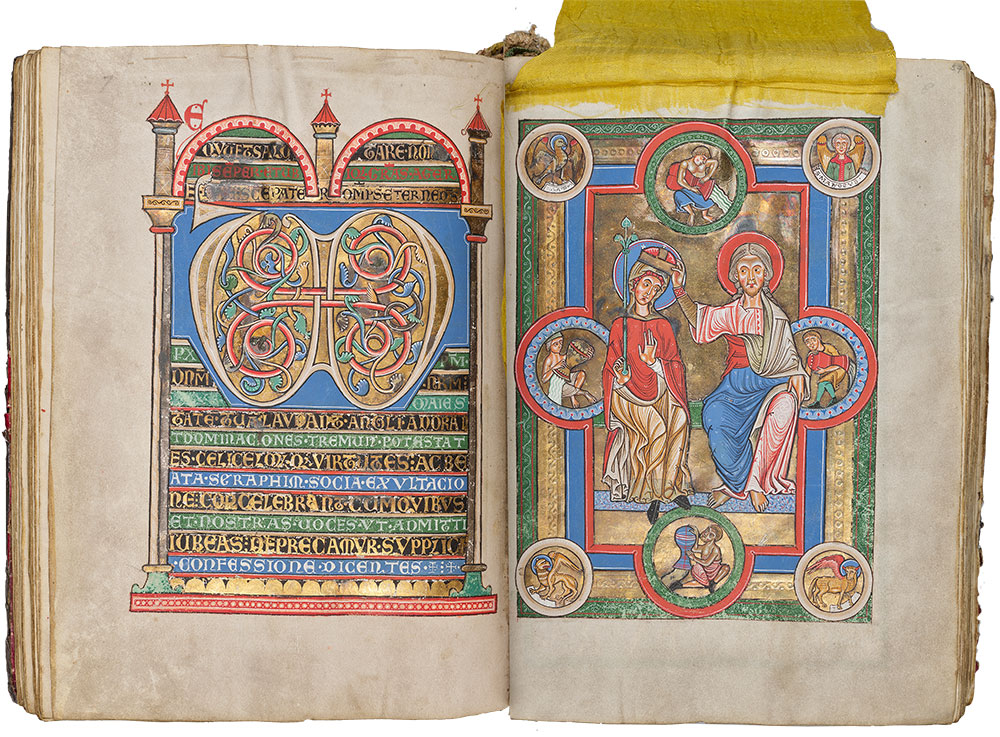
THE MONASTIC SCRIPTORIUM
After a burst of activity, the Berthold Master vanished from Weingarten without a trace. Just a few years later, a second professional artist took his place and painted miniatures for an important commission from a high-ranking member of the abbey: this Mass book for the sacristan Henry (Hainricus) to use in a chapel dedicated to the Virgin Mary, which he was responsible for maintaining. Placed unusually at the core of the manuscript just before the Eucharistic prayer, the Coronation of the Virgin, at right, attests to Henry’s devotion to Mary. The surrounding symbols of the four evangelists and four rivers of paradise underscore her central role in the universal Church. The manuscript preserves its original treasure binding, silk curtains, and remarkable thirteen-strand bookmark.
"Hainricus Missal" (Gradual, Sequentiary, and Sacramentary), in Latin
Germany, Weingarten, ca. 1220–30
The Morgan Library & Museum, MS M.711, fols. 56v–57r
Purchased by J. P. Morgan, Jr., 1926
Leaf from the Wettingen Gradual

RITE AND RITUAL
This monumental leaf from a choir book testifies to the ambition of the monks who commissioned it. With such commissions, newer mendicant orders like the Augustinians sought to place themselves on par with older foundations like the Benedictines. The illuminator responsible for this leaf worked in a manner derived from the latest fashion at the French court. Arranged from bottom to top like a stained-glass window, four scenes fill the initial I. They depict Augustine teaching; the dream of his mother, Monica; his baptism; and, finally, Bishop Augustine instructing monks. The scroll “spoken” by the monk in the lower margin reads, “Pray for us, blessed Father Augustine.”
Leaf from the “Wettingen Gradual,” in Latin
Germany, Cologne, ca. 1330
Cleveland Museum of Art
Purchased on the Mr. and Mrs. William H. Marlatt Fund, 1949.203
Homilary
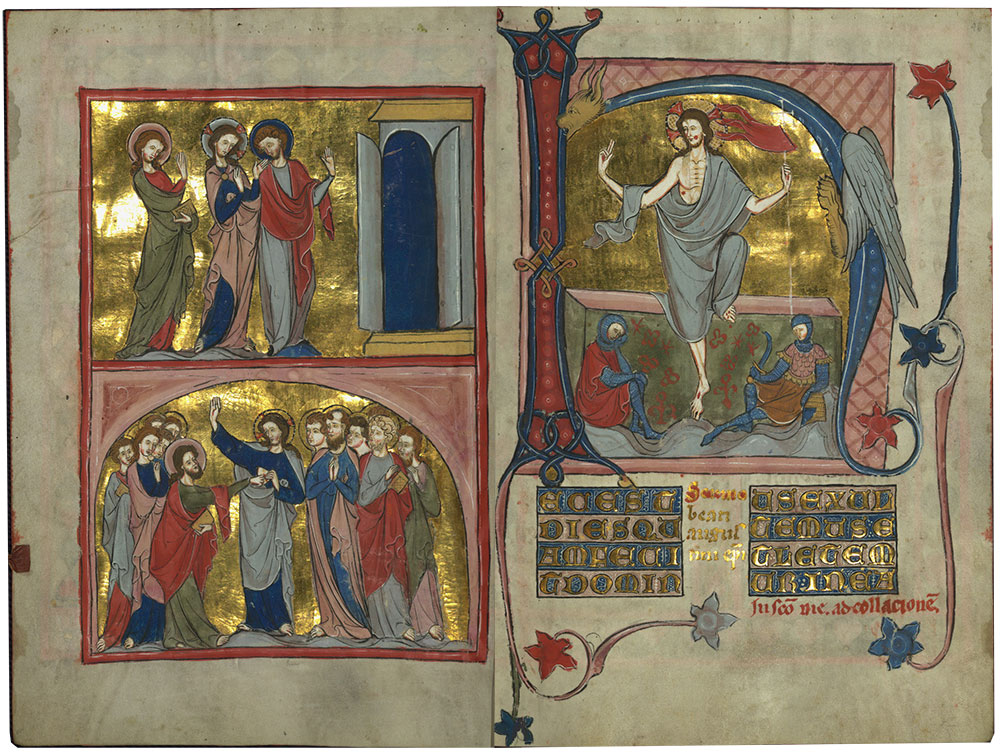
RITE AND RITUAL
In its profuse use of gold, whether in the burnished backgrounds or the display scripts, this collection of homilies emulates the lavish aesthetic of imperial manuscripts of the early Middle Ages, despite its adoption of Gothic conventions. The homilary—a collection of sermons—was made for and in part by a community of Cistercian nuns. A reform order, the Cistercians traditionally eschewed such luxury, but not here. In its monumentality, the grand initial of the Resurrection rivals that of the full-page miniature on the facing page, which depicts two of Christ’s appearances to the apostles after his Resurrection: Christ as a pilgrim on the road to Emmaus and the Doubting Thomas.
Homilary, in Latin
Germany, Westphalia, ca. 1330
Walters Art Museum, Baltimore, MS W.148, fols. 45v–46r
Purchased by Henry Walters, before 1931
Joshua O'Driscoll, Assistant Curator of Medieval and Renaissance Manuscripts
This richly painted book contains a collection of sermons for use during the Easter season. It is part of a pair, of which the other volume—now in Oxford—gathers together sermons for Christmas time.
Both manuscripts were made for a Cistercian convent in Westphalia, a region in northwestern Germany. In the High Middle Ages, the Cistercians were celebrated for their austerity, which led them to reject all forms of luxury, including the visual arts. In this book, however, no trace of such restraint remains.
A team of at least three professional artists painted most of the miniatures. Set against sheets of burnished gold, their elegant, elongated figures reflect the latest developments in painting from France. Shown here, at left, are two scenes that demonstrate Christ’s resurrection: above, is Christ on the Road to Emmaus, where he appears to two apostles who previously thought him dead; below is the Doubting Thomas, who needed physical proof that Christ had risen from the dead, and thus presses his finger into the wound in Christ’s side. At right, filling the oversized initial H, is the Resurrection itself. Two small soldiers are shown sleeping as Christ rises from the tomb. The composition evokes statues of the Resurrection that were a common fixture of Cistercian convents in Westphalia and played an important role in the Easter liturgy, as did this manuscript.
Gold is also used for the display scripts and the massive frames that adorn nearly every page of the manuscript. Several of these text pages were painted by the nuns for whom the manuscript was made. The extravagant use of gold represents just one of a number of archaic features that appear to have been deliberately adopted to evoke the lavish commissions characteristic of imperial female foundations of the earlier Middle Ages.
Leaf from an Apocalypse

RITE AND RITUAL
This large leaf, one of several surviving from a dismembered picture book of the Apocalypse, depicts John the Evangelist as the author of the book of Revelation, surrounded by seven angels representing the seven churches. The tabernacles and pinnacles around the angels evoke the façade of a Gothic cathedral, just as the blue-and-red palette suggests a stainedglass window. While it depicts the kingdom of heaven, the full-page miniature also represents the towering ambition of the high medieval Church. Didactic picture books of this kind had represented a popular genre in German monasticism since the twelfth century.
Leaf from an Apocalypse
Germany, Hessen, ca. 1340–50
J. Paul Getty Museum, Los Angeles, MS 108
Purchased by the J. Paul Getty Museum, 2011
Leaf from a Missal (MS M.892.2)

RITE AND RITUAL
Set against a gold background, a priest elevates a Eucharistic host within an initial C marking the beginning of the Feast of Corpus Christi. Behind him stand a deacon and a subdeacon holding a paten (plate). As this Mass celebrates the real presence of Christ in the Eucharistic offering, the most prominent detail is the monstrance (receptacle) at the corner of the altar, displaying a consecrated host. Unusually for a Mass book, the bottom margin is filled with animal scenes humorously depicting a world upside down. This missal was painted by Master Bertram, a well-documented artist in Hamburg whose workshop also produced panel paintings, sculpture, and decorative arts.
Leaf from a Missal, in Latin
Illuminated by Master Bertram (ca. 1340–1415) for Johann von Wustorp (d. 1381)
Germany, Hamburg, before 1381
The Morgan Library & Museum, MS M.892.2
Gift of the Fellows, 1958
Liturgical Set

RITE AND RITUAL
This deluxe liturgical set, likely commissioned by an abbot of St. Trudpert, was created by a lay goldsmith from Freiburg named Master John (Johannes), who ran an active workshop in the thirteenth century. The chalice, paten, and straw (to prevent spilling) were essential vessels used by a priest for the consecration of the Eucharist, the moment in Mass when the offering of bread and wine was ritually transformed into the body and blood of Christ. The rich visual program is typological: Old Testament prophecies at the base of the chalice are paired with New Testament scenes around its node (middle part). The use of typology continues on the paten, where Abel and Melchisedech serve as prefigurations of Christ as both sacrifice and celebrant.
Liturgical Set from the Abbey of St. Trudpert at Münstertal
Germany, Freiburg im Breisgau, ca. 1230–50
Metropolitan Museum of Art, New York
The Cloisters Collection, 1947.101.26–28
Lichtenthal Altar Tabernacle
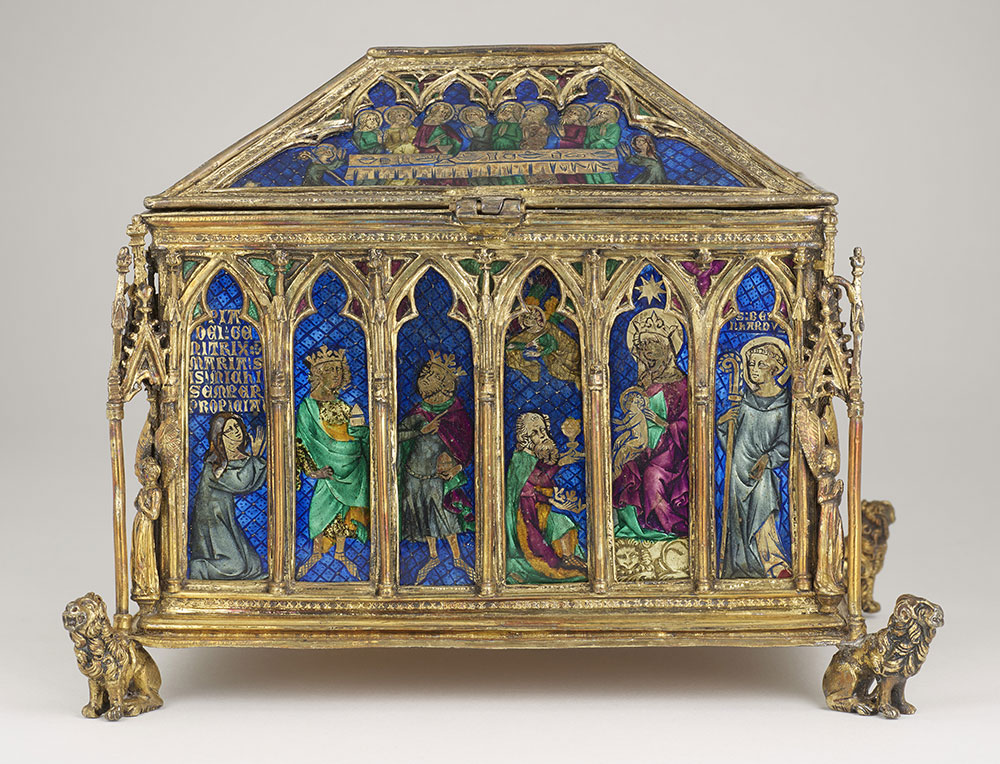
RITE AND RITUAL
This tabernacle was commissioned by Sister Margaret (Greda) Pfrumbon, whose family made several gifts to the Cistercian convent of Lichtenthal in the Rhineland, where she was a nun. Margaret appears alongside St. Bernard of Clairvaux, the famous monastic reformer and a fellow Cistercian. Like the three magi, Margaret offers her gift to the Virgin and Child. With its translucent enamel over an engraved ground, the tabernacle emulates stained-glass windows. The baldachins placed over angels on each corner of the tabernacle resemble those at Reims Cathedral, the coronation site of French kings. The lions serving as feet for the object link the tabernacle to the Temple of Solomon, the archetypal site of the Holy of Holies.
"Lichtenthal Altar Tabernacle"
Germany, Upper Rhine (?), ca. 1330
The Morgan Library & Museum, AZAZ 48
Purchased by J. Pierpont Morgan, 1908
Speculum virginum (Mirror of Virgins)

MONASTIC LEARNING AND REFORM
The Mirror of Virgins, a book instructing clerics in the spiritual care of nuns, exemplifies the changing status of visual imagery within monastic reform movements. The “mirror” of the title defines the text as a place where readers can examine the “face of their hearts.” A dialogue between a monk (Peregrinus) and a nun (Theodora), the work contains a dozen narrative, allegorical, and diagrammatic images that serve as instruments of pastoral care. The Trees of Vices and Virtues dominate one opening to the near exclusion of text. The text directs “novices and the untutored” toward these “two little trees,” so that “anyone studying to improve himself can clearly see what things will result from them.”
Conrad of Hirsau
(ca. 1070–ca. 1150)
Speculum virginum (Mirror of Virgins), in Latin
Germany, Himmerod, ca. 1200–1225
Walters Art Museum, Baltimore, MS W.72, fols. 25v–26r
Purchased by Henry Walters, 1903
Jeffrey Hamburger, Kuno Francke Professor of German Art & Literature, Harvard University
No work better exemplifies the changing status of visual imagery within monastic education than the Mirror of Virgins, a book of spiritual instruction for nuns written between 1130 and 1140. The manuscript’s use of tinted line drawings is characteristic of didactic works of monastic instruction within the context of twelfth-century efforts to reform monasticism by raising educational (and moral) standards. The author of the text, who was most likely from Hirsau, an important center of reform monasticism, refers to the mirror of the book’s title as a place where readers can examine the “face of their hearts.”
This early thirteenth-century copy was created at Himmerod, a monastery founded in 1134 by Bernard of Clairvaux. Despite Bernard’s well-known hostility to images, the monks there quickly came to consider them indispensable in certain contexts such as the pastoral care of nuns.
Constructed as a dialogue between a monk (Peregrinus) and a nun (Theodora), the Mirror includes a dozen narrative, allegorical, and diagrammatic drawings that aid in spiritual guidance and education. The Trees of the Vices and Virtues dominate the opening displayed here to the near exclusion of the main text. Whereas the branches of Vice, on the left, hang downward toward the Whore of Babylon, the Virtues, on the right, rise up from Jerusalem and Humility. Atop the Virtues, Christ stands as the “New Adam,” in contrast to the “Old Adam” whose fall was rooted in pride.
Underscoring the identification of the Tree of Vices with the Tree of Knowledge in the Garden of Eden, two serpents coil around the trunk. The text directs “novices and the untutored” toward these “two little trees,” so that “anyone studying to improve themselves can clearly see what things will result from them.”
Bestiary
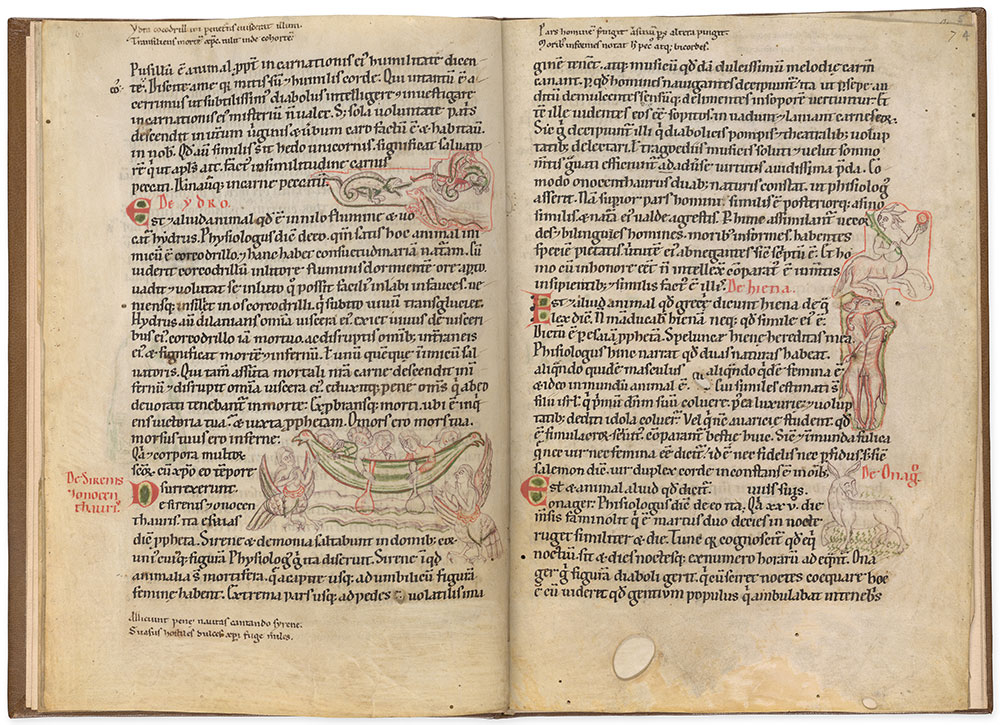
MONASTIC LEARNING AND REFORM
Monastic learning included texts on the natural world. A characteristic example from the important Benedictine monastery at Göttweig, this compilation of animal lore is based on ancient and early medieval sources. Beginning with the lion and ending with the phoenix, the text describes some thirty different animals, both real and imaginary. At upper left is the hydrus, legendary enemy of the crocodile; directly below are sirens, birdlike beasts that prey on sailors. At upper right is the onocentaur, a half-man, half-donkey hybrid; below that are sex-changing hyenas, related to sodomy; and the creature at lower right is a braying onager, symbol of the devil. Added later, rhyming couplets in the margins offer typological and moral interpretations of the animals, of a type also featured in the encyclopedic Concordance of Charity.
Bestiary (Dicta Chrysostomi), in Latin
Austria, Göttweig, ca. 1140–50
The Morgan Library & Museum, MS M.832, fols. 3v–4r
Gift of the Fellows, 1958
Leaf from a Schoolbook

MONASTIC LEARNING AND REFORM
This delicate drawing exemplifies the educational program of medieval monasticism. Personified liberal arts (branches of learning) descend from a magisterial figure of Philosophy. She is depicted as the queen of heaven, crowned and holding a scepter, flanked by personifications of the sun and moon and surrounded by stars and clouds, as if a celestial vision. Reminiscent of Pentecost imagery, seven streams flow from her breast, nourishing each of the liberal arts. The double-sided drawing marries principle to practice; whereas the arts are personified as women, on the reverse, their practitioners are presented as famous men.
Leaf from a Schoolbook, in Latin
Austria, Salzburg, ca. 1150–60
The Morgan Library & Museum, MS M.982
Purchased on the Belle da Costa Greene Fund, with special gifts of the Glazier Fund, Dr. Ruth Nanda Anshen, Mrs. Harold M. Landon, and Miss Julia P. Wightman, 1978
Speculum humanae salvationis (Mirror of Human Salvation)

HISTORIES OF SALVATION
The Mirror of Human Salvation was composed in northern Italy but enjoyed its widest dissemination north of the Alps. Juxtaposing scenes from the New Testament with Old Testament prefigurations, the images offer a lesson in the shape of sacred history and the nature of memory and meditation. In the first image, Mary mourns under the cross, surrounded by events on which she, as a model for the viewer, reflects. Her pose is echoed in the three prefigurations that follow: Anna is perturbed by the absence of her son, as was Mary when she could not find Jesus. The woman from the parable of the lost coin likewise stands for Mary’s loss of her son. Finally, Saul forces his daughter Michal to marry Phalti when David goes into hiding.
Speculum humanae salvationis (Mirror of Human Salvation), in Latin
Germany, Franconia (Nuremberg?), ca. 1350–1400
The Morgan Library & Museum, MS M.140, fols. 37v–38r
Purchased by J. Pierpont Morgan, 1902
Biblia pauperum (Paupers’ Bible)

HISTORIES OF SALVATION
Pointing out the links between the Old and New Testaments constituted a staple of Christian commentary on the Bible. Despite its name (a misnomer), the Paupers’ Bible circulated primarily in Benedictine and Augustinian monasteries in Austria and Bavaria. Configurations varied, but in this unfinished copy, each page features four Old Testament prophets surrounding a New Testament subject, with a pair of Old Testament scenes below. At left, for example, the Crowning with Thorns is paired with the Shaming of Noah and the Mocking of Elijah. At right, Christ Carrying the Cross is related to Abraham and Isaac as well as Elijah’s Encounter with the Widow of Zarephath. Added much later, the inscriptions represent an attempt to finish the manuscript.
Biblia pauperum (Paupers’ Bible), in German
Germany, Regensburg, ca. 1435
The Morgan Library & Museum, MS M.230, fols. 14v–15r
Purchased by J. Pierpont Morgan, 1906
Concordantia caritatis (Concordance of Charity)
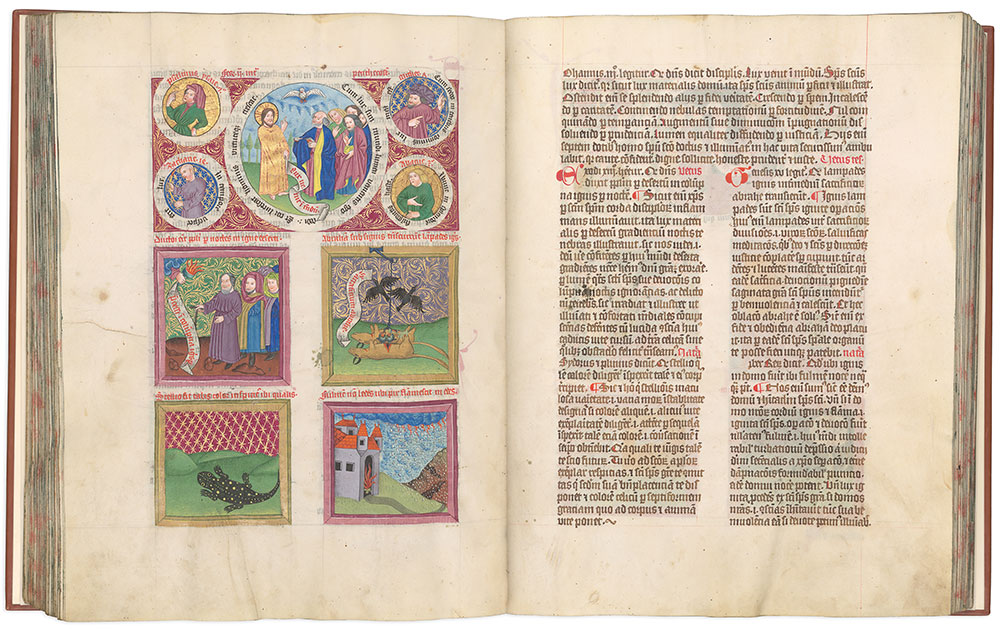
HISTORIES OF SALVATION
This compendium systematically links prefigurations from the Old Testament and the natural world to their Christian realizations in the New Testament. At top, for example, the principal scene is Christ telling Nicodemus that light has come into the world. Directly below are two scriptural prefigurations: Moses and the Israelites led by a pillar of fire, and God’s covenant with Abraham. There follow two examples from natural history: a chameleon, and a burning house in a hailstorm. Just as the lizard takes on the color of its surroundings, so an observer can adopt exemplary behavior. Just as hail and lightning cannot harm a blazing house, so the Last Judgment cannot harm one ablaze with the Holy Spirit. This opulent copy was made for Leonhard Dietersdorfer, a cleric and imperial notary from Salzburg.
Ulrich of Lilienfeld
(ca. 1308–1358)
Concordantia caritatis (Concordance of Charity), in Latin and German
Austria, Vienna, ca. 1460
The Morgan Library & Museum, MS M.1045, fols. 120v–121r
Gift of Clara S. Peck, 1983
Jeffrey Hamburger, Kuno Francke Professor of German Art & Literature, Harvard University
The Concordance of Charity, written between 1345 and 1351 by Ulrich, abbot of the Cistercian monastery of Lilienfeld in Austria, represents the most ambitious handbook of its kind from the Middle Ages. Typological in character, the work follows the liturgical calendar. Employing types drawn from nature as well as Scripture, it incorporates a moralized bestiary into an exposition of salvation. With 248 groups of images totaling over 1,000 illustrations, it is no wonder that this opulently decorated copy commissioned by Leonhard Dietersdorfer—a cleric and notary of Salzburg as well as a master of theology—was never completed.
At the top of the page exhibited here, four prophets surround the principal subject: Christ telling Nicodemus that light has come into the world a scene selected for the Monday after Pentecost.
The lower part of the page presents four types: Moses and the Israelites led by a pillar of fire and God’s covenant with Abraham. Having been asked to sacrifice a heifer, a goat, a ram, a dove, and a pigeon, Abraham cuts them all but the fowl in half. Birds of prey descend and are driven away. Then, after sunset, “there arose a dark mist, and there appeared a smoking furnace and a lamp of fire.” The artist condenses all this into a single miniature in which the furnace and lamp hang from a hook projecting from the upper frame. Connecting both images to Pentecost is the common theme of fire descending from the heavens.
Lower still are two types drawn from natural history: on the left a chameleon; on the right, a burning house in a hailstorm. Just as the lizard takes on the color of its surroundings, so too an observer adopts the exemplary behavior of someone he sees. And just as hail and lightening do not endanger a house that is already ablaze, so the Last Judgment cannot endanger someone whose heart is already ablaze with the fire of the Holy Spirit.
Seitenstetten Gospels
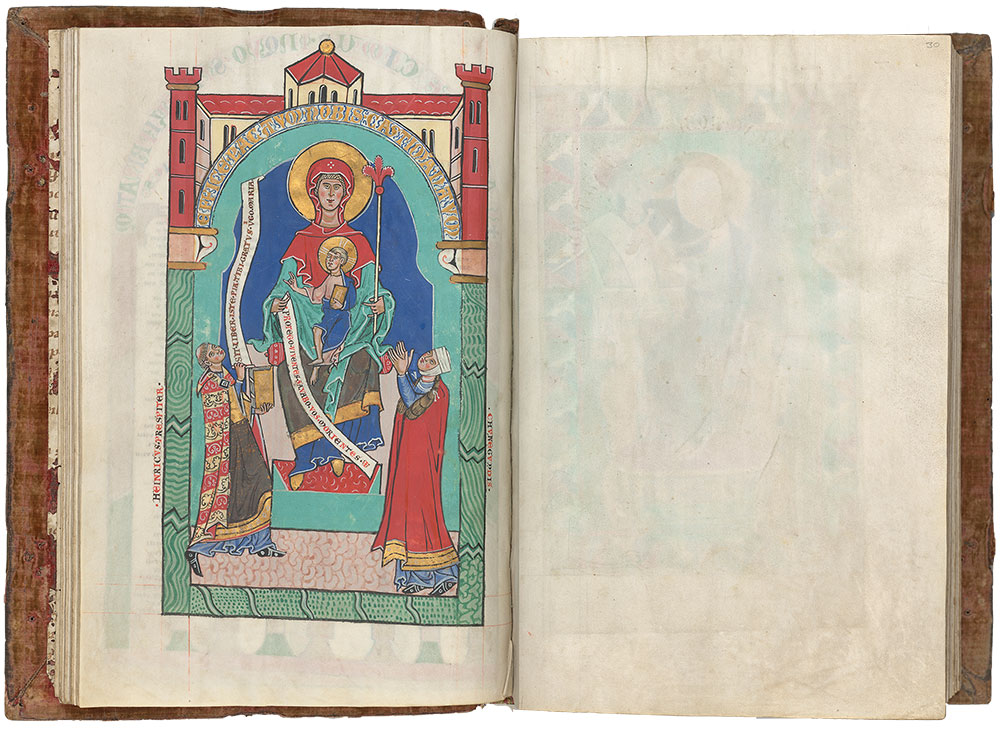
ARISTOCRATIC PATRONAGE
Established in 1112 by a local count, Udalschalk von Stille, and his brother-in-law, Reginbert, the monastery at Seitenstetten actively commemorated its founding dynasty for well over a century. When Abbot Henry (r. 1247–50) commissioned a deluxe Gospel book for the monastery, his aristocratic patrons were featured prominently in its decorative program, as was Henry himself. In the dedication miniature shown here, Henry (Heinricus) and a noblewoman offer their book to an enthroned Virgin and Child. Henry is identified as a priest, suggesting that this commission may slightly predate his rule as abbot. The woman is identified as Cunigunde (Chunegundis), who is attested in contemporary sources as the widow of Otaker von Stille and thus a member of the dynasty.
"Seitenstetten Gospels," in Latin
Austria, Seitenstetten (?), ca. 1247
The Morgan Library & Museum, MS M.808, fol. 29v
Purchased, 1940
Seitenstetten Missal

ARISTOCRATIC PATRONAGE
In 1254, the monastery at Seitenstetten burned to the ground. Circumstances were so dire that the archbishop of Salzburg intervened, granting indulgences, or the forgiveness of sins, for anyone offering financial support to the monks. As the well-connected son of the duke of Silesia, Archbishop Ladislaus (ca. 1237–1270) came to Salzburg via Padua, where he had studied at the renowned university. He likely played a role in the commissioning of this missal, coinciding with the rededication of the monastery. Of the manuscript’s three local artists, the one responsible for this diptych of the Virgin and Child with a facing Crucifixion demonstrates firsthand knowledge of contemporary Paduan painting, which must have been facilitated by the archbishop’s connections. The donor at the foot of the Virgin is likely the abbot of Seitenstetten.
"Seitenstetten Missal" (Gradual, Sequentiary, Sacramentary), in Latin
Austria, Salzburg, ca. 1265
The Morgan Library & Museum, MS M.855, fols. 110v–111r
Purchased from Mrs. Edith Beatty, 1951
Leaf from the Arenberg Psalter

ARISTOCRATIC PATRONAGE
Arranged in a double-tiered format, this leaf from a deluxe psalter depicts the Flagellation of Christ and the Crucifixion set against a solid gold background. The unusual frame heightens the drama of the narrative. Grammatical clues in the manuscript’s Latin prayers indicate that it was created for a woman, perhaps as a gift for the wedding of Helen, the daughter of Duke Otto of Brunswick, to Hermann II of Thuringia. This book marks the emergence of a new style of painting known as Zackenstil (Zigzag style), derived in part from Byzantine and Venetian art, and characterized by thick, jagged folds of drapery that defy gravity. This new style spread quickly throughout the empire, becoming a standard mode of figural representation across all artistic media.
Leaf from the “Arenberg Psalter,” in Latin
Germany, Hildesheim, ca. 1239
Art Institute of Chicago
Purchased on the S. A. Sprague Fund, 1924.671
Psalter (MS Ludwig VIII 2)
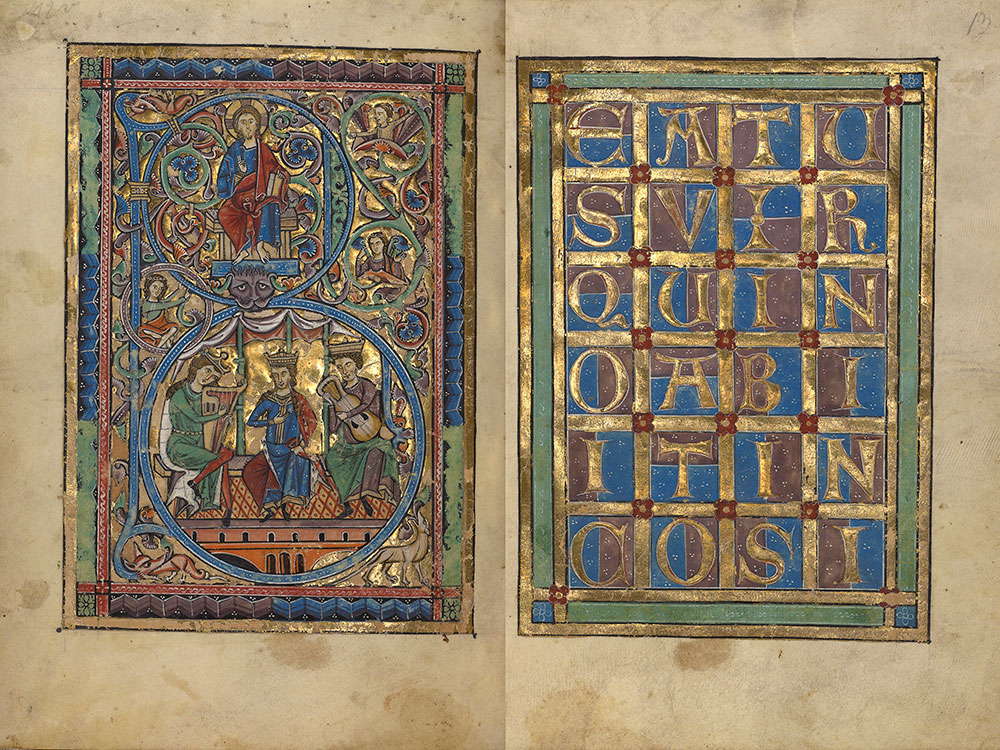
ARISTOCRATIC PATRONAGE
Würzburg was the site of an active workshop of professional illuminators around the middle of the thirteenth century. Working for monasteries and nobility, Christians and Jews, these lay painters were familiar with slightly earlier, aristocratic works like the “Arenberg Psalter.” Although the intended recipient of this deluxe book of Psalms remains unknown, it counts among the earliest and most lavish products of the workshop. Featuring the opening words of Psalm 1 spread across two pages, the double frontispiece begins with a large letter B at left, in which Christ sits enthroned above a seated King David, who is flanked by musicians. Unusually, the facing page presents the remaining letters in a golden grid, enhancing the sacred text.
Psalter, in Latin
Germany, Würzburg, ca. 1240–50
J. Paul Getty Museum, Los Angeles, MS Ludwig VIII 2, fols. 11v–12r
Purchased by the J. Paul Getty Museum, 1983
Prayer Book (MS M.739)
ARISTOCRATIC PATRONAGE
This prayer book, which conceivably belonged to St. Hedwig, features a vast prefatory cycle of approximately 160 Old and New Testament scenes, framed by inscriptions in German. These narrative scenes are depicted in unusually elaborate detail. The story of Susannah and the Elders, for example, begins at upper left with the heroine physically accosted by two older men, then falsely accused of adultery before a judge. Below, a young Daniel intercedes on her behalf, interrogating the elders. Finally, as punishment for their false witness, the men are stoned to death. The story of Daniel continues on the facing page. This elaborate tale of virtue in the face of corruption may have had special appeal to the book’s first, female owner.
Prayer Book (Cursus sanctae Mariae virginis), in Latin and German
Germany, Bamberg (?), ca. 1204–19
The Morgan Library & Museum, MS M.739, fols. 18v–19r
Purchased, 1928
Hedwig Codex
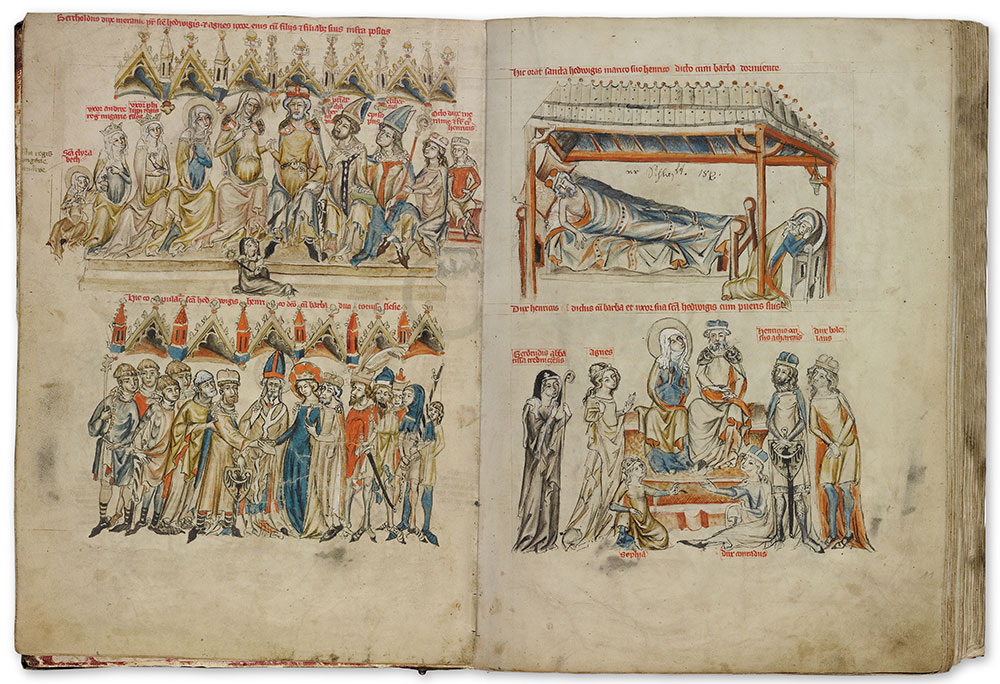
ARISTOCRATIC PATRONAGE
In 1203, Duke Henry I of Silesia (d. 1238), from the Piast dynasty, and his wife, Hedwig of Andechs (d. 1243), founded the Cistercian convent of Trebnitz (Trzebnica). Hedwig would retire there as a widow. For centuries thereafter, all the convent’s abbesses were princesses of the Piast dynasty. This manuscript reproduces the dossier in support of Hedwig’s canonization, which occurred in 1267. Depicting episodes from her life and tracing her family history, its drawings provide emblematic images of aristocratic piety and of female piety in particular. At left is the family of Hedwig’s father, Berthold IV of Andechs, and, below, the union of Hedwig and Henry I, who, following the birth of their children, had a chaste marriage. The first scene on the facing page depicts Hedwig praying while her husband sleeps. The scene below depicts the couple with their children.
"Hedwig Codex," in Latin
Written by Nicolaus of Prussia for Duke Ludwig I of Liegnitz and Brieg
Poland (Silesia), 1353
J. Paul Getty Museum, Los Angeles, MSMS Ludwig XI 7, fols. 10v–11r
Purchased by the J. Paul Getty Museum, 1983
Der wälsche Gast (The Italian Guest)

ARISTOCRATIC PATRONAGE
Written around 1215–16, The Italian Guest is the sole surviving poem by Thomasin von Zerclaere, a canon at the court of the German-speaking patriarch of Aquileia in Friuli (northern Italy). The work seeks to educate noblemen in the rules and norms of courtly love, chivalry, ethics, rulership, and good manners. The illustrations constitute a critical part of the work’s didactic program and enhanced its appeal to lay readers. At left, personifications of vices rob a nobleman of his clothing. At right, Justice, Nobility, and Courtliness join hands in a circle; a second miniature shows the winners and loser of backgammon, a critique of gambling. This copy was commissioned by Kuno von Falkenstein (1320–1388), archbishop elector of the imperial city of Trier.
Thomasin von Zerclaere
Der wälsche Gast (The Italian Guest), in German
Germany, Trier, ca. 1380
The Morgan Library & Museum, MS G.54, fols. 24v–25r
Gift of the Trustees of the William S. Glazier Collection, 1984
Jeffrey Hamburger, Kuno Francke Professor of German Art & Literature, Harvard University
Aristocratic patronage made its mark on secular illustration, as exemplified by The Italian Guest, a didactic poem written around 1215–16. The sole surviving work of Thomasin von Zerclaere a canon at the court of the German-speaking patriarch of Aquileia in Friuli at the northern end of the Adriatic Sea, it seeks to educate noblemen in the rules and norms of courtly love, chivalry, ethics, rulership, and what we would call good manners. The poem reflects the perceived need to lend the court, which by the thirteenth century had emerged as a cultural center independent of ecclesiastical control, its own ethical rationale. The illustrations, which comprise as many as 125 separate subjects, constitute a critical part of the work’s didactic program and certainly enhanced its appeal to lay readers. This fourteenth-century copy of the work made for Kuno von Falkenstein, the archbishop-elector of the Free Imperial City of Trier, speaks to its crossover appeal to both clerical and aristocratic audiences.
The three miniatures on this opening, indebted in style to contemporary French illumination, focus on the Virtues and Vices. Rather than prefacing sections of the text, the images have been inserted directly into the relevant passages of the narrative, enhancing their immediacy.
The first, on the verso, shows a nobleman robbed of his clothing by personifications of the vices, literally stripping him of his nobility. Kneeling below the unfortunate noble is a personification of Wickedness; to the right stand two women exemplifying Deceit and Inconstancy.
Two miniatures on the facing page represent, respectively, the affinity among Justice, Nobility, and Courtliness—expressed by means of their joining hands in a circle—and, in a scene reminiscent of later genre paintings, the winners and loser of a board game, in this case backgammon, a critique of gambling. Whereas the loser has lost even his clothes and bewails his blindness, his opponents exclaim, “See how he cries out!” Harking back to famous literary heroes, Thomasin asks: “Where are Erec and Gawain, where are Parzival and Iwein? . . . The virtuous people are all hidden away.”
Weltchronik (World Chronicle)

ARISTOCRATIC PATRONAGE
The 243 illustrations in this copy of Henry of Munich’s World Chronicle entertained and edified aristocratic readers. As part of the work’s expansive paraphrase of Jewish scripture in German verse, one miniature shows King David battling the Philistines; the other shows David playing his harp and followed by trumpeters, leading the ark of the covenant back to Jerusalem. When the oxen hauling the ark stumbled, Uzzah, the son of Abinadab, sought to steady it with his hand, in violation of the law, and was immediately struck down, as seen at the center. The oblong formats spanning both text columns lend the images narrative thrust. While depicting distant historical events, the lively miniatures would have evoked contemporary military customs and courtly pageantry for the manuscript’s readers.
Henry of Munich
Weltchronik (World Chronicle), in German
Germany, Regensburg, ca. 1360
The Morgan Library & Museum, MS M.769, fols. 181v–182r
Purchased, 1931
Imperial Cities
15th–16th Century
The term “free imperial city” (Reichsstadt) was coined in the fifteenth century, but the concept had roots extending back for centuries. Such cities were free from any territorial lord, secular or religious. They answered only to the emperor, who in turn granted the cities special privileges such as the right to mint coins, organize militias, and, most importantly, collect taxes and hold market fairs. Tied to vast commercial networks, these fairs enabled cities like Augsburg, Nuremberg, and Mainz to become hubs for skilled artisans, who produced luxury goods including books, both printed and handwritten. The development of these cities led to profound changes in patterns of artistic patronage, particularly when it came to making works for the open market. Imperial cities proudly proclaimed their status through a variety of visual media, from seals to public monuments. Their wealthy families competed with one another for attention in civic and religious arenas, all of which spurred artistic innovation and rivalry. Commerce and creativity went hand in hand.
Bible of Andreas of Austria

PRAGUE: A NEW CAPITAL
Named after its scribe, Andreas, this Bible was illuminated by four artists, a complex collaboration typical of court production in Prague during the reign of Emperor Wenceslas IV (r. 1376–1400). Its intended recipient was likely the scribe’s benefactor, William of Hasenburg (d. 1393), who had close ties to court and to the August-inian monastery at Roudnice nad Laben, the country seat of Prague’s archbishops. Marking the beginning of Genesis, the large initial I comprises seven medallions depicting Creation. The uppermost conflates the first and fourth days: the separation of light and dark and the creation of the sun, moon, and stars. The second roundel shows Earth, at center, surrounded by bands representing water and air. Together, the two medallions refer in schematic fashion to the cosmological system devised by Ptolemy (ca. 100–170), whose works were familiar at the court of Wenceslas due to the monarch’s obsessive interest in astrology.
"Bible of Andreas of Austria," in Latin
Written by Andreas of Austria for William of Hasenburg (d. 1393)
Czech Republic (Bohemia), Prague or Roudnice nad Laben, 1391
The Morgan Library & Museum, MS M.833, fols. 4v–5r
Purchased on the Belle da Costa Greene Fund, 1950
Jeffrey Hamburger, Kuno Francke Professor of German Art & Literature, Harvard University
The flourishing court culture at Prague attracted scholars and craftsmen from all corners of the Empire. One such scribe, Andreas of Austria, names himself in the colophon he added to this giant bible, dated 1391.
Although Andreas did not write the entire bible himself, his having taken credit for the whole suggests that the volume was his gift to a patron. That patron may well have been William of Hasenburg, father of a future archbishop of Prague, who may have had ties to the nearby Augustinian monastery at Roudnice nad Labem, a country seat for the archbishops where the bible may have been made.
The large initial I for Genesis belongs to a type coined in the late eleventh century. Occupying six vertically disposed medallions (one for each day of Creation),the Hexameron towers above the figure of Christ-Logos enthroned among angels, resting on the seventh day. Such scenes of Creation usually run from bottom to top, like a stained-glass window, with God crowning the image. Here, however, the direction has been reversed.
Such Genesis initials offered opportunities for cosmological speculation. The uppermost medallion conflates the first and fourth days: the separation of light and dark and the creation of the sun, moon, and stars. Against a celestial background filled with angels, the Christ-Logos blesses a celestial orb on whose circumference sit the sun and moon. The sphere below, split into quadrants by large cracks, represents the four elements. In the second medallion, the Earth is surrounded by offset circles of water and air. Together, the two medallions refer in schematic fashion to the system devised by Ptolemy, whose works were familiar at the court of Emperor Wenceslas on account of his obsessive interest in astrology.
Leaf from the Seitenstetten Antiphonary

PRAGUE: A NEW CAPITAL
This leaf from a dismembered choir book exemplifies the “Beautiful Style” in Prague, associated with the court of Emperor Wenceslas IV. The initial for Christmas depicts the Virgin Mary kneeling before the Christ Child, surrounded by a mandorla of light. Both details relate to a vision of Christ’s birth experienced by St. Birgitta of Sweden (1303–1373). In the margin, a Benedictine monk imitates the Virgin’s pose, holding a scroll that reads “Pray for us to God.” The manuscript was likely part of a set donated to a Benedictine monastery by an unidentified patron, who must have come from the highest echelons of the court. His orange garments as depicted within another initial from the book (shown below) indicate that he was not a cleric.
Leaf from the “Seitenstetten Antiphonary,” in Latin
Czech Republic (Bohemia), Prague, ca. 1405
Cleveland Museum of Art
Andrew R. And Martha Holden Jennings Fund, 1976.100
Adoration of the Magi and Dormition of the Virgin
PRAGUE: A NEW CAPITAL
Painted in a style derived from Bologna, this diptych demonstrates Prague’s close ties to Italy. Emperor Charles IV corresponded with the humanist Petrarch and even brought him to the city. Prague’s humanists, among them Jan of Středy (1310–1380), chancellor to Charles IV, received their education in Padua and Bologna. On the left panel, the central magus, with the imperial eagle on his mantle, bears the distinctive features of Charles IV. In the Dormition, St. Peter’s threefold tiara identifies him as pope. The two wings of the diptych thus balance imperial and papal power. The pope to which the diptych refers would be Innocent VI (r. 1352–62).
Adoration of the Magi and Dormition of the Virgin
Czech Republic (Bohemia), Prague, ca. 1360
The Morgan Library & Museum, AZAZ 22
Purchased by J. P. Morgan, Jr., 1931
Prayer Book of George of Poděbrady

PRAGUE: A NEW CAPITAL
Commissioned by Joanna of Rožmitál (d. 1475) for her husband, King George of Poděbrady (1420–1471), this prayer book opens with a small image of the king at his devotions, at right. The page is nearly overwhelmed by the lush, old-fashioned border decoration, which includes five coats of arms identifying the king’s territorial holdings. Added a decade later, the full-page miniature of the Virgin and Child was painted by Valentin Noh, who based many of his compositions on engravings. The miniatures added to George’s prayer book testify to the increasing importance of prints as a means of disseminating ideas and to the lively interplay across different artistic media. The prayer book is written in Czech, unsurprising given the king’s Hussite sympathies.
"Prayer Book of George of Poděbrady," in Czech
Illuminated by Valentin Noh and the Master of the Schellenberg Bible
Czech Republic (Bohemia), Prague, 1466 and ca. 1470s
The Morgan Library & Museum, MS M.921, fols. 2v–3r
Gift of the Fellows, with funds from the Belle da Costa Greene Fund, 1965
Office for the Feast of Corpus Christi

VIENNA: IMPERIAL RIVALRY AND HABSBURG AMBITION
Containing the prayers for the Feast of Corpus Christi, this manuscript was presented to Duke William of Habsburg shortly after his 1401 marriage to the Neapolitan princess Joanna of Anjou, whose arms appear at the center of the frontispiece’s lower register. Above, the kneeling duke, who wears a distinctive Rudolphine crown, adores the body of Christ in the facing initial. The attendant behind him is perhaps his privy notary, Leonhard Stubier (d. 1446), who may have commissioned the manuscript as a gift. Likely master and assistant, the book’s two artists worked in a cosmopolitan, courtly style characterized by conspicuous richness. The verdant meadow in which the duke kneels looks more like a luxurious millefleur tapestry than an inhabitable space.
Thomas Aquinas (1225–1274)
Office for the Feast of Corpus Christi, in Latin
Illuminated by Nicholas of Brno and the Lyra Master for Duke William of Habsburg (1370–1406)
Austria, Vienna, ca. 1403–6
The Morgan Library & Museum, MS M.853, fols. 1v–2r
Gift of Louis M. Rabinowitz, 1951
Death of St. Clare

VIENNA: IMPERIAL RIVALRY AND HABSBURG AMBITION
This panel formed part a diptych, likely made for the aristocratic convent of Poor Clares in Vienna, and probably used in Masses for the dead. Depicted at the moment of her death and surrounded by female saints, St. Clare is compared to the Virgin Mary, whose death forms the subject of the second panel. In addition to the saints, two nuns are shown below in prayer. In its mannered delicacy and decorative brilliance, the panel represents the cosmopolitan court styles that marked the turn of the century, not only in Paris and Prague but also in Vienna. In addition to the punchwork that enlivens the gold ground, the painting includes striking passages in which colored varnishes emulate textile patterns.
Death of St. Clare
Master of Heiligenkreuz
Austria, Vienna (?), ca. 1400–1410
National Gallery of Art, Washington, DC
Samuel H. Kress Collection, 1952.5.83
Missal for the Collegium Ducale
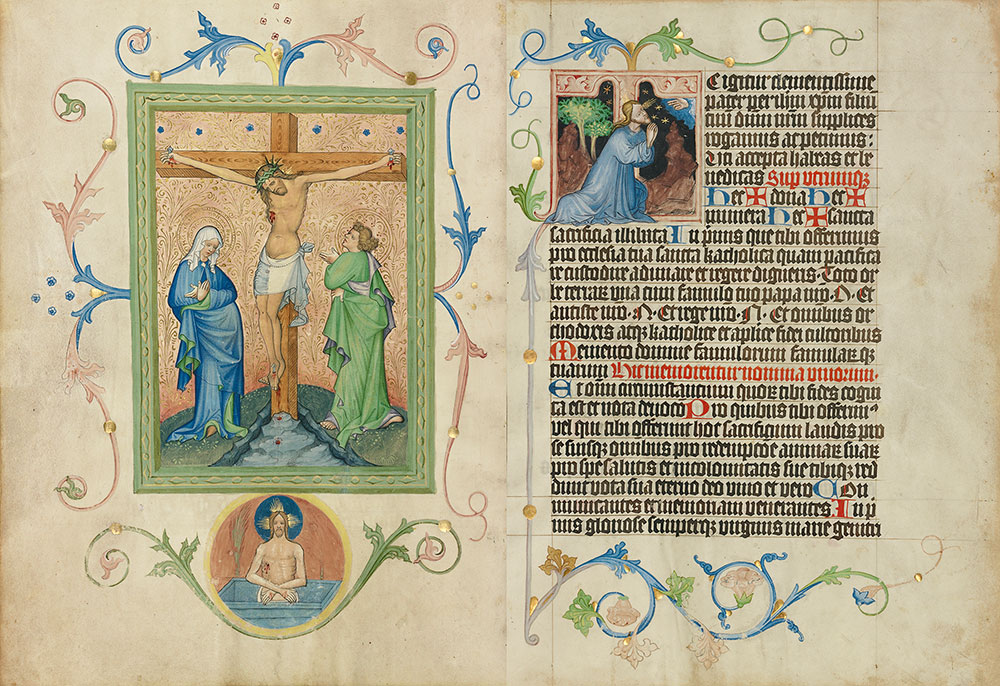
VIENNA: IMPERIAL RIVALRY AND HABSBURG AMBITION
This Mass book may have been commissioned as an imperial gift to the college of theology at the University of Vienna. In the Crucifixion, the figures of Mary and John are elongated and contorted, in dramatic contrast to the placid figure of Christ, whose blood flows copiously from his feet. Below the Crucifixion, a smaller image of Christ as the Man of Sorrows was intended for the priest to kiss during Mass. At right, an initial T marks the beginning of the Eucharistic prayer. The embedded depiction of Christ in the Garden of Gethsemane omits any narrative elements, focusing solely on Christ in prayer. The facing miniatures were painted by two different itinerant artists who regularly collaborated on important commissions.
Missal for the Collegium Ducale, in Latin
Illuminated by the Master of the Kremnitz Stadtbuch and Master Michael
Austria, Vienna, ca. 1420–30
J. Paul Getty Museum, Los Angeles, MS Ludwig V 6, fols. 147v–148r
Purchased by the J. Paul Getty Museum, 1983
Jeffrey Hamburger, Kuno Francke Professor of German Art & Literature, Harvard University
As the seat of Habsburg rule, Vienna became an important artistic center. Its court, which included a powerful patrician class, its churches, and its university all had need for elaborately illuminated manuscripts. Commissioned in the early fifteenth century, this unusually large missal belonged to the Collegium Ducale, the college of theology at the University of Vienna. T
The opening on display stems from two artists. An anonymous craftsman contributed the Crucifixion of the left, whose prominent frame resembles a panel painting. The other artist, known only as Master Michael, painted the scene of the Agony in the Garden in the initial on the facing page. The scene is self-referential in that it provides the priest celebrating mass a model for his own prayer.
Set off by symmetrical acanthus in alternating blue and pink—a hall mark of both Bohemian and Austrian manuscripts of the period—the Crucifixion is paired with an osculatory of Christ as the Man of Sorrows, a small image for the priest to kiss during mass. In the main miniature, the figures of Mary and John are not only elongated and hipshot, but also contorted, in dramatic contrast to the placid figure of Christ. Although John turns his left shoulder to the viewer, his right hand, grasping his garment, occupies the foreground; his left arm, which wraps around his twisting torso, all but disappears, lending still greater emphasis to the almost disembodied hand gesturing toward the body of Christ.
Of the three figures, that of the dead Christ is the most restrained. His loincloth seems about to slip from his partially revealed groin. Christ’s blood flows copiously from his feet, forming not one, but two separate pools, as it drips down from one level of the rocky outcrop to the next. The motif implies that with time the blood will flow out of the image into the chalice on the altar.
Leaf from a Missal (MS M.936)

VIENNA: IMPERIAL RIVALRY AND HABSBURG AMBITION
The court style in Prague carried with it enormous prestige and was often emulated in Austria. Numerous artists from Prague also fled the city in the wake of the Hussite wars (1419–34), further contributing to the widespread influence of their art. The lyrical figural style of this miniature, as well as its abundant gold filigree, points to Bohemian models. The unknown artist, who may well have been Bohemian, also looked to sculptural models like the “Beautiful Madonnas” that were exported from Prague across central Europe. The artist transmutes the pain and violence of the Crucifixion into a poetic mood, enhanced by Mary’s direct gaze, entreating the viewer to share in her compassion.
Leaf from a Missal
Bohemia or Austria (?), ca. 1425
The Morgan Library & Museum, MS M.936
Bequest of Herman H. Lehman, 1968
Book of Hours
VIENNA: IMPERIAL RIVALRY AND HABSBURG AMBITION
More than sixty manuscripts attest to the prolific career of the Master of the Maximilian Schoolbooks, who worked for a range of elite clients, including the University of Vienna and the court of Emperor Frederick III (1415–1493). The artist is named after a group of illuminated schoolbooks commissioned for the emperor’s son Maximilian I (1459–1519). While many of the book’s paintings have been removed and sold, it retains a miniature of Christ Carrying the Cross. The city gate frames the Virgin, at whose feet Simon of Cyrene bends to assist Christ with his burden. One of the soldiers turns back to push the Crown of Thorns onto Christ’s brow. In an excised miniature depicting the Nailing of Christ to the Cross, Christ looks down toward the skull marking the site as Golgotha (literally, “the place of the skull”). According to legend, the skull belonged to Adam; his son Seth planted a seed in the skull’s mouth that grew into the tree from which the cross was hewn.
Book of Hours, in German
Illuminated by the Master of the Maximilian Schoolbooks
Austria, Vienna, ca. 1465
Walters Art Museum, Baltimore, MS W.764, fols. 66v–67r
Purchased, 1959
Leaf from the Same Book of Hours
Cleveland Museum of Art
Dudley P. Allen Fund, 1959.40
Leaf from an Antiphonary

MAINZ: ECCLESIASTICAL CAPITAL AND CRADLE OF PRINTING
Although little is known about its original context, this leaf once formed part of an antiphonary—a collection of chants—nearly identical to a set of choir books created around 1432 for the Carmelite monastery at Mainz. Those books were commissioned by Johannes Fabri, the son of a goldsmith and stepson of a butcher, who likely donated the set to mark his admission to the monastery, where he would eventually become prior. Instructions for creating the twisting, multicolored vine-scroll ornament survive in contemporary model books used by professional painters. Marking the beginning of a feast in Advent, the large initial M and its foliate decoration showcase exactly what the new technology of printing was not capable of doing.
Leaf from an Antiphonary, in Latin
Germany, Mainz, ca. 1430–50
Metropolitan Museum of Art, New York
Gift of Miss Alice M. Dike, in memory of her father, Henry A. Dike, 1928.225.2
The Gutenberg Bible
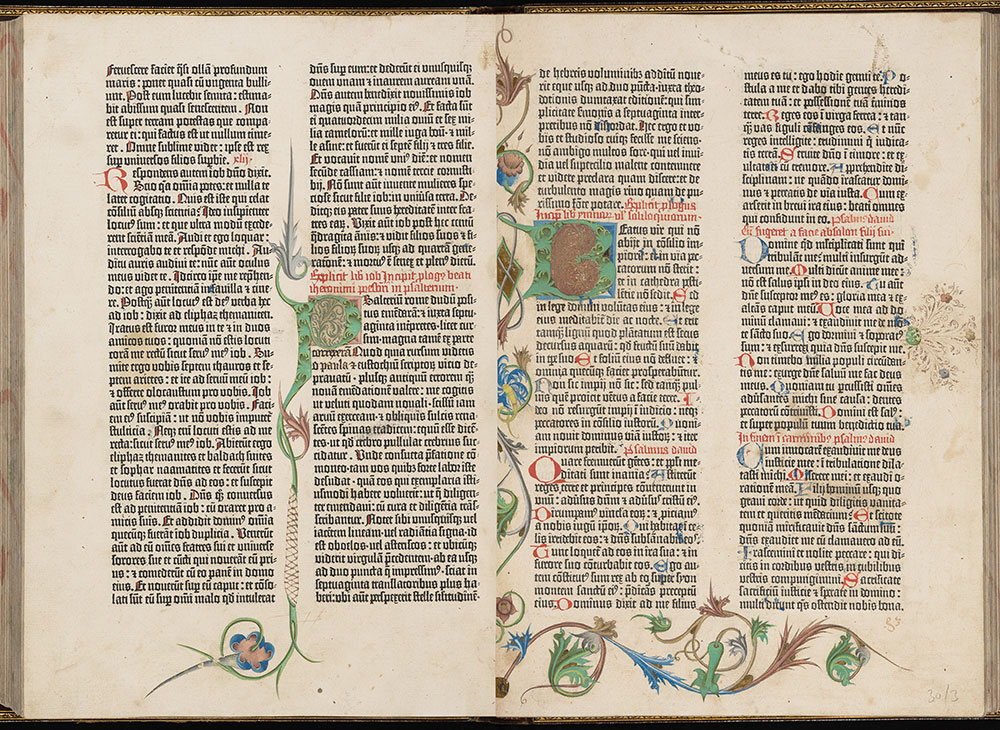
MAINZ: ECCLESIASTICAL CAPITAL AND CRADLE OF PRINTING
The earliest mention of printed books in Europe is a 1455 letter sent to Emperor Frederick III (1415–1493), describing what must have been copies of the Gutenberg Bible for sale at the imperial Diet in Frankfurt. Several years earlier, Johann Gutenberg (ca. 1400–1468) had begun working with his financial backer, Johann Fust (d. 1466), to develop a printing press with moveable type (metal-cast letters), able to produce multiple copies of a text. Their now-famous two-volume Bible was issued in an edition of approximately 180 copies. Imitating the old-fashioned textura script of Gothic manuscripts, Gutenberg attempted to compete with deluxe, handmade commissions. In 1455, a bitter lawsuit ended Fust and Gutenberg’s relationship. The financier continued to run a successful press with Gutenberg’s former assistant, Peter Schoeffer (d. 1503). Later adapted to contain just the Old Testament, this unique copy of Gutenberg’s Bible served as the model for Fust and Schoeffer’s 1462 Bible. Its illumination was added around that time by an artist from Mainz who worked exclusively in Fust’s workshop.
Gutenberg Bible, in Latin
Mainz: Johann Gutenberg & Johann Fust, ca. 1455
The Morgan Library & Museum, PML 12, fols. 292v–293r
Purchased by J. Pierpont Morgan with the Irwin Collection, 1900
Jeffrey Hamburger, Kuno Francke Professor of German Art & Literature, Harvard University
Mainz was the largest and most powerful archbishopric in central Europe. Its archbishop
became not simply one of the ecclesiastical electors, but also archchancellor of the Empire, with the right to convene and lead elections of the king of Germany. Gutenberg, a citizen of Mainz, set up his print shop there no later than 1450 and by 1455 the Gutenberg Bible, the first Western book printed from moveable type, was published in approximately 160 to 180 copies.
Gutenberg’s investment in the production of a large-format folio bible was hardly self-evident. Despite the paramount importance of the text, the market for complete bibles, as opposed
to liturgical books, was limited.
The Morgan Library, exceptionally, holds three copies of the Gutenberg Bible, two of them complete. One of these belongs to the limited number printed on vellum; another belongs to the majority that were printed on rag-linen paper.
The Morgan’s third copy, exhibited here, is unusual on several counts. Unlike most copies of the Gutenberg Bible, which split the text evenly across two volumes at the end of the Psalms, this copy comprises just the Old Testament in a single volume—likely a later modification. Twenty-two of its pages feature a unique set of replacement type settings, which indicate that the copy was produced at the very end of the print run. Finally, it also contains the earliest extant compositor’s marks (typesetters’ indications of pagination) introduced when it was used as a model by Fust and Schoeffer, formerly Gutenberg’s financial backer and apprentice, respectively, to print their own bible in 1462.
In copies of the Gutenberg Bible, most of the decoration had to be added by hand and remains modest compared to sumptuous illuminated manuscripts of the period, which competed with printing by supplying precisely what printers were not in a position to provide—namely, elaborate imagery in brilliant color.
Gospel Book

MAINZ: ECCLESIASTICAL CAPITAL AND CRADLE OF PRINTING
The Evangelist portraits in this Gospel book have traditionally been attributed to the so-called Housebook Master. However, this artistic personality is better understood as a group of artists active along the Middle Rhine. Their miniatures respond to developments in contemporary panel painting, particularly from Flanders, as demonstrated in this portrait of the evangelist Matthew, which features a clearly constructed space with receding floor tiles and obliquely placed objects that cast shadows. Also telling in this regard is the absence of extensive border decoration. By the mid-fifteenth century, manuscript illumination had to compete not only with panel painting but also with printing.
Gospel Book, in Latin
Illuminated by circle of the Housebook Master
Germany, Middle Rhine, ca. 1475–80
Cleveland Museum of Art
Mr. and Mrs. William H. Marlatt Fund, 1952.465
Leaf from the Simmern Missal

MAINZ: ECCLESIASTICAL CAPITAL AND CRADLE OF PRINTING
Another artist from the Housebook Master group painted this Crucifixion miniature from the missal of Duke Friedrich and Margarethe, elector and electress Palatine. The scene plays out against a dramatic, sweeping landscape. The stiff, still body of Christ contrasts with the contortions of the good and bad thieves surrounding him. What really catches the eye, however, besides the glittering coat of arms at the foot of the cross, is the vivid coloring of the clothed figures and the sensitive treatment of atmosphere. The fictive frame heightens the sense of a panel painting reproduced within the confines of a book.
Leaf from the "Simmern Missal," in Latin
Illuminated by circle of the Housebook Master
Germany, Middle Rhine, ca. 1481–82
Metropolitan Museum of Art, New York
Robert Lehman Collection, 1975.1.2479
History of Alexander the Great
AUGSBURG AND BAVARIA
This manuscript comprises religious and historical texts in German, including History of Alexander the Great by the physician Johannes Hartlieb (ca. 1410–1468). Written on paper in a Swabian dialect by the scribe Völckhart Landsperger, the texts were chosen to suit the interests of a particular patron. Many such scribes worked as city notaries, providing a close link between civic culture and literary production. Despite the inexpensive materials, the lively pen drawings are detailed and rich in narrative. In this example, Alexander visits a beautiful mountaintop temple. Its staircase is made of gemstones supported by golden chains, a characteristic example of the text’s many wonders. The work of several artists, the book exemplifies the increasing number of paper manuscripts produced for the growing patriciate and merchant classes in Augsburg.
Miscellany, Including Johannes Hartlieb’s History of Alexander the Great, in German
Written by Völckhart Landsperger
Germany, Augsburg, ca. 1450–60
The Morgan Library & Museum, MS M.782, fol. 292r Purchased, 1934
Missal of Johannes von Giltlingen
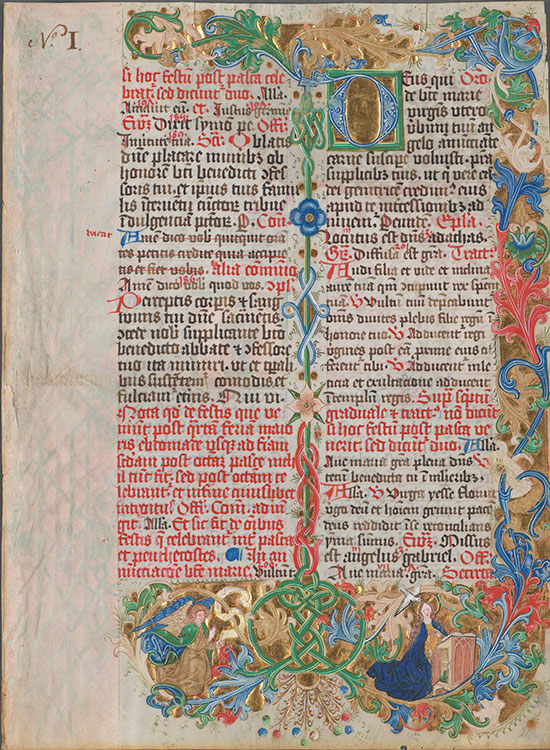
AUGSBURG AND BAVARIA
This leaf comes from a deluxe Mass book illuminated for the abbot of the imperial Benedictine abbey of Sts. Ulrich and Afra in Augsburg. As a center of the Melk monastic reform movement, the abbey produced books of all kinds. In addition to scribal, authorial, and artistic activity, the abbey housed its own press, complete with a binding workshop. Shown here is the Mass for the Feast of the Annunciation. Its accompanying miniature is not placed within the initial, as was customary, but within the foliage in the lower margin. The artist was a monk, whose brother, Leonhard Wagner, also affiliated with the monastery, was a celebrated scribe and writing master.
Leaf from the “Missal of Johannes von Giltlingen,” in Latin
Illuminated by Conrad Wagner for Johannes von Giltlingen (d. 1496)
Germany, Augsburg, 1484–85
Columbia University, Rare Book & Manuscript Library, New York, MSMS Plimpton 36B
Bifolio from a Confraternity Book

AUGSBURG AND BAVARIA
Known today primarily for his success in the early print trade, Johann Bämler began his career as a scribe and an illuminator. Featuring miniatures of the Crucifixion and St. Leonard, this bifolio, his earliest known work, once belonged to a charitable confraternity devoted to the saint. The surrounding rose-colored frames bear verse inscriptions. On the left, Bämler signed and dated the work. The prayer on the right invokes Leonard as the patron saint of prisoners seeking liberation. Working for a range of clients, Bämler’s industrious workshop captures the commercial spirit of book production in Augsburg.
Bifolio from a Confraternity Book, in Latin
Illuminated by Johann Bämler (ca. 1430–1504)
Germany, Augsburg, 1457
The Morgan Library & Museum, MS M.45
Purchased by J. Pierpont Morgan, 1902
Twenty-Four Elders

AUGSBURG AND BAVARIA
Deluxe manuscripts of the later fifteenth century often feature conspicuously large miniatures, as if rivaling panel paintings in their dimensions. As part of ambitious programs of illustration, such miniatures could distinguish a particular commission from a more standard production. This miniature derives from the most sumptuous of the surviving 169 copies of Otto von Passau’s Twenty-Four Elders—a compilation of excerpts from many authors, organized around devotional themes linked to each of the titular elders. The fifth elder is shown as a gray-bearded king, with book in hand as if an author portrait. The miniature is manifestly the work of a panel painter, underscoring the extent to which illuminators looked to other media as a source of inspiration.
Leaf from Otto von Passau's Twenty-Four Elders
Illuminated by the Master of the Munich Marian Panels
Germany, Bavaria, ca. 1450
Free Library of Philadelphia
Rare Book Department, Lewis E M 44:12
Annunciation
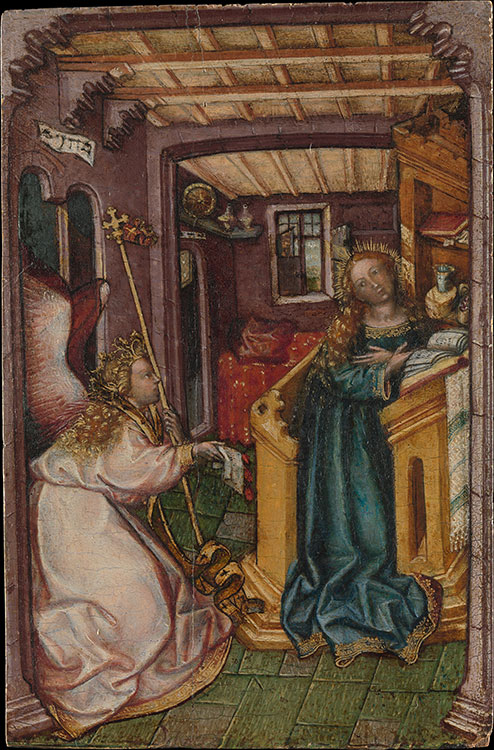
AUGSBURG AND BAVARIA
Attributable to a Bavarian artist, this panel of the Annunciation demonstrates the interrelationships between illuminators and panel painters. Following Netherlandish examples, the scene is set in a domestic interior depicted with sparkling luminosity, which bathes the scene in supernatural as well as natural light. Above the door through which the angel Gabriel enters, a Hebrew scroll reads “before” or “not yet” (b’terem), which refers here to the pending birth of Christ as the fulfillment of Jewish prophecy. Gabriel notifies Mary of the Incarnation using a charter with three seals (a reference to the Trinity), a motif found most often in Bohemian painting.
Annunciation
Germany, Bavaria (?), ca. 1450
Metropolitan Museum of Art, New York
Gift of Julie and Lawrence Salander, in honor of Keith Christiansen, 2005.103
Starck Triptych

NUREMBERG: DÜRER AND HUMANISM
Commissioned by the Nuremberg patrician Georg Starck, this triptych was painted by an artist in the circle of Hans Pleydenwurff and Michael Wolgemut, in whose workshop Albrecht Dürer was trained. Representing the Elevation of the Cross, an unusual subject for the time, the crowded scene is set against a continuous landscape, which shapes the procession to Golgotha. Under the bright sky, at Christ’s privileged right side, the Virgin, Veronica, and the grieving Magdalene gather. Under the dark clouds at Christ’s left are the witnesses, such as the mounted centurion who gestures to Christ and the thief with his arms tied behind his back, contemplating the rough-hewn cross on which he, too, will be hoisted.
"Starck Triptych”
Master of the Starck Triptych
Germany, Nuremberg, 1480–90
National Gallery of Art, Washington, DC
Patrons’ Permanent Fund, 1997.100.1.a
The Nuremberg Chronicle

NUREMBERG: DÜRER AND HUMANISM
Structured around the seven ages of the world, from Creation to the Last Judgment, the “Nuremberg Chronicle” stands in the long tradition of universal chronicles, many of which also highlight the importance of a specific city. Deliberately placed at the beginning of the sixth age, the Christian era, this view of Nuremberg presents the city as the New Jerusalem. At left are the towers of its most important parish churches: St. Sebald and St. Lawrence. The Women’s Gate occupies the left foreground, with its double-headed eagle identifying Nuremberg as an imperial city. A stele occupies the foreground alongside a group of three crosses. These features, together with the raised platform to the right, where criminals were beheaded, mark the site as a place of execution. Salvation for some presumed punishment for others.
Hartmann Schedel (1440–1514)
Woodcuts by workshop of Michael Wolgemut (1434–1519)
Liber chronicarum (“Nuremberg Chronicle”), in Latin
Nuremberg: Anton Koberger, 1493
National Gallery of Art, Washington, DC
Paul Mellon Collection, in Honor of the 50th Anniversary of the National Gallery of Art, 1991.7.1, fols. 99v–100r
Jeffrey Hamburger, Kuno Francke Professor of German Art & Literature, Harvard University
Of the Free Imperial Cities, none is better known than Nuremberg, and no artifact associated with it more famous than the extensively illustrated world history known as the Nuremberg Chronicle, compiled by the physician and Italian-trained humanist Hartmann Schedel. An immensely ambitious work, the Chronicle was commissioned by the Nuremberg merchants Sebald Schreyer and his son-in-law, Sebastian Kammermeister, and published in 1493 by Anton Koberger. The original edition was in Latin, shortly followed by a German translation.
Structured around the seven ages of the world, spanning from Creation to the Last Judgment, the Chronicle stands in the tradition of earlier universal chronicles, many of which were heavily illustrated and also carried world history forward to highlight the importance of a specific city.
Comprising over 1,800 woodcut illustrations, printed from 645 blocks, the Chronicle’s extensive visual program was executed under the supervision of the painter Michael Wolgemut, whose workshop Albrecht Dürer was trained.
Among the Chronicle’s most famous illustrations are the spectacular city views, particularly that of Nuremberg, for which a deliberate effort was made to ensure that the city—originally planned for later in the volume—would be positioned instead toward the beginning of the sixth
age, which starts with the birth of Christ. Nuremberg thus appears as the New Jerusalem.
As was common in the art of the period, the Chronicle’s city views combined precise observation with conventional motifs, both of which contribute to the making of meaning. The view of Nuremberg—the only one that fills a two-page spread to the exclusion of the main text—impresses on account of its selective accuracy. At right center, atop a high bluff at the northern periphery of the city, stands the Burg, or imperial castle, which often hosted visiting German kings and emperors. To the left can be seen the twin towers of the church of St. Lawrence, for which the Geese Book, exhibited nearby, was made.
Geese Book
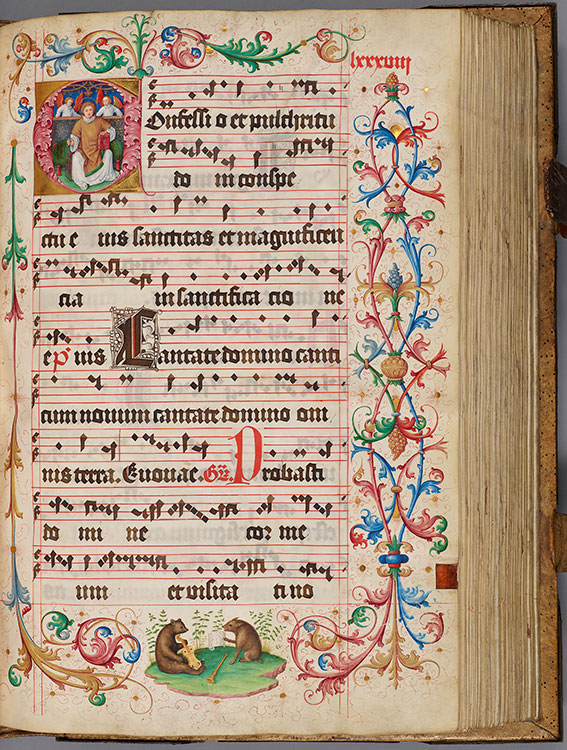
NUREMBERG: DÜRER AND HUMANISM
Prominent members of the parish of St. Lawrence in Nuremberg donated this massive two-volume gradual to their church. The imposing manuscript is known as the “Geese Book” after a humorous, self-referential scene of a wolf teaching a gaggle of geese to sing from a choir book on a podium, as a wily fox attacks them rom behind. Anton Kress (1478–1513), a member of the city council and relative of Willibald Pirckheimer, a humanist in Dürer’s circle, oversaw the manuscript’s production. Although working at a time when Dürer was the dominant artistic personality in Nuremberg, Jakob Elsner produced work that shows little debt to Dürer’s style. In the lower margin of the Feast of St. Lawrence, on view here, the shawm (woodwind instrument) lying on the ground may refer to the former braying of the swine who now sings the “new song” (canticum novum, mentioned in the opening words of the feast) while a bear plays a viol. The original pigskin binding, with metalwork from Nuremberg’s leading metalworker, is typical of German books of this period.

“Geese Book.” The Morgan Library & Museum, MS M.905, vol. 1, fol. 186r (detail).
"Geese Book," in Latin
Illuminated by Jakob Elsner
(ca. 1460–1517)
Germany, Nuremberg, ca. 1507–10
The Morgan Library & Museum, MS M.905, vol. 2, fols. 87v–88r
Gift of the Samuel H. Kress Foundation, December 1962
Jeffrey Hamburger, Kuno Francke Professor of German Art & Literature, Harvard University
Made for the church of St. Lawrence in Nuremberg in the early sixteenth century, this enormous manuscript is but one of two volumes known as the Geese Book after a whimsical, self-referential marginal image of a wolf teaching a choir of geese to sing from a choir book on a podium, while a wily fox attacks them from behind.
Other folios, such as that exhibited here, also contain satirical animal imagery. In the margin of the feast for St. Lawrence, the church’s titular saint, the shawm lying on the ground may refer to the former braying of the swine who now sings the “new song” mentioned in the accompanying chant from a sheet of music while a bear plays a viol.
A hugely ambitious project, the Geese Book was initiated by Sixtus Tucher, a member of one of the city’s leading patrician families. Tucher’s successor, Anton Kress, a member of the city’s inner council and a distant relative of the humanist Willibald Pirckheimer, Albrecht Dürer’s close friend, oversaw the bulk of its production.
The gradual was written by a vicar of the church, Friedrich Rosendorn, who is named in the volumes’ colophons. Jakob Elsner, however, the artist to whom the gradual’s decoration is attributed, goes unmentioned.
Commissions of grand manuscripts such as the Geese Book would in large part be made redundant, both by the growing predominance of printing and the spread of the Protestant Reformation, which, in keeping with the theology of Martin Luther, stressed salvation by faith alone, not by good works, which often took the form of the patronage of magnificent works of art. In this respect, the Geese Book, a product of the imperial city of Nuremberg, harks back to the grand imperial commissions of the earlier Middle Ages.
Recording from the Geese Book

“Mass for Saint Lawrence”
Das Gãnsebuch (The Geese Book), Schola Hungarica
℗ & © 2005 Naxos Rights International Ltd.
Cuttings from the Missal of Johann Stantenat
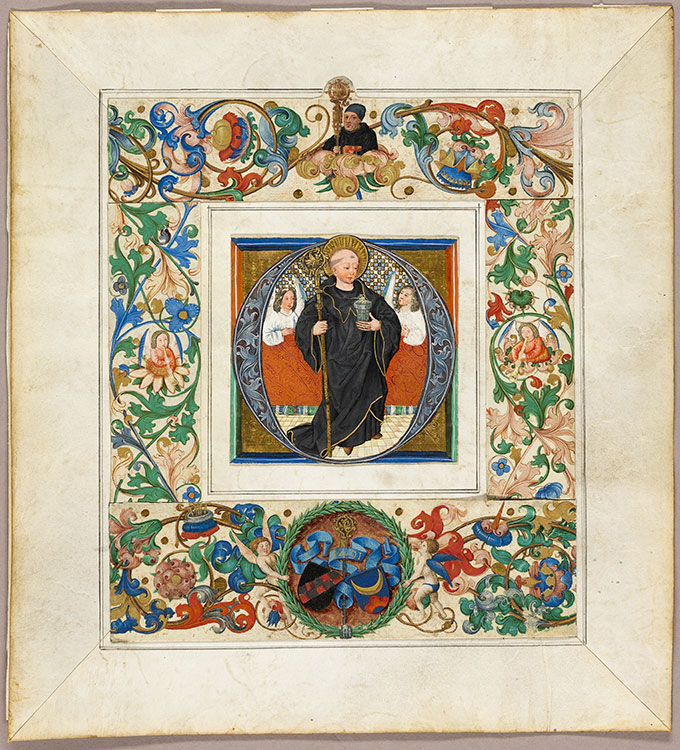
NUREMBERG: DÜRER AND HUMANISM
At some point in the nineteenth century, five cuttings from a two-volume missal were artfully arranged to form this collage. The missal was commissioned by the abbot of the Cistercian abbey at Salem, southwest of Nuremberg. At center, St. Benedict stands within a large initial O that begins the Mass for his feast day. Clad in the black habit of the Benedictines, he holds a crozier and a miraculous glass vase. By adopting the same attributes for the portrait of Abbot Stantenat above, the artist equates him with the saintly model. Below are the arms of Salem Abbey and Abbot Stantenat on either side of a crozier bearing the manuscript’s date.
Cuttings from the “Missal of Johann Stantenat”
Illuminated by the workshop of Jakob Elsner
(ca. 1460–1517) for Abbot Johann Stantenat (d. 1494) of Salem Abbey
Germany, Nuremberg, 1491
Art Institute of Chicago
Gift of Sandra Hindman, 2017.206
Leaf from a Missal (MS 52)

NUREMBERG: DÜRER AND HUMANISM
Although the narrative of the Crucifixion calls for a view of Jerusalem seen from Golgotha, the city in the background of this miniature appears to be Nuremberg. In its meticulous rendition of topographical details, the miniature rivals the drawings and watercolors that Albrecht Dürer produced while crossing the Alps on the first of his two trips to Italy (1494–95), sights from which he also incorporated into religious and allegorical subjects. Here, such details include the gabled façade of Nuremberg’s Church of Our Lady, directly behind St. John. Designed by Peter Parler, the architect of Prague Cathedral, the church was built between 1352 and 1362 by Charles IV on the site of Nuremberg’s old synagogue.
Leaf from a Missal
Illuminated by the Pleydenwurff-Wolgemut Workshop
Germany, Nuremberg, ca. 1475–1500
J. Paul Getty Museum, Los Angeles, MS 52
Purchased, 1993
Leaf from the Hohenlandenberg Missal

NUREMBERG: DÜRER AND HUMANISM
This Crucifixion scene once formed part of an immense, four-volume missal commissioned by Hugo von Hohenlandenberg, bishop of Constance. The illumination is the work of an unknown artist closely associated with Albrecht Dürer. The figures are nestled within a landscape, in which the echoing forms of the winding river and road generate a continuous recession toward the horizon. The manuscript’s patron—the bishop—kneels in the foreground with his arms occupying the lower margin. Like many of his elite peers, he fought continuously with the citizens of his city over issues of legal jurisdiction and finance, a struggle that led to his forced abdication in 1529.
Leaf from the “Hohenlandenberg Missal”
Illuminated by the Master of the Hohenlandenberg Missal for Bishop Hugo von Hohenlandenberg
(1460–1532)
Germany, Nuremberg or Constance, ca. 1510
The Morgan Library & Museum, MS M.955
Purchased as the Gift of the Fellows, with the Special Assistance of Four Members of the Board of Trustees, Mrs. Gordon S. Rentschler, and Mrs. G. P. Van de Bovenkamp (Sue Erpf Van de Bovenkamp) in Memory of Armand G. Erpf, 1973
Theuerdank (Noble Thought)

NUREMBERG: DÜRER AND HUMANISM
Written by courtiers of Emperor Maximilian I, the Theuerdank (Noble Thought) tells the allegorical story of a knight, understood to be a thinly disguised stand-in for the emperor. Along with the text, printed in an early Fraktur typeface, the book incorporates 118 woodcuts—all by pupils or followers of Albrecht Dürer. Here, the protagonist rides an unruly horse given to him by his nemesis in the hope of killing him. The hero barely manages to bring the steed under control before it plunges into the castle’s moat, shown as a river. An instrument of imperial propaganda, the book also serves as a gallery of the period’s leading graphic artists.
Melchior Pfintzing (1481–1535) and Marx Treitzsaurwein (ca. 1450–1527) Woodcuts by Leonhard Beck (1480–1542), Hans Schäufelein (ca. 1480–1540), and Hans Burgkmair (1473–1531)
Theuerdank (Noble Thought), in German
Augsburg: Hans Schönsperger, 1517
The Morgan Library & Museum, PML 20623
Emperor Maximilian I
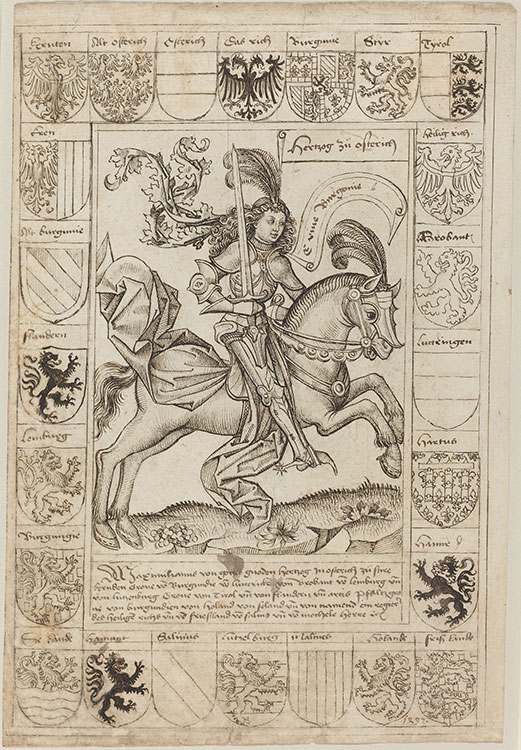
NUREMBERG: DÜRER AND HUMANISM
Hans von Hungerstein (1460–1503) had this depiction of Emperor Maximilian I as an ideal knight added to his personal copy of a popular chronicle of the city of Strasbourg by Jakob Twinger von Königshofen (1346–1420). Like the “Nuremberg Chronicle,” Twinger’s account situates Strasbourg within the histories of the world, emperors, popes, and the diocese. Hungerstein’s additions represent Maximilian’s coronation in 1486 as king of the Romans as a historical milestone. Seated on horseback like the legendary hero St. George, and surrounded by imperial coats of arms, Maximilian embodies the archetype of Christian and courtly manhood, no doubt how von Hungerstein, himself a knight, sought to be remembered.
Master of the Strasbourg Chronicle
Emperor Maximilian I
Strasbourg, 1492
National Gallery of Art, Washington, DC
Woodner Collection, Gift of Andrea Woodner, 2006.11.16
Conrad Celtis, Four Books of Love
NUREMBERG: DÜRER AND HUMANISM
Albrecht Dürer collaborated with the humanist Conrad Celtis on this patriotic work of pedagogy, which represents Germany as the legitimate inheritor of Greco-Roman learning. Celtis praised Dürer as a new Apelles (a famous ancient Greek painter). In the frontispiece at left, Dürer places his monogram, AD, at the base of the obelisk standing before Philosophy. Thus he joins the sages in the medallions who represent the cumulative wisdom of Egyptians, Chaldeans, Greeks, Romans, and the Germans. The Greek letters on the obelisk represent the seven liberal arts and form the ladder by which one ascends to Wisdom. Representing the winds, the four heads in the corners also stand for the four elements and the four bodily humors.
Another of Dürer’s woodcuts for Conrad Celtis’s book takes the form of a traditional presentation scene. Holding the wreath of a poet laureate, Celtis presents a copy of his book to Maximilian I. The enthroned emperor sits below the imperial eagle and the distinctive imperial crown. The frame employs classically inspired garlands, which in their abundance carry connotations of cornucopia (bountiful prosperity). The inscription adapts a passage from Exodus 21: “He that curseth his father [here, the emperor] shall die the death.”
Conrad Celtis (1459–1508)
Woodcuts by Albrecht Dürer (1471–1528) and others
Quatuor Libri Amorum
(Four Books of Love), in Latin
Nuremberg: Sodalitas Celticae, 1502
The Morgan Library & Museum, PML 23296
Purchased by J. Pierpont Morgan, 1906
Metropolitan Museum of Art, New York
Bequest of James Clark McGuire, 1931.54.59
Four Books on Human Proportion
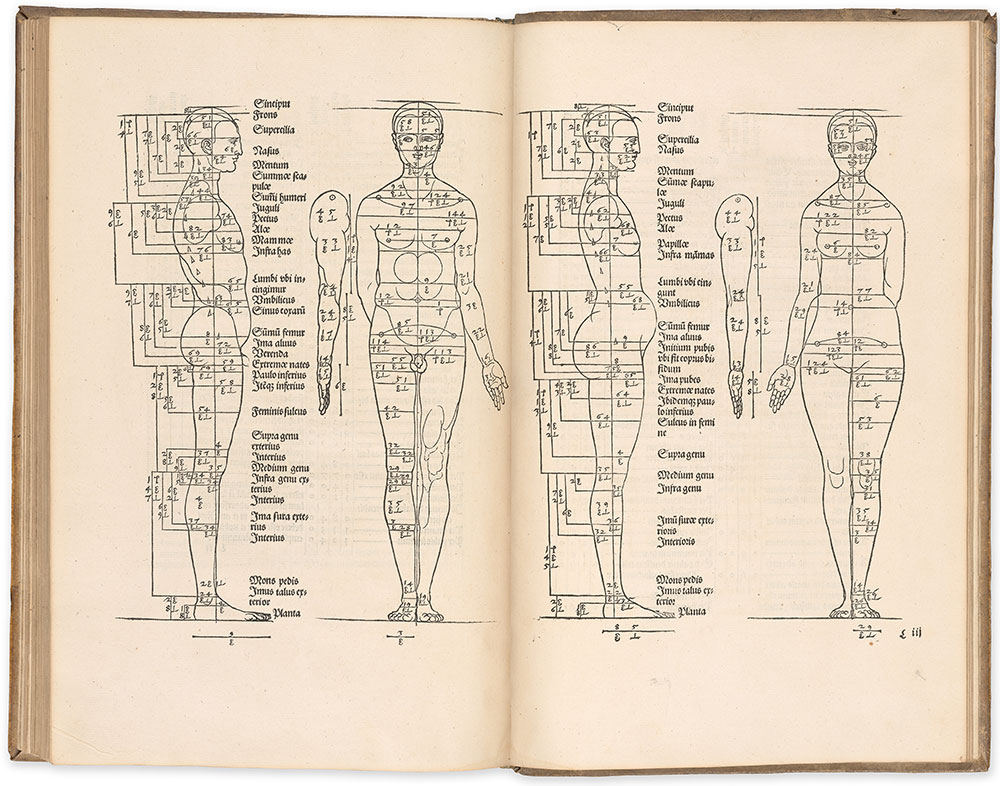
NUREMBERG: DÜRER AND HUMANISM
Dürer’s posthumous treatise on proportions codified his approach to the representation of the human body. With the volume’s roughly 150 woodcuts, including full-length studies of men and women in a variety of poses, the artist demonstrated his belief that the human body could be reduced to basic geometrical forms (lines, areas, and solids). Rather than following strict standards of idealized beauty, Dürer expanded his analysis to include various physiques of people of all sizes and ages, including children, at rest or in motion. Dürer first engaged with the topic of proportions following his travels to Italy, where artist-theorists such as Leon Battista Alberti and Leonardo da Vinci had worked extensively on the subject.
Albrecht Dürer (1471–1528)
De varietate figurarum (Four Books on Human Proportion), in Latin
Nuremberg: Agnes Dürer, 1532 and 1534
The Morgan Library & Museum, PML 77029
Gift of Mr. John P. Morgan II in memory
Albrecht Dürer, Apocalypse with Pictures
NUREMBERG: DÜRER AND HUMANISM
The Apocalypse with Pictures represents Dürer’s first major book project. First published in 1498, just prior to the Jubilee Year of 1500, it represents a self-conscious declaration of artistic genius that helped him secure international fame. Dürer’s woodcutting technique incorporates refinements associated with engraving, such as tapering lines and complex crosshatching, enabling dramatic lighting and psychological nuance. The image of John the Evangelist eating a book from an angel, at right, demonstrates the visionary effect of the artist’s innovations. The biblical text describes the angel as having one foot in the sea and the other on land, “clothed with a cloud,” and with a “face as the sun, and his feet as pillars of fire.” While faithful to the source, Dürer reimagined the scene with startling vitality.
Dürer created a new title page, above, for this second edition of his Apocalypse in 1511. Underscoring the visionary nature of the text, the scene takes place in a celestial realm. John the Evangelist takes inspiration from the Virgin and Child as he writes in his book. In addition to title pages, Dürer created colophons for his books—formal statements prohibiting anyone from copying them or their prints, and declaring his work protected under imperial privilege.
Albrecht Dürer (1471–1528)
Apocalipsis cum figuris (Apocalypse with Pictures), in Latin
Nuremberg: Albrecht Dürer, 1511
Columbia University, Rare Book & Manuscript
Library, New York, BOOKART NC251.D93 1511 B47
Title Page with the Virgin and St. John
Germany, Nuremberg, 1511
Metropolitan Museum of Art, New York
Gift of Mrs. Felix M. Warburg, 1940139.6(1)
Albrecht Dürer, The Large Passion
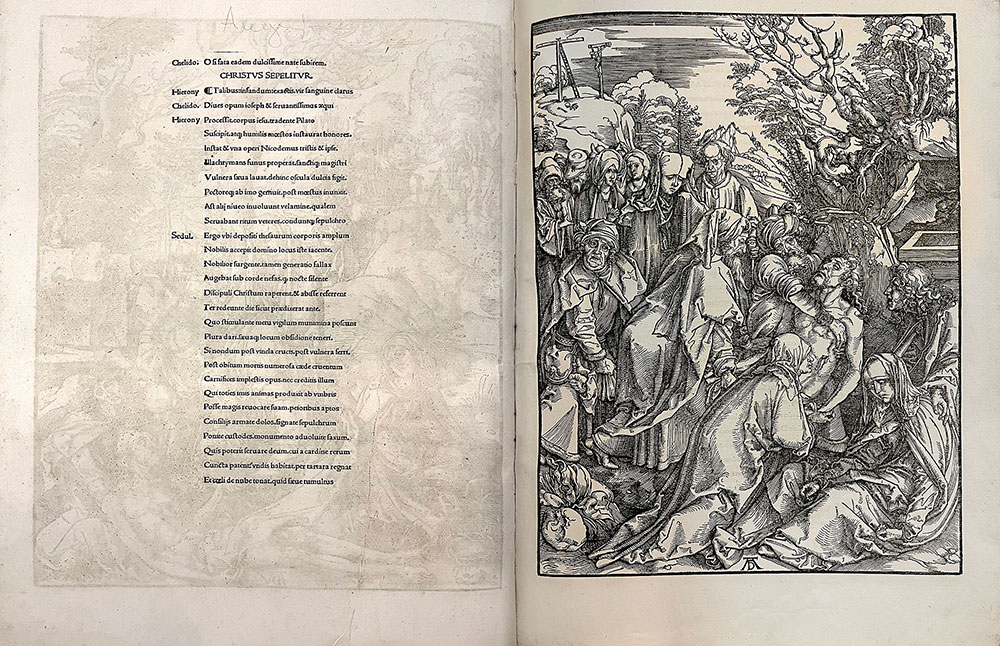
NUREMBERG: DÜRER AND HUMANISM
For Dürer, 1511 marked a period of intense engagement with commercial projects. Following on the success of his Apocalypse with Pictures, reissued that year, he produced devotional picture books designed in the same format, juxtaposing text and image on facing pages. These include the Small Passion, the Large Passion, and the Life of the Virgin—the latter two combined with the Apocalypse in this single volume, which was bound in Nuremberg and belonged to a house of pious Franciscan laywomen in Munich. With these books, Dürer created work not for a commissioning patron but for the open market. To accompany his woodcuts, he commissioned Latin poems from the humanist scholar, poet, and monk Benedict Chelidonius. Shown here, at right, is the Entombment. The tomb, however—only partly visible at the right—is tucked into the background, as is the mount of Golgotha, at upper left, whereas in the foreground, the focus remains on the mourning of Christ’s followers and disciples. The print thus both evokes a narrative continuum and invites a powerful emotional response.
Albrecht Dürer (1471–1528) and Benedict Chelidonius (ca. 1460–1521)
Passio Domini Nostri Iesu (The Large Passion), in Latin
Nuremberg: Albrecht Dürer, 1511
New York Public Library, Spencer Collection
Ger. 1511
Jeffrey Hamburger, Kuno Francke Professor of German Art & Literature, Harvard University
Albrecht Dürer’s exposure to printed books was no doubt facilitated through his godfather Anton Koberger, Germany’s most successful publisher, whose press produced the Nuremberg Chronicle among other notable works. Koberger likely had a hand in the production of the artist’s first major book project—the Apocalypse with Pictures, published in 1498 in Latin and German editions. Over a decade later, in 1511, Dürer returned to independent book projects.
Picking up on the commercial success of his Apocalypse, which he reissued that same year, he produced three more devotional picture books designed in the same novel format, juxtaposing text and full-page images across a single opening. Never before had a printed book given such prominence to pictures.
Of these books, he referred to the Large Passion, the Life of the Virgin and the reprint of the Apocalypse as his “three great books,” in reference to their large folio format. The fourth book—his Small Passion—was produced in a much smaller octavo format. With his three great books, Dürer was creating work not for a commissioning patron but rather the open market. To accompany his woodcuts, Dürer commissioned texts from the humanist scholar, poet and monk Benedict Chelidonius. Writing in a classicizing style befitting Dürer’s elite humanist audience, Chelidonius provided Horace-like odes for the Small Passion, epic verse for the Large Passion, and elegiac couplets for the Life of the Virgin.
The three great books were often sold and bound together, as in the example shown here. The value of prices is difficult to judge for this period, but generally Dürer’s three Large Books sold for a quarter Gulden each, about the cost of a nice pair of shoes. This copy’s fine leather binding, which would have been added later and at the owner’s expense, is typical of sixteenth-century Nuremberg. This copy once belonged to the important library of the St. Pütrich cloister in Munich, a house of devout Franciscan laywomen.
Hybrid Prayer Book (MS M.1218)

NUREMBERG: DÜRER AND HUMANISM
Dürer’s picture books had a profound impact on the form and content of deluxe prayer books. Entire sets of his prints were often recombined with handwritten prayers to create new hybrid manuscripts, a phenomenon particularly associated with the sixteenth century. Comprising, at its core, seventeen prints from Dürer’s Engraved Passion (1507–13), this manuscript was written and illuminated by the imperial scribe, artist, and notary Hieronymus Oertel, who ran a workshop creating such books for Nuremberg’s wealthy burghers. Each of the hand-colored engravings is accompanied by a corresponding prayer in German. The elaborate gilt borders framing each page, carefully placed over the edges of the engravings, mask the transition from print to parchment.
Prayer Book, in German
Albrecht Dürer (1471–1528) and Hieronymus Oertel (1543–1614)
Germany, Nuremberg, 1507–13 and ca. 1580–1600
The Morgan Library & Museum, MS M.1218
Purchased on a grant provided by the Bernard H. Breslauer Foundation, with the Harper and Seligman Funds, and as the gift of Virginia M. Schirrmeister and a second, anonymous, member of the Visiting Committee to the Department of Medieval and Renaissance Manuscripts in memory of Melvin R. Seiden, 2020
